We have completed maintenance on Astronomy.com and action may be required on your account. Learn More

- Login/Register
- Solar System
- Exotic Objects
- Upcoming Events
- Deep-Sky Objects
- Observing Basics
- Telescopes and Equipment
- Astrophotography
- Space Exploration
- Human Spaceflight
- Robotic Spaceflight
- The Magazine

Wandering stars pass through our solar system surprisingly often
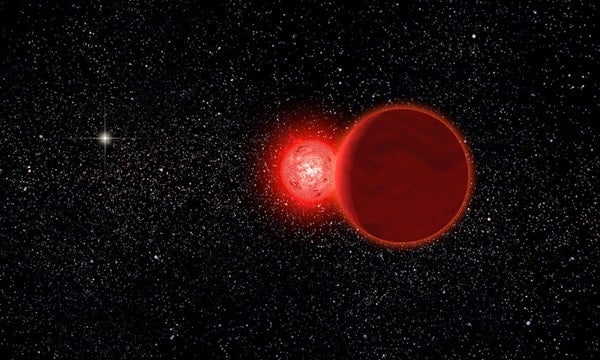
Every 50,000 years or so, a nomadic star passes near our solar system. Most brush by without incident. But, every once in a while, one comes so close that it gains a prominent place in Earth’s night sky, as well as knocks distant comets loose from their orbits.
The most famous of these stellar interlopers is called Scholz’s Star. This small binary star system was discovered in 2013. Its orbital path indicated that, about 70,000 years ago, it passed through the Oort Cloud, the extended sphere of icy bodies that surrounds the fringes of our solar system. Some astronomers even think Scholz’s Star could have sent some of these objects tumbling into the inner solar system when it passed.
However, Scholz’s Star is relatively small and rapidly moving, which should have minimized its effect on the solar system. But in recent years, scientists have been finding that these kinds of encounters happen far more often than once expected. Scholz’s Star wasn’t the first flyby, and it won’t be the last. In fact, we’re on track for a much more dramatic close encounter in the not-too-distant future.
“[Scholz’s Star] probably didn’t have a huge impact, but there should be many more stars that have passed through that are more massive,” astronomer Eric Mamajek of NASA’s Jet Propulsion Laboratory, whose 2015 paper in Astrophysical Journal Letters put Scholz’s Star on the map, tell Astronomy.
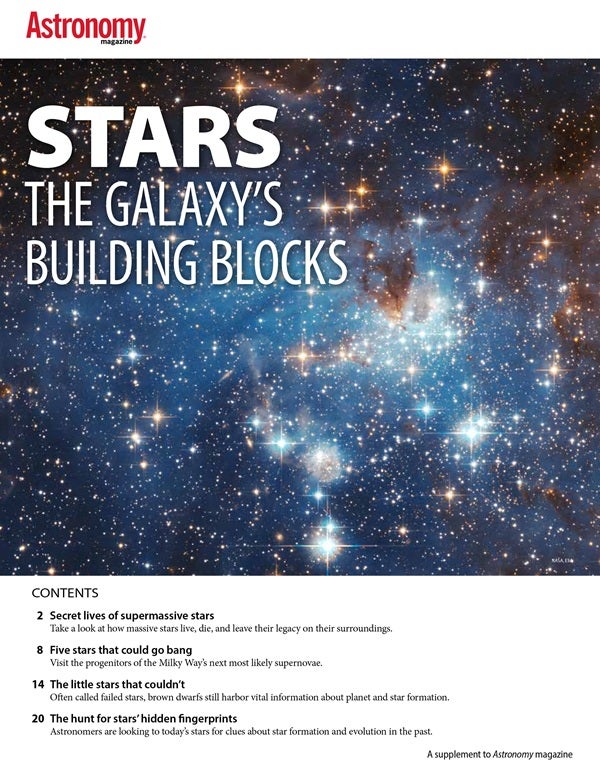
What we can learn from the life cycles of stars? Astronomy ’s free downloadable eBook, Stars: The galaxy’s building blocks contains everything you need to know about how stars live, die, and change their galactic homes over time.
The discovery of ‘Scholz’s Star
Around Christmas 2013, Mamajek was visiting a friend and fellow astronomer, Valentin Ivanov, at the offices of the European Southern Observatory in Santiago, Chile. While the two chatted, Ivanov was looking at recent observations of a star cataloged as WISE J072003.20–084651.2.
The star caught Mamajek’s interest because it was just about 20 light-years away, but astronomers hadn’t noticed it thanks to its dim nature and tiny apparent movement (or proper motion) across our night sky.
To him, those two things were a clue. Since it didn’t appear to be moving much side to side, the star was likely moving toward us or away from us at a breathtaking pace. As the astronomers continued talking, Ivanov measured the star’s radial velocity to learn how quickly it was moving toward or away from our Sun. Soon, they had their answer.
“Within five or 10 minutes, we had the initial results that this thing came within a parsec [3.26 light-years] of the Sun,” Mamajek says. “It was screaming through the solar neighborhood.”
The two astronomers and their colleagues would eventually show that it passed even closer than that. In fact, it passed closer to our Sun than any other known star. This status prompted them to name the cosmic trespasser after its initial discoverer, an astronomer named Ralf-Dieter Scholz, who’s devoted significant time to finding nearby stars.

All the other passing suns
Mamajek has since moved on from studying Scholz’s Star. But in the meantime, other astronomers have also taken up the work. And, thanks to a European Space Agency satellite called Gaia, which is built to map the precise locations and movements of over a billion stars, we now know about other close encounters.
In 2018, a team of researchers led by Coryn Bailer-Jones of the Max Planck Institute for Astronomy in Germany, used Gaia data to plot our Sun’s future meet-ups with other stars. They discovered nearly 700 stars that will pass within 15 light-years of our solar system over just the next 15 million years. However, the vast majority of close encounters have yet to be discovered, the team suggests. But they suspect roughly 20 stars should pass within just a couple light-years of us every million years.
However, “space is big,” Mamajek points out. “Statistically, most of those stars would pass the outer edge of our solar system.” That means encounters like the one with Scholz’s Star are common, but only a few are close enough to actually dislodge a significant number of comets,
Nonetheless, a few stars should still come surprisingly close. And if a large, slow-moving star did pass through the edge of the Oort Cloud, it could really shake up the solar system.
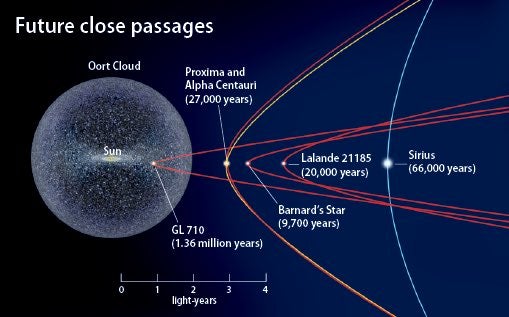
The ‘strongest disrupting encounter’ in history
A massive star steamrolling through the outer solar system is exactly what Gaia data show will happen less than 1.4 million years from now, according to a 2016 study. A star called Gliese 710 will pass within 10,000 astronomical units — 1 AU is equal to the average Earth-Sun distance of 93 million miles. That’s well within the outer edge of the Oort Cloud.
At half the mass of the Sun, Gliese 710 is much larger than Scholz’s Star, which is just 15 percent the mass of the Sun. This means Gliese 710’s hulking gravity could potentially wreak havoc on the orbits of icy bodies in the Oort Cloud. And while Scholz’s Star was so tiny it would have been barely visible in the night sky — if at all — Gliese 710 is larger than our current closest neighbor, Proxima Centauri. So when Gliese 710 reaches its closest point to Earth, it will burn as a brilliant orange orb that will outshine every other star in our night sky.
This event could be “the strongest disrupting encounter in the future and history of the solar system,” the authors wrote in their paper , published in the journal Astronomy & Astrophysics .
Fortunately, the inner solar system is a relatively tiny target, and even if Gliese 710 does send comets flying our way, it would take millions of additional years for these icy bodies to reach us. That should give any surviving future humans plenty of time to take action.
And in the meantime, they can enjoy watching what may be one of the closest stellar flybys in the history of our solar system.

A weird, repeating radio signal from space stumps astronomers
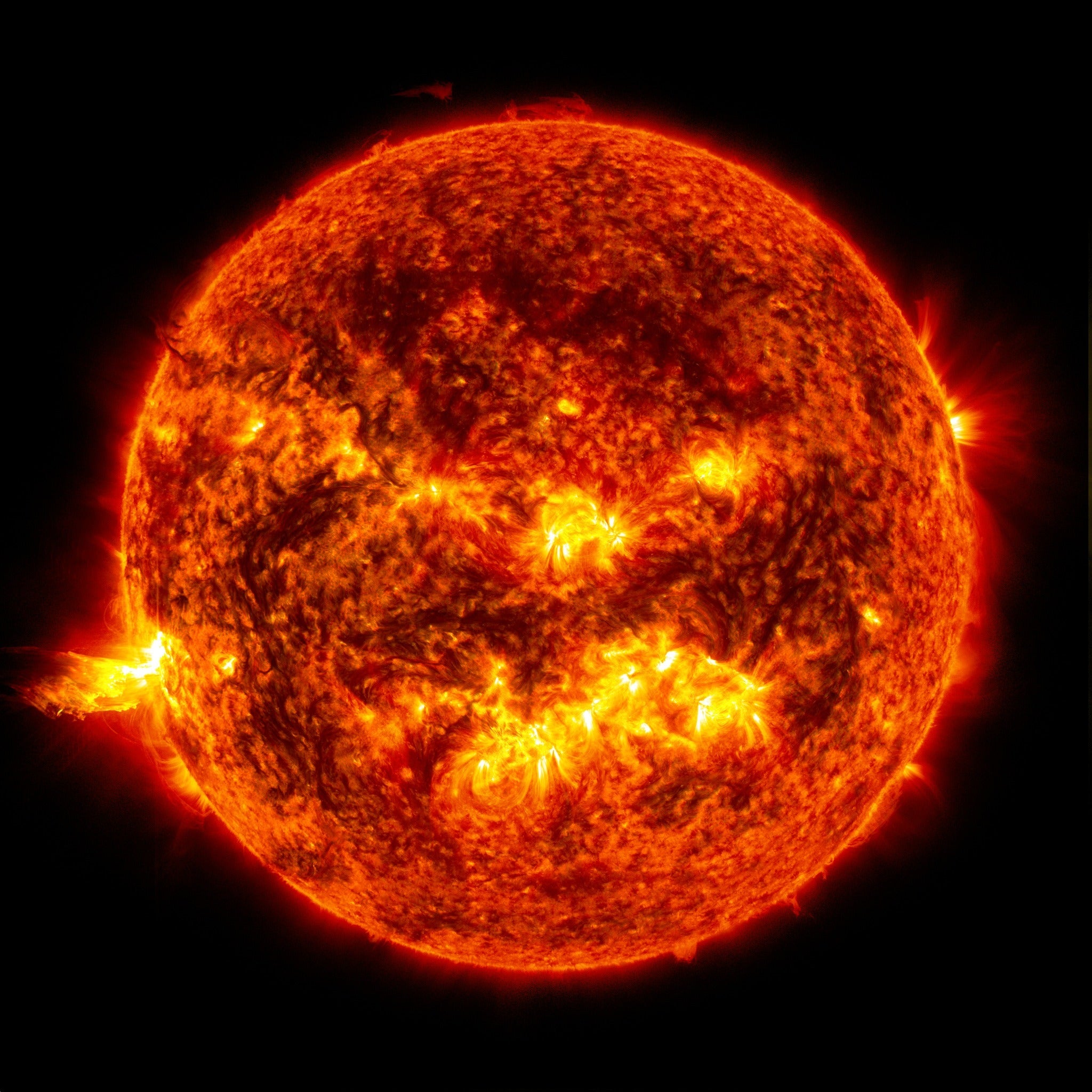
The Sun’s magnetic field is generated surprisingly close to its surface, new study suggests

How many stars die in the Milky Way each year?

The largest digital camera ever made for astronomy is done
Yes, an exploding star close to earth would make for a very bad day.

More than a few nearby stars show signs they ate young planets

How do globular clusters remain intact for so long?

How to see T Coronae Borealis, the ‘brightest nova of the generation’

What are the smallest brown dwarfs? The JWST has a new answer
Spot These Wandering Stars In June's Night Sky

This week, three bright planets continue to vie for our attention in the evening sky: Silvery Jupiter appears in the west-southwest, while orange-yellow Mars and yellow Saturn glow brightly, low in the southeast. Stargazers see the planets move across the sky throughout the year, but even the unmoving stars behind them aren't as steadfast as they appear.
"Wandering stars" is a term usually applied to the planets. When ancient stargazers created the original constellations thousands of years ago, they called the stars that formed those constellations "fixed," because they appeared rooted in their relative positions to each other. But the planets were different, because they seemingly had the freedom to wander at will among the stars.
In fact, the stars are far from fixed; if we wait around long enough, we will see them change their positions, too. One fine example can be found high in the southern sky during the mid-to-late evening hours: the brilliant yellow-orange jewel known as Arcturus , which is the brightest star in the kite-shaped constellation of Boötes, the Herdsman. It's about 37 light-years away and is 180 times more luminous than Earth's sun. [ Constellations of the Night Sky: Famous Star Patterns Explained (Gallery) ]
Runaway Star
Arcturus appears to shift its "fixed" position in the sky much more rapidly than most of the other bright stars (the sole exception is Alpha Centauri). Arcturus appears to whiz through space at a speed of some 90 miles per second in the direction of the constellation Virgo. From Earth, it appears to move toward Virgo by about 1 degree (which is about twice the apparent width of a full moon) over a time span of about 1,500 years. We are thus very fortunate to live at a time when the distance separating Arcturus and Earth's solar system is nearly at its minimum. It will continue to approach the Earth for several thousand years more, but then it will pass us as it continues to move toward Virgo, and its distance from us will then begin to steadily increase. Computations show that in approximately 500,000 years, it will probably have moved away from the Earth as far as 800 light-years and likely will have faded completely from naked-eye visibility.

Edmund Halley was the first to discover the star's motion back in 1718. Some believe, however, that Halley was not the first to notice the rapid motion of Arcturus.
A good friend of mine, George Lovi, who passed away in 1993, wrote the column "Ramblings" for "Sky & Telescope" magazine for over two decades . He cites an intriguing statement in Job 38:32:
" ... or canst thou guide Arcturus with his sons?"
Get the Space.com Newsletter
Breaking space news, the latest updates on rocket launches, skywatching events and more!
It was always George's contention that this Biblical quote did not refer to Arcturus' travels across the night sky, but rather to its proper motion, which during the millennia spanning ancient times was certainly great enough for careful observers to notice. "Alas," he noted, "Here is yet another mystery from those mists of antiquity."
Subtle differences
Although all the stars are moving rapidly helter-skelter through space at varying speeds that are measured in miles per second, their movements are not apparent to the human eye, even over a person's lifetime. However, if it were possible for someone to live for, say, 500 years, there would be some subtle differences. During the time of Columbus, for instance, the bright star Altair in Aquila, the Eagle — one of the three stars that make up the Summer Triangle — formed a much straighter line with its two dimmer flanking stars, Alshain and Tarazed.
Alpha Centauri , which I mentioned earlier, is at present the sun's nearest stellar neighbor at just 4.3 light-years away. Over the next 28,000 years, its distance from Earth will decrease to just 3.1 light years, and it will shift noticeably northward, becoming visible — albeit low in the southern sky — for midnorthern latitudes. The star will be nearly twice as bright as it appears now. And by the year A.D. 50,000, it will cross into the northern half of the sky.
But the movement of the stars through space is not the only thing that causes their positions to shift. Because the Earth is an oblate spheroid — slightly flattened at the poles and a bit thicker around the equator — the planet's axis wobbles in a fashion somewhat similar to a slowing-down top. While the tilt of Earth's axis remains the same (23.5 degrees), its wobbling motion traces a circle. Stars on or near this circle become the North Star, successively, over the course of about 25,700 years (the exact value is still not known). This time span is called the Platonic Year. [ Saturn at Opposition, Jupiter's Moons and a Comet In June 2016 Skywatching ]
Different stars for different seasons
Earth's current North Star, Polaris, remains in very nearly the same spot in the sky all year round, while the other stars circle around it. Only the apparent width of about 1.5 full moons separates Polaris from the pivot point directly north, around which the stars go daily — the spot in the sky to which the Earth's axis is pointing.
But, as discussed earlier, the wobble of the Earth's axis (called precession) causes the celestial pole to shift as the centuries go by. Polaris is actually still drawing closer to the pole and, on March 24, 2100, it will be as close to it as it will ever come, just 27.15 arc-minutes (slightly less than the moon's apparent diameter). And different stars have become the North Star at different times. The brightest star in the bowl of the Little Dipper, Kochab, was the North Star at the time of Plato, around 400 B.C. In A. D. 10,000, the first-magnitude star Deneb in Cygnus, the Swan, will be near enough to the pole to be considered as the North Star, followed 4,000 years later by the brilliant blue-white star Vega in Lyra, the Lyre.
The four points in the sky marking the start of the four seasons will shift as well over time. At the moment, for instance, summer begins with the sun shining in the constellation of Taurus and winter begins with the sun in Sagittarius. But 12,000 years from now, the situation will be reversed: summer will start with the sun in Sagittarius and winter will begin with the sun in Taurus.
This doesn't mean that summer will begin in December and winter will begin in June — the start of each season will still occur in the same months that they do now. But what this does mean is that when Vega is Earth's North Star in A.D. 14,000, summer constellations that are currently low or invisible from midnorthern latitudes, such as Sagittarius, Scorpius and the Southern Cross, will rise high into the sky during December and January. And the bright stars that currently adorn the winter sky, Orion, Taurus and Gemini, will be very low or partly invisible during June and July. In fact, Sirius, the brightest star, will never rise above the horizon for northerners and will be observable only from the tropics and points south of the equator.
Joe Rao serves as an instructor and guest lecturer at New York's Hayden Planetarium. He writes about astronomy for Natural History magazine, the Farmer's Almanac and other publications, and he is also an on-camera meteorologist for News 12 Westchester, New York. Follow us @Spacedotcom , Facebook and Google+ . Original article on Space.com .
Join our Space Forums to keep talking space on the latest missions, night sky and more! And if you have a news tip, correction or comment, let us know at: [email protected].
Joe Rao is Space.com's skywatching columnist, as well as a veteran meteorologist and eclipse chaser who also serves as an instructor and guest lecturer at New York's Hayden Planetarium. He writes about astronomy for Natural History magazine, the Farmers' Almanac and other publications. Joe is an 8-time Emmy-nominated meteorologist who served the Putnam Valley region of New York for over 21 years. You can find him on Twitter and YouTube tracking lunar and solar eclipses, meteor showers and more. To find out Joe's latest project, visit him on Twitter.
Save $400 on Unistellar smart binoculars: Early bird deal
Father's Day telescope deals: Save $400 on Unistellar smart telescopes
At long last: Europe's new Ariane 6 rocket set to debut on July 9
Most Popular
- 2 This Week In Space podcast: Episode 114 — Starliners & Starships
- 3 SpaceX wants to build 1 Starship megarocket a day with new Starfactory
- 4 Arrokoth the 'space snowman' probably tastes like sweet soap
- 5 Apollo 8 astronaut Bill Anders, who captured 'Earthrise,' killed in plane crash

Why planets are referred to as wandering stars in astronomy
Our home is located on Earth, which is one of the eight major planets within our solar system. Apart from Earth, the Sun’s extensive family consists of Mercury, Venus, Mars, Jupiter, Saturn, Uranus, and Neptune. These planets are relatively smaller in size compared to the Sun, and they orbit around it. They are visible to us because they reflect some of the sunlight that reaches them. This brings up the question, why are planets called wandering stars? (Nowadays, they are referred to as “wandering luminaries.”) What is the connection between planets and stars, and why do they wander?
Stars and Planets: Similar but Different
It’s evident that stars and planets belong to distinct categories. Stars are enormous, gas-filled celestial bodies that emit light due to their extreme heat. On the other hand, planets, such as those found in our solar system, do not emit light as they are too cold for that (although they can be detected in infrared light!). Additionally, planets can have different compositions, ranging from gas giants like Jupiter to rocky planets like Mars and Earth, and even predominantly metallic ones like Mercury. Despite not glowing like stars, humans have been aware of the existence of planets for thousands of years.
But why is this so? It’s because planets reflect sunlight, making them visible to us in the sky .
Until 500 years ago, people had little knowledge about the nature of planets. There was a lack of understanding regarding their size, composition, and even their distance from Earth. However, observers could still identify what appeared to be planets in the night sky. Ancient astronomers closely observed these celestial bodies and documented their behavior.
So, what do planets look like when observed without the aid of a telescope? They resemble ordinary stars, to the point that individuals not particularly interested in astronomy would struggle to differentiate them. For instance, Saturn would appear indistinguishable from other stars to the naked eye. Although planets like Jupiter or Venus are noticeably brighter than typical stars, it still required additional knowledge to recognize them as planets rather than extremely luminous stars.
Stars that Wander: Planets
The ancient people possessed the wisdom to differentiate between planets and stars, recognizing that planets were not fixed like the stars in the sky.
While planets may appear similar to stars, they possess a remarkable quality – they are constantly in motion against the backdrop of the static stars.
The stars themselves remain stationary, unless we consider the daily movement of the stars from east (where they rise) to west (where they set). The planets, along with the Moon and the Sun, also experience this daily motion. Nowadays, we understand that this universal east-west movement of the sky is caused by the Earth rotating on its axis. However, no matter how much you observe the sky with the naked eye, you cannot detect any additional motion in the stars. Our ancient ancestors were well aware of the fact that the stars do not change their position. This is why the depictions of constellations have remained virtually unchanged for thousands of years.
It is of utmost significance that the celestial bodies exhibit distinct patterns of motion: certain planets traverse their orbits at a rapid pace, while others move at a more leisurely pace. Notably, there are two planets, Mercury and Venus, that consistently appear in close proximity to the Sun in the sky, whereas three other planets, namely Mars, Jupiter, and Saturn, can be observed on the opposite side of the sky, far away from the Sun.
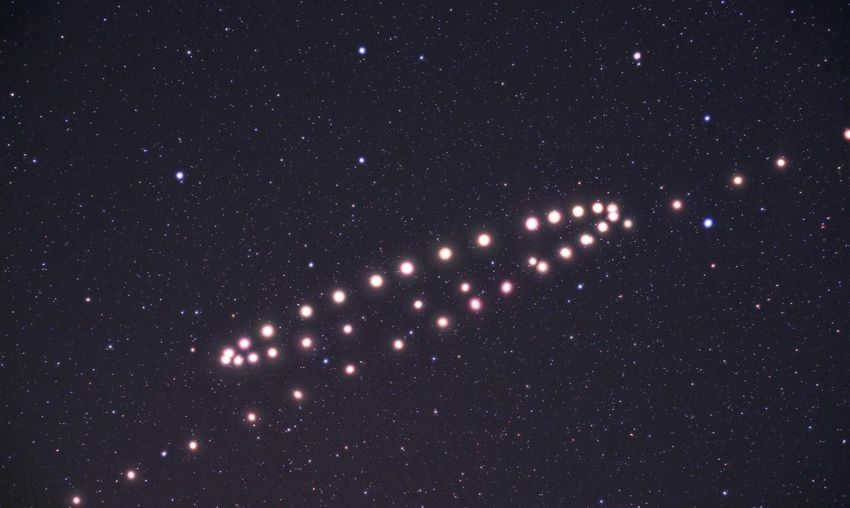
The retrograde motion of Mars occurs when it appears to move backward against the backdrop of stars. This composite image is created by stitching together multiple consecutive images of Mars captured during its opposition phase. Each subsequent image was taken one week after the previous one. Photo credit: Cenk E. Tezel, Tunç Tezel (TWAN)/APOD
Normally, planets traverse the sky from right to left (i.e., from west to east) relative to the stars. However, there are times when they pause and reverse their direction. They then pause again and resume their eastward motion, creating enigmatic loops. One common characteristic of all planets is that they exclusively navigate through the zodiacal constellations, just like the Sun and the Moon.
If the planets were to move in an organized manner, they would likely be referred to as “moving luminaries” or something similar. However, that is not the case, as planets are known as wandering stars! The reason for this is the complex and irregular motion of planets against the backdrop of ordinary stars, which led people to dub them as “wanderers” or “wandering” luminaries. Interestingly, the term “planet” itself translates from ancient Greek as “wandering”.
Here is an illustration that demonstrates why planets are called wandering stars. This animation showcases three bright stars positioned near the horizon: Saturn, Jupiter, and the reddish Mars. Each subsequent frame corresponds to the following day, with the full length representing four weeks. It is evident from the animation how Mars swiftly moves in relation to the stars and the two other planets. Figure: Stellarium/Evgeny Zolotavkin
The principles governing the movement of celestial bodies
Ancient astronomers were perplexed by the peculiar motion of the planets. It appeared to be highly unpredictable and almost chaotic, yet there was an underlying pattern to these movements. Could it be that the planets adhered to certain laws? Was there a concealed order dictating their motion?
The geocentric system of the world
For countless centuries, astronomers have dedicated themselves to uncovering the laws that govern the celestial bodies. Among the ancient Greek scholars, a theory emerged that elegantly explained the motion of the planets in the heavens. This theory not only provided accurate predictions of their future positions, but also positioned Earth as the center of the universe. According to this theory, known as the geocentric system, the Sun, Moon, planets, and stars all orbited around Earth in perfect circular paths.
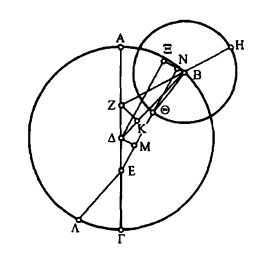
Ancient astronomers employed intricate geometric constructions to forecast the planetary positions in the celestial sphere. Source: Claudius Ptolemy. Almagest
However, as time passed, the theory ceased to yield precise predictions: minor inaccuracies accrued and the planets deviated from their projected trajectories. Consequently, the theory necessitated enhancement, but also became more convoluted. Thus, epicycles, deferents, equants, and other intricate geometric concepts were introduced to account for the planets’ loops, acceleration, and deceleration.
The revolutionary heliocentric model of the universe
After several millennia of the geocentric model dominating astronomical thought, a groundbreaking discovery was made around 500 years ago by the brilliant Polish astronomer Nicolaus Copernicus . He proposed a radical reimagining of the cosmos, placing the Sun at the center instead of Earth. According to this revolutionary heliocentric system, all planets, including Earth, orbit around the Sun. This momentous shift in perspective also redefined Earth’s status, elevating it from being merely the “center of the world,” the “firmament,” or the “dark ball,” to an actual planet. The term “heliocentric” originates from the Greek word helios, meaning the sun.
After another fifty years, Johannes Kepler, a German mathematician, formulated Kepler’s famous three laws. Specifically, the first law states that instead of moving in circles, the planets move on ellipses with the Sun at one of the focal points. It didn’t take long for Sir Isaac Newton to derive Kepler’s laws from the law of gravitation.
Thanks to the Copernican world system and Kepler’s laws, it became possible to predict the positions of the planets in the sky for centuries, and even millennia, to come. Equally important is the fact that these discoveries caused a true revolution in humanity’s conception of the universe’s structure.
Put simply, astronomy is the scientific field dedicated to researching the sky and celestial bodies. In ancient times, astronomers observed everything that occurred in the sky above the clouds – the sun and stars, the moon and planets, the northern lights and meteors, which are commonly known as “shooting stars.” Astronomers also paid attention to rare cosmic events like supernovae and the formation of new stars, as well as the appearance of comets with tails. Additionally, atmospheric phenomena like halos that occasionally encircle the moon or sun fell within the purview of astronomers.
In the present day, astronomers focus solely on studying objects and physical processes that exist beyond Earth’s dense atmosphere. They investigate cosmic bodies and the universe as a whole. In essence, astronomers explore the structure, origin, and development of celestial bodies.
Astronomers’ hard work has not been in vain. In the last few centuries, they have constructed a remarkable, awe-inspiring, and captivating depiction of the universe.

A collection of galaxies in the constellation of Veronica’s Hair. Image: NASA/Hubble
It transpires that we inhabit an immense, ever-expanding universe that is approximately fourteen billion years old. Our Universe is so vast that even light, which moves faster than anything else, takes billions of years to reach its far-flung corners (due to the Universe’s expansion, it will never be able to traverse it in the usual manner). The universe houses trillions of galaxies, each composed of billions upon billions of stars. Galaxies can be likened to islands of stars, separated by vast, almost entirely starless regions.
We are located within one of the many galaxies in the universe, known as the Milky Way . The Milky Way consists of approximately 400 billion stars, including our very own Sun. Every star visible in the night sky belongs to the Milky Way.
The Sun is classified as an average star – not too large or small, bright or dim, or heavy or light. It falls somewhere in the middle among the vast assortment of stars.
Surrounding the Sun are eight major planets, several dwarf planets, countless asteroids, comets, and numerous smaller celestial bodies such as rocks and meteoroids. Collectively, these entities form the solar system.
Not too long ago, the existence of similar systems around other stars was uncertain. However, over the past three decades, astronomers have developed techniques to detect and investigate such systems. It has been discovered that nearly every star within our galaxy possesses at least one planet. It won’t be long before scientists are able to distinguish Earth-like planets that bear resemblance to our own planet.
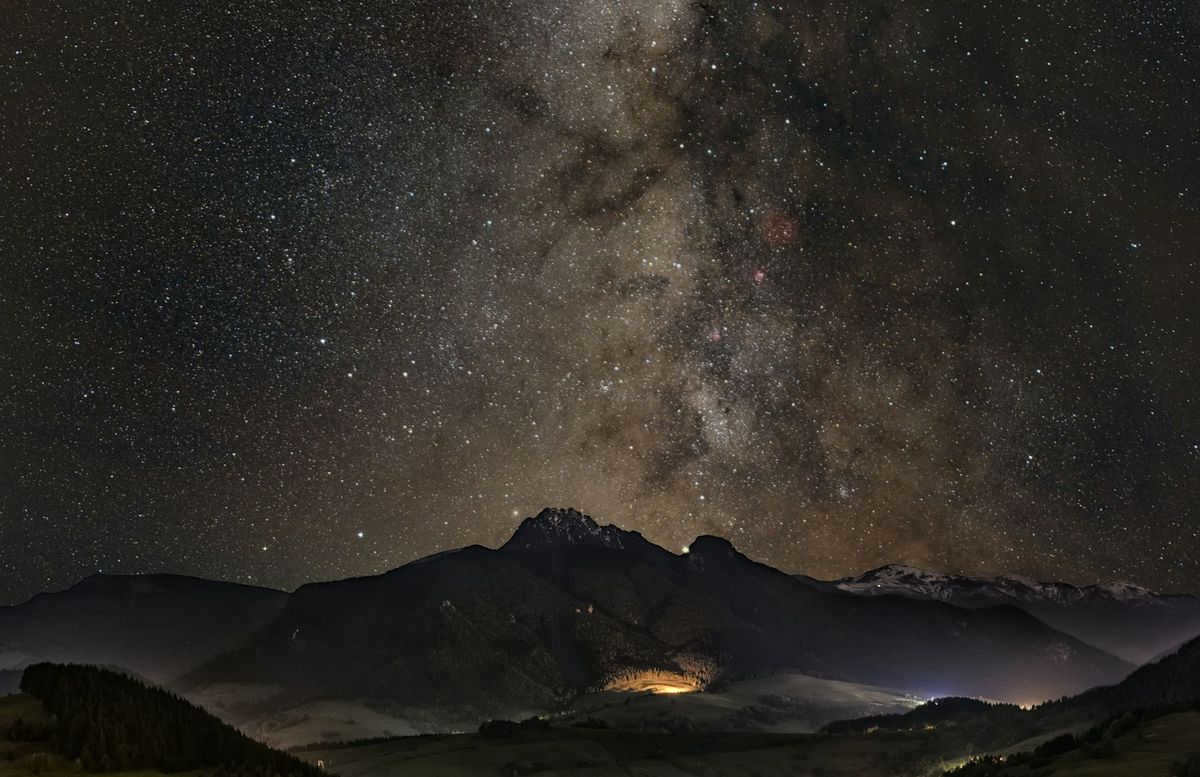
Over the mountains in Slovakia, the Milky Way can be seen. Photo credit goes to Vaclav Hyza.
Currently, there exist numerous captivating books that showcase stunning color illustrations, providing detailed descriptions of the planets within our solar system, stars, the structure of the Milky Way, and other galaxies. Additionally, these books delve into the history and evolution of the entire universe. However, what is often left unmentioned is the fact that a vast number of these magnificent celestial objects are visible to the naked eye, should one wish to partake in such observation. In certain instances, a small telescope or even binoculars may be required, while in other cases, one’s eyes alone may suffice in witnessing various astronomical phenomena.
Astronomy: A Fascinating Hobby
Astronomy, often considered an exact science akin to math or physics, requires a deep understanding of physics and sometimes even chemistry, as well as specialized mathematical tools and programming skills. Furthermore, it involves a continuous process of refining existing knowledge and diligently searching for the unknown.
While astronomers themselves view their profession as highly romantic, many individuals find the abundance of formulas and calculations daunting and uninteresting.
If you happen to be one of those people, I want to assure you that you do not need to possess a mathematical mind in order to engage in astronomy and appreciate the breathtaking beauty of the night sky!
So, what do you require to get started?
To begin with, all you really need is an unobstructed and, if possible, dimly lit sky. (Finding such a sky is increasingly challenging in modern times!) If you derive pleasure from gazing at the celestial bodies, including stars, constellations, meteors, the moon, and the planets’ motion, you might want to delve deeper into the vast expanse of the night sky. In that case, you have the option to select either a pair of binoculars or an affordable telescope for your overall observations.
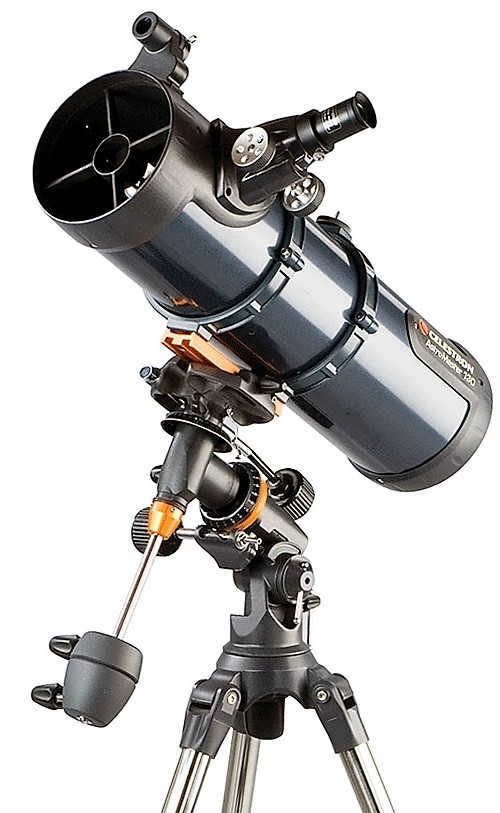
The Celestron Astromaster 130 eq is an affordable amateur telescope designed for observing the stars using an equatorial mount (tripod). Source: Rother Valley Optics
As you continue your stargazing journey, you will discover certain objects or types of observations that you prefer over others. When this happens, it may be time to invest in specialized equipment that is more expensive but offers better quality.
Perhaps the resources you currently possess will suffice, and you will derive pleasure from leisurely strolls beneath the celestial bodies. Alternatively, there may come a time when you realize that observing the cosmos is simply not your cup of tea, and you move on. Similar to any pastime, amateur astronomy primarily offers amusement and relaxation, with everything else following suit. If you fail to experience positive emotions while gazing upon the starry expanse, then it is best to abstain.
By the way, if I were in your shoes, I would not underestimate the intellectual aspect of astronomical observations. Were you aware that contemporary astronomy enthusiasts frequently make astounding discoveries? They stumble upon uncharted celestial entities such as asteroids and comets, variable stars, supernovae, newborn stars, and even previously unknown nebulae!
You have the opportunity to personally make a groundbreaking discovery in the field of astronomy! (Of course, this won’t happen right away, but after gaining some basic experience in observing celestial phenomena.) This is no laughing matter! With a plethora of state-of-the-art telescopes now available to professional astronomers, the possibilities are endless! The reality is that large telescopes are primarily utilized for observing specific celestial objects – nobody would use the Hubble Space Telescope to search for new comets or closely monitor Jupiter. That’s precisely why ambitious amateur astronomers have ample opportunities to contribute.
If you’re interested in learning more about the endeavors of amateur astronomers, you can find additional information here.
Astronomy does not have the ability to forecast or determine a person’s destiny or personality based on the stars. This is the realm of astrology. Astronomers often take offense when they are mistakenly referred to as astrologers. In reality, astronomers firmly believe that it is impossible to predict the future of individuals or the world solely based on the movements of celestial bodies.
However, there exists a correlation between astronomy and astrology. In earlier times, when the scientific method had not yet been established, the distinction between astronomy and astrology was not well-defined. In reality, the advancement of astronomy in ancient times was driven not only by practical necessities like the calendar, but also by the astrological desires of those in power. Seeking knowledge of the future, monarchs and rulers provided patronage to astrologers, thereby indirectly fostering the progress of astronomy, since without it, the prediction of the positions of celestial bodies in the future would be unattainable.
How to get started with studying astronomy?
If you have an interest in the night sky but lack knowledge about astronomy, it can be challenging to begin observing. Even when reading popular online articles, it is often difficult to distinguish between planets and stars. What are the various phases of the moon? What are faint stars? What is a conjunction of planets? And what do terms like brilliance, brightness, and luminosity mean?
There are moments when the objects studied in astronomy can be unclear. For instance, you might not understand the differences between planets and stars or what galaxies are.
When faced with a plethora of unfamiliar jargon, confusion is bound to follow. That’s why it’s best to start by delving into popular astronomy books or engaging with astronomy forums, where you can discover a wealth of straightforward and valuable information. Alternatively, you can peruse the introductory articles available on this website.
With the aim of aiding astronomy novices in catching up, I trust that this article will prove beneficial.
In the vast expanse of space, there may exist countless planets unattached to a central star. Termed nomad planets (also referred to as floating, interstellar, or orphan planets), astronomers and enthusiasts of science fiction have long been captivated by the possibility of their existence.
These planets can emerge after being expelled from their orbits between solar systems, or they can form when an interstellar cloud collapses. In any case, they eventually traverse the Milky Way. Can Earth also transform into such a planet? Can a rogue planet pass through our solar system? The discovery of rogue planets compels us to reconsider some fundamental concepts, from the formation of planets to their placement in orbit.
Simultaneously, these wanderers have made us realize that we are not as solitary as we previously believed on a planetary scale. In reality, we may have numerous additional contenders for habitable planets besides exoplanets. Indeed, nomadic planets could potentially harbor life.
Frightening aspects of planetary nomads
The concept of nomadic planets was first brought to the public’s attention in the middle of 2011, thanks to a research conducted by Takahiro Sumi, an astrophysicist from Osaka University in Japan. Sumi and his team utilized gravitational microlensing, a method commonly used to identify exoplanets across the galaxy. By observing the distortion of light from a background source, such as a star, caused by an object passing between the source and Earth, they were able to temporarily magnify the light. In their study, Sumi and his colleagues discovered 10 planets with a mass similar to Jupiter that appeared to be moving without following a recognizable orbit.
As previously mentioned, the hypothesis suggests that these objects might have originated from the same gas and dust clouds that give rise to stars, or alternatively, they could have been captured by solar systems and removed from their original orbits. Consequently, solar systems have the potential to attract and retain nomadic planets, resulting in their placement in wide orbits. It’s entirely plausible that our solar system once harbored a greater number of planets than our current knowledge encompasses.
There exists the possibility that Earth could come into contact with such a rogue planet, albeit the likelihood is small. However, our galaxy is teeming with smaller, more dispersed threats that pose an equal amount of danger. The chances of our demise at the hands of a comet or an asteroid measuring a few kilometers in diameter are significantly higher.
Sumi’s initial research indicated that every star in our galaxy may possess two or three wandering planets. However, a subsequent investigation conducted by the Kavli Institute at Stanford, less than a year later, revised this estimation, suggesting that each star in the Milky Way could potentially harbor up to 100,000 nomadic planets.
Several factors contribute to this hypothesis:
- The gravitational influence exerted by the Milky Way;
- The availability of matter necessary for the formation of nomadic planets;
- The manner in which matter organizes itself within a planet, ranging in size from Pluto to Jupiter.
If proven accurate, this theory raises intriguing questions about the formation of planets and the significance of nomadic planets within our galaxy. However, for now, let us focus on the information at hand and explore the various possibilities that lie ahead.
What is the origin of wandering planets?
Let’s explore the possible sources of drifting planets. Much of the current understanding of these celestial bodies is derived from studying our own solar system and other young solar systems in our galaxy.
It is important to note that wandering planets can vary in terms of size and composition. Sumi’s research initially revealed Jupiter-class planets as nomadic entities, suggesting that smaller planets with less mass could also be expelled from their original systems. In fact, smaller planets may be more likely to be ejected from a developing planetary system. On the other hand, larger planets may naturally emerge as outcasts from star-forming clusters.
The concept of ejection is based on the notion that nomadic planets experience gravitational forces from various sources, including other stars and neighboring planets. To illustrate how this process could occur, scientists analyze Jupiter-like planets in different solar systems, which maintain orbits in close proximity to their respective suns. Now, envision a scenario where our own Jupiter gradually reduces its orbit and approaches the sun. With a mass over 300 times greater than that of Earth, Jupiter possesses a substantial gravitational field.
Another suggestion suggests that if a star goes supernova, a planet may be expelled from the solar system. Naturally, some planets would be obliterated in a violent explosion, but those that survive would be propelled outward into space, no longer bound to their original star.
Once outside the solar system, a wandering planet could be influenced by various gravitational forces. Computational simulations have indicated that if a planet is ejected early in the formation of a star cluster, it is likely to be drawn into a wide, unrestricted orbit around a neighboring star. The larger the star, the greater the chance of capturing a wandering planet. Computer models also suggest that it is entirely possible for a wandering planet to be ensnared by the gravitational pull of black holes.
There are other options that involve planets orbiting the Milky Way galaxy in a wide trajectory. This implies that they are still part of the galactic dance floor and moving along with the crowd, but they are not traveling in a pack. Ultimately, it is completely plausible for two wandering planets to encounter each other and create their own binary system – simply a pair of solitary planets engaging in a romantic dance in the vastness of space.
What are the potential conditions on a roaming planet?
We cannot be certain about this until we conduct research on roaming planets. However, there are certain assumptions that can be made based on our observations of planets, dwarf planets, and moons in our own solar system and beyond. Let’s explore some of the possible characteristics of roaming planets.
Presence of day and night? Unlikely. As we already understand, our day and night cycles are determined by our proximity to the sun. Without a nearby sun, traditional day and night cycles would not exist. Consequently, the process of photosynthesis can probably be ruled out.
Can a nomadic planet have an atmosphere? Absolutely, a nomadic planet has the potential to possess an atmosphere. In order for a planet to sustain an atmosphere, it must possess sufficient gravitational force to retain gases and maintain low temperatures to prevent the gases from dissipating and evaporating into space. Take, for example, the farthest reaches of our solar system where even the diminutive Pluto manages to preserve its own atmosphere. Therefore, it is plausible for a nomadic planet to uphold an atmosphere, although it may not meet the same criteria as Earth.
Is it possible for them to possess water? It is probable that certain nomadic planets could contain water – or, more possibly, ice. Through the utilization of unmanned stations and satellites, scientists have discovered ice on Mars and indications of ancient liquid water. Conversely, Europa, one of Jupiter’s moons in our solar system, showcases a surface comprised of ice that conceals an ocean of water. If we manage to detect water on other planets and moons within our own solar system, the probability of its existence on certain nomads is also quite high. When we consider the fact that there are approximately 100,000 nomadic planets for each star in our galaxy, the potential for such occurrences quickly multiplies.
Is it possible for life to exist on rogue planets?
Could interstellar space within our galaxy be teeming with life? It’s a possibility. Based on our understanding of other planets, it is reasonable to assume that wandering planets share some similarities. While the majority of planets we have encountered thus far cannot sustain life as we know it, the sheer number of galactic possibilities suggests that life could indeed exist. This notion has been substantiated by our findings.
In the future, it is possible for humans to inhabit a wandering planet. Proxima Centauri, which is the nearest star to our Sun, is located at a considerable distance of 4.22 light-years away from Earth. These nomadic planets could play a crucial role in human space exploration. Once we venture beyond our solar system, we could make use of these hospitable wandering planets to journey to another star system. On the other hand, given the abundance of planets, it might not even be necessary to travel to another star in order to discover new ones. This vast expanse of darkness between the sun and the stars suddenly becomes full of possibilities – and unanswered questions.
A planet derives from the ancient Greek term “wandering star”.”a wandering star”. The reason for this terminology is that the “actual” stars remain fixed in their positions, while the planets traverse the sky. The ancient Greeks, unaware that they were observing not only stars but also planets, found this behavior perplexing, hence the name.
However, unlike the ancient Greeks, we perceive the planets of the Solar System as our “home” rather than as “wandering” inhabitants of the universe. This is because each planet follows a precisely defined orbit around the Sun. When examining other planetary systems and the behavior of exoplanets, we observe a similar pattern – the planets are not really “wandering” but rather gravitationally “anchored” to their stars.
Do wandering planets truly exist, freely traversing space without a circular orbit? Absolutely, there are such celestial bodies, although it is more fitting to refer to them as rogue planets or even orphan planets. For they are truly devoid not only of companion planets, but even a star to call their own!
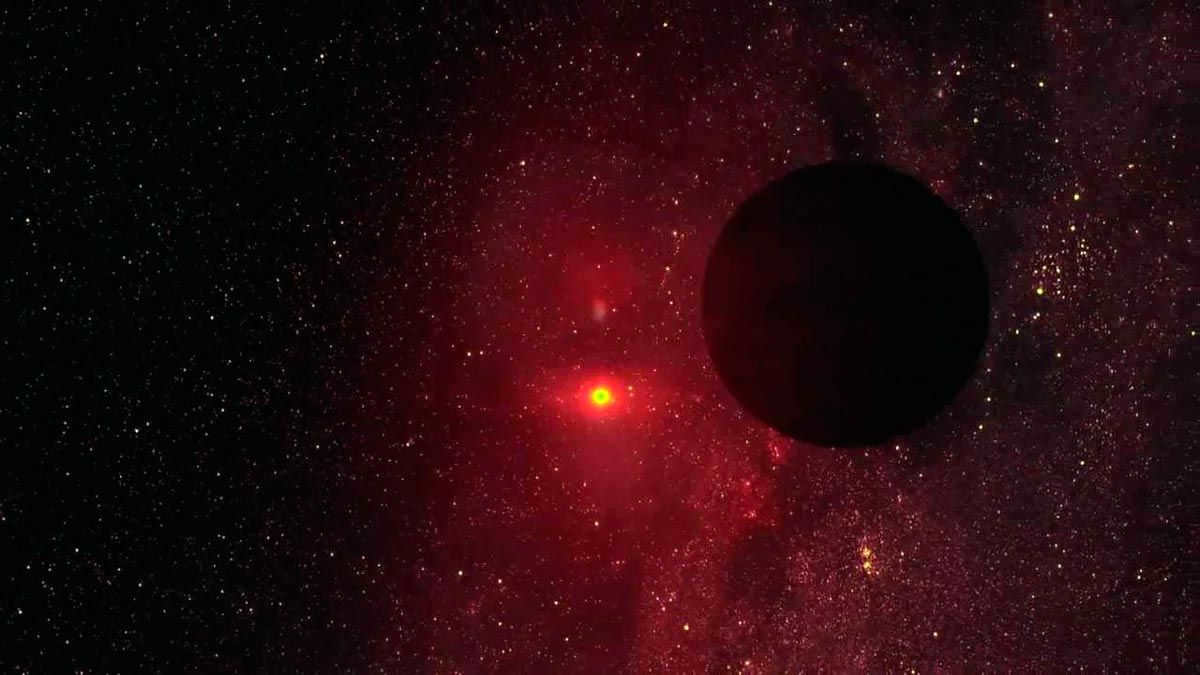
Discovering wandering planets is a challenging task due to their small size and lack of light emission. Despite these obstacles, scientists have managed to find a significant number of these elusive celestial objects. The actual number of wandering planets that exist remains a mystery and is potentially overwhelming!
A variety of terms have been used to describe wandering planets, including interstellar planets, wandering planets (commonly used abroad), planemos, free-floating planets, sunless planets, quasi-planets, or simply solitary planets.
It is estimated that the number of wandering planets in our galaxy, the Milky Way, can reach an incredibly high number, surpassing the number of visible stars by up to 100,000 times, which equates to approximately 100 billion. However, unlike stars, these planets are not easy to locate due to their lack of a star to reflect light from.
To detect these homeless planets, scientists use the method of gravitational microlensing, which involves observing the gravitational influence of a massive object passing in front of a star, even though the object itself does not emit light.
What is a wandering planet?
A wandering planet, also known as an interstellar planet, is a celestial object that shares many characteristics with a traditional planet. It is spherical in shape and has a mass similar to that of a planet. However, what sets a wandering planet apart is that it is not gravitationally bound to any star, brown dwarf, or even another planet, although it may have satellites. Unlike planets that orbit around a star or the galactic nucleus, a wandering planet drifts freely through space, unattached to any specific gravitational force.
But where do these wandering planets come from? There are two main theories:
- One possibility is that a wandering planet was once part of a planetary system but was ejected during a cosmic cataclysm. This event could have been caused by a collision with another celestial object or a gravitational disruption within the system.
- Thus, the initial choice remains more suitable in accordance with our definition. This is particularly true since a sub-brown dwarf still suggests a size comparable to that of a few Jupiter masses, signifying a star – a significantly large entity. Meanwhile, researchers, who examined over 2.6 thousand observations of rogue planets conducted between 2010 and 2015, deduced that orphan planets are normally super-Earths. In other words, they are substantial celestial bodies, but their dimensions are more or less comparable to Earth rather than Jupiter.
Is it possible for a nomadic planet to sustain life?
When we discuss a nomadic planet, our minds typically conjure up images of a colossal celestial body made up of rock and ice, similar to Ceres but much larger in scale. However, a nomadic planet doesn’t necessarily have to fit this description. According to astrophysicist Sean Raymond from the Bordeaux Astrophysics Laboratory in France, some of these rogue planets may possess dense atmospheres.
Admittedly, these wandering planets emit very little heat themselves and are not warmed by external sources. Nevertheless, massive objects like Jupiter, drifting through interstellar space, could maintain a dense atmosphere that would prevent the planet’s surface from freezing. This effect would be further enhanced by a thick hydrogen atmosphere that is opaque to infrared radiation, effectively trapping the heat generated by the planet’s core.
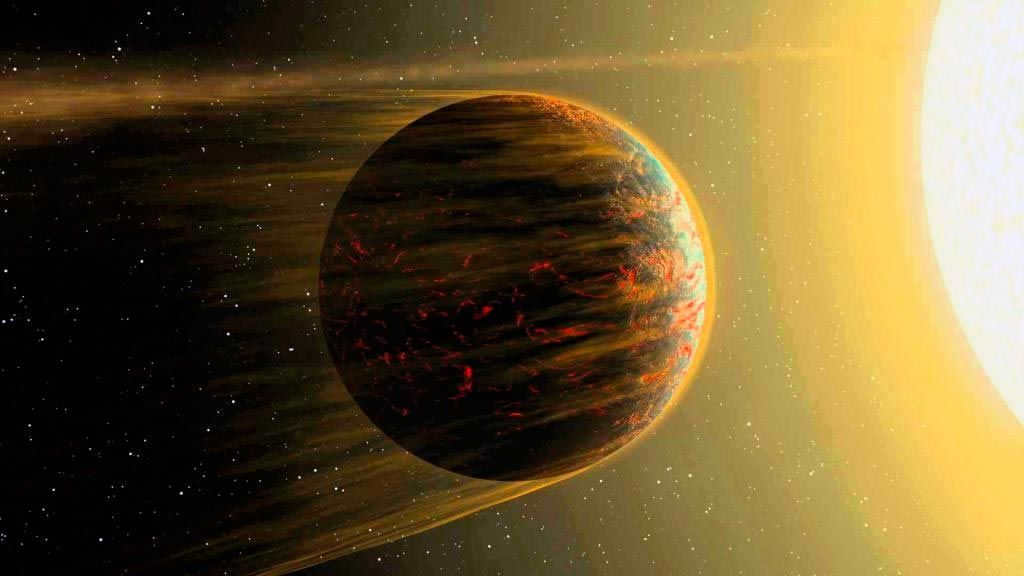
Undoubtedly, a wandering planet presents a significantly higher risk compared to a meteorite. However, the vastness of space makes it difficult to truly consider the potential for a collision with a wandering planet.
It has been estimated that a hydrogen pressure greater than one thousand atmospheres would create an almost ideal adiabatic process for an object with the same mass as the Earth. The decay energy of radioactive isotopes would be enough to maintain a positive temperature on the surface, potentially allowing for the existence of liquid water. These conditions could lead to high geological activity and the presence of underwater volcanoes, as well as a strong magnetic field that protects the planet from cosmic radiation. These factors could serve as a potential energy source for the emergence of life.
Is it possible for a planet to be wandering in the solar system?
Almost 300 years ago, the mythical fifth planet in the solar system was first sought after in relation to the Titius-Bode rule, but no evidence was found. The search for the fifth planet (nowadays referred to as the fifth, but the ninth planet) began in modern times, when it was discovered through mathematical modeling of the solar system’s planet orbits that Jupiter’s orbit must have been much closer to the Sun during the system’s formation than it is today.
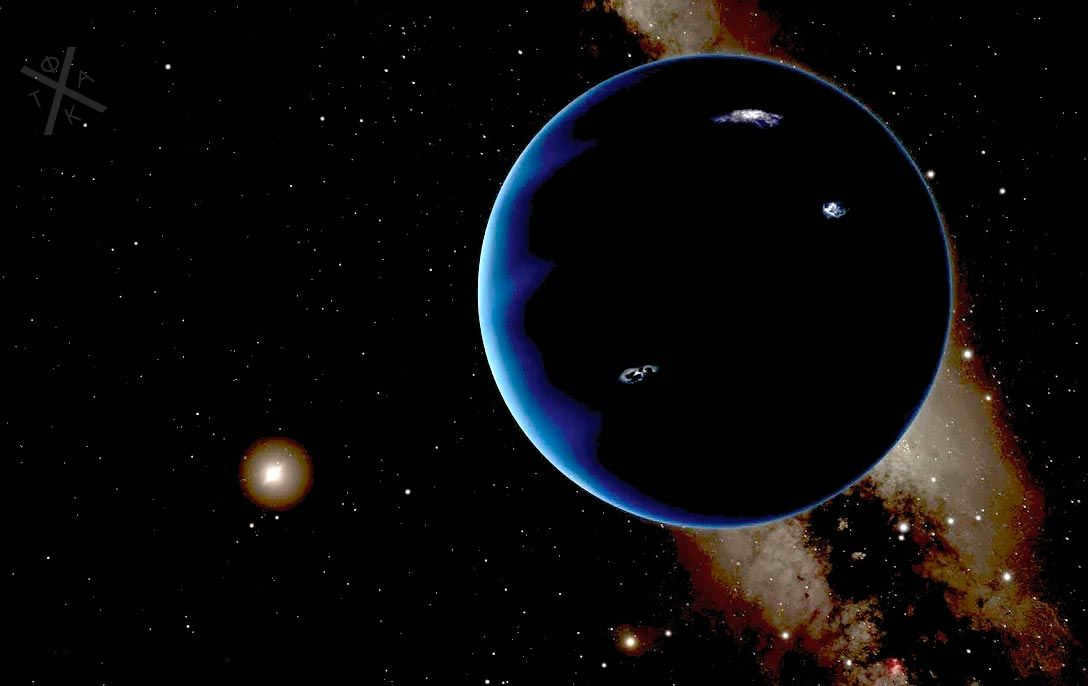
In order for Jupiter to approach closer, it would have to displace smaller celestial bodies within the system. However, this would result in potential collisions between the planets in the Earth group. Another option would be for Jupiter to “jump” closer, but in doing so, it would risk pushing Uranus or Neptune out of the system.
Both of these scenarios seem unlikely. However, if we hypothesize that during the initial formation of the solar system, there were not four, but five gigantic gas planets, then all the pieces of the puzzle fit together. It is possible that this mysterious fifth gas giant was ejected by Jupiter, either ending up in a far-off orbit or leaving the confines of the solar system altogether. Other gas giants, such as Neptune, have also experienced significant displacement. For instance, Neptune transitioned from a position in close proximity to Jupiter and Saturn to a much more distant orbit beyond Uranus, ultimately settling at the far reaches of the solar system.
The theory of the fifth planet in our solar system (2011) was formulated by astronomer David Nesvorny, who also conducted all the necessary calculations. According to Nesvorny, the likelihood of the “lost” planet having shifted to a distant orbit around the Sun is extremely low, and it is highly probable that it has permanently departed the solar system, becoming a wandering planet or an exiled planet among the realm of space travelers.
This concept traces its origins back to the ancient Greeks. They observed that while the fixed stars in the sky remain in place, the planets, due to their orbit around the Sun, appear to move in relation to the stars. Depending on their position, the planets can be found within a particular constellation, shift to another constellation, or even become invisible.
Ultimately, it was a scientist who first coined the term “lost” planet, and this is how it became widely known.)))
Our understanding of the stars and the universe is extremely limited – everything we think we know is based on mere conjecture and hypotheses. It’s possible that our current understanding is completely off the mark.
Occasionally, planets embark on their own odyssey through the enigmatic cosmos, existing in solitude without any stellar companion. What causes these nomadic planets to come into existence and what is their purpose?
We are accustomed to perceiving the Solar System as an orderly construction. Each planet dutifully revolves around its parent star, arranged in a precise pattern of ellipses and rings. Even the asteroid belt adheres to its designated orbit. The planets obediently follow their prescribed paths, destined to orbit for eternity. Oh, Pluto, you are not permitted to venture beyond and mingle with the other planets. Instead, you shall have lunch under the watchful gaze of Haumea until we determine an appropriate punishment for your failure to tidy up your play area.
Some planets simply cannot contain themselves. They are akin to rebellious icons such as Jimmy Dean, grizzers, Marlon Brando, and Coldblood Luke. They defy all rules and live by their own code. They resemble the Rolling Stones in this regard. Rather than conforming to the normal pattern of orbiting around a star, these planets become wanderers and venture off into deep space, perhaps in search of recognition, wealth, and excitement.
A wandering planet refers to any planet that does not adhere to the conventional practice of orbiting around a star. Instead of belonging to a specific star system, it orbits around the Milky Way itself or is expelled from our galaxy altogether. Make no mistake, there are numerous planets affected by this phenomenon. According to some estimates, there are billions of wandering planets in the Milky Way.
What is the process by which planets become wandering planets? The answer lies in their formation. Some wandering planets initially originate as part of a star system but undergo certain events that lead to their expulsion into deep space. These events could be triggered by collisions or close encounters with other stars, or even encounters with black holes. When two stars come into close proximity to each other, their gravitational interaction can disrupt the meticulously organized orbital system. As a result, planets may be propelled into orbits that are either closer or farther from their star, collide with the star itself, or achieve escape velocity, causing them to forever abandon their previous orbits.
It may seem impossible, but planets have the ability to take flight when their star vanishes. Occasionally, stars explode into supernovae, causing a powerful blast that propels planets away from their original star at astonishing speeds, scattering them like billiard balls across the room. However, the majority of roaming planets most likely originated during the chaotic early stages of their star systems, when celestial bodies collided with one another. These collisions may have disrupted smaller neighboring planets in the system, with Jupiter being a prime example.
Alternatively, planets could have formed as solitary wanderers in distant nebulas, far removed from any stars. If pockets of hydrogen coalesce into a spherical shape but lack sufficient mass to ignite thermonuclear fusion and become a star, they become another type of wandering planet.
What would the appearance of these planets be? Devoid of illumination from a celestial body, they would exist as an exceedingly frigid realm. This is not merely a metaphorical statement. The outer layers would possess a temperature akin to that of the interstellar expanse, just a few degrees above absolute zero. However, deep beneath the planetary surface, there may still linger residual heat from their formation, thereby presenting the potential for the sustenance of life. Such lifeforms would persist within a cozy, heated enclosure.
Furthermore, it is plausible to speculate that billions of years in the future, the wandering planet could undergo gravitational capture by another star, thus experiencing a reawakening. It may be subjected to irradiation, providing it with a second chance at survival, or it may meet a tragic demise. There exist numerous pathways through which a planet can become a wandering planet. It is even conceivable that there are a greater number of wandering planets within the Milky Way galaxy than there are individual stars themselves.
The article you are currently reading is titled “What is the process of planets becoming wandering planets?”.

To comprehend the distinction between stars and planets, we must initially examine their respective descriptions. A star is a colossal luminous sphere composed of gas undergoing thermonuclear reactions within its core. Conversely, a planet is a frigid, spherical entity devoid of such reactions.
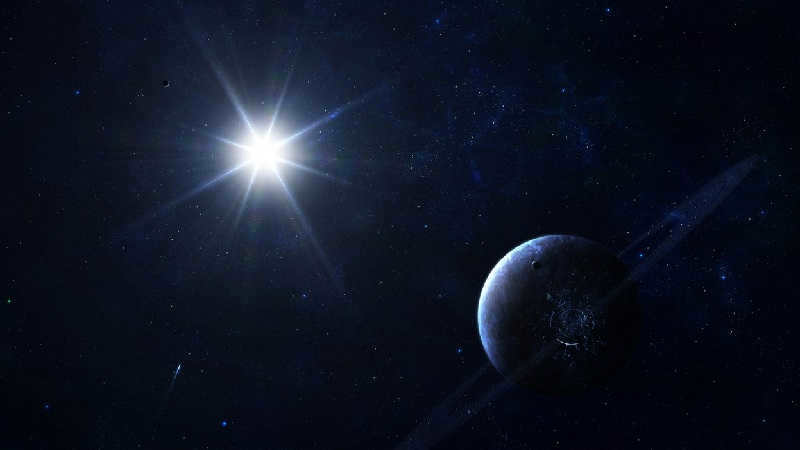
Distinguishing characteristics
Undoubtedly, stars and planets possess several common traits.
Firstly, they are celestial bodies that originate from particles of matter and gases. Secondly, their composition and shape exhibit resemblances (both have a spherical form). Each displays a core, internal and external regions, as well as an atmosphere.
Thirdly, their movements differ slightly, albeit both gravitate within orbits.
Furthermore, these celestial entities are observable even to the unaided eye, owing to their luminosity.
In addition, they compose star systems, yet in these systems, planets revolve around stars.

How planets are distinct from stars
First and foremost, the distinction lies in their luminosity. Both entities possess this characteristic, but there is a crucial difference. Stars generate energy and emit light through nuclear reactions and high temperatures, whereas planets, though luminous, do not emit light but instead reflect starlight.
It is important to note that temperature is directly correlated to the cause of luminosity, making it another distinguishing factor. Stars are incandescent, whereas planets are not.
Unlike stars, planets have a uniform reflection of light due to their cold nature. In contrast, luminaries emit light unevenly due to their high temperature and the thermonuclear fusion processes occurring within them. They flare up and then appear to fade away, which is why the twinkling of luminaries is often discussed.

Therefore, when observing the night sky, it is possible to distinguish the planets within our solar system from the stars. In simple terms, if a bright point of light flickers, it is a star. However, if the light remains constant, it indicates a planet.
Which do you believe is larger, a star or a planet? In reality, a planet is smaller in size compared to a star. It is always significantly smaller than a star.
What are the visual distinctions between planets and stars?
When gazing at the night sky, we are greeted by shining points of light, which can be either stars or planets. But how can we differentiate between the two? It’s actually quite straightforward. Only the planets within our solar system are visible from Earth, while the others remain hidden from our sight. This is because their immense distance and smaller size prevent their reflected light from reaching us.
Movement is another key contrast between these celestial bodies. Planets revolve around a star and also spin on their own axis, whereas stars orbit around the center of their galaxy. While stars may appear stationary in the sky, planets gradually shift their positions over time. This is how ancient civilizations were able to discern planets from stars.
Certainly, there are other distinctive characteristics. It is true that identifying them necessitates the utilization of specialized apparatus. For instance, through spectral analysis, astronomers can ascertain the elemental composition of the entity and thus discern its identity.

So, to summarize, we can highlight the distinctions between a planet and a star: temperature, brightness, size, and their movement. Undoubtedly, there are numerous objects, celestial bodies, and systems in outer space, which, in turn, comprise and create other entities. It resembles a universal chain in which one thing leads to another. And this process is never-ending. However, it possesses its own beauty.
Indeed, it is not always effortless to differentiate cosmic objects from one another. In some cases, basic observations or knowledge suffice, while in others, the assistance of experts and scientists is required. I trust that this article has aided you in comprehending the distinctions between a planet and a star.
It’s not surprising that the discovery of a new exoplanet, unattached to any star, may not generate much excitement anymore. Astronomers have already found numerous such solitary planets in recent years, to the point where they are becoming the norm rather than the exception in the Universe.
In fact, a study conducted in 2011 suggested that the number of orphan planets in our galaxy exceeds the number of typical planets orbiting their parent stars by at least 50 percent. This would mean that there are approximately one billion lonely planets in the Milky Way galaxy.
According to scientists, gas giants may be a minority among the solitary planets that scurry about. “In today’s understanding, we are aware that massive solitary planets are quite uncommon and that typically among them are planets with a mass comparable to that of Neptune or Earth,”
the astronomers stated. – We also have knowledge that massive objects are more likely to have difficulty escaping star systems compared to lighter ones.” Remarkably, these solitary planets are relatively close to us. Future telescopes will provide further insight into these solitary planets that will not be obscured by nearby luminous stars.
These celestial nomads, known as free-floating planets, have been dubbed by scientists as such because they have managed to escape the confines of their original solar systems. However, recent research suggests that these wandering worlds may have actually formed independently, and the sheer number of them is staggering – billions in total.
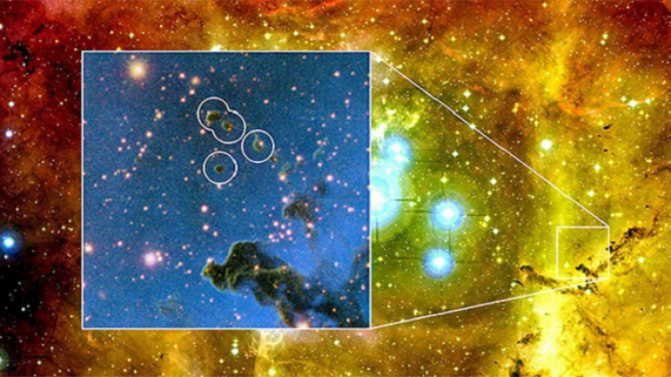
The truth is, not too long ago scientists made a discovery about the existence of planets that are not bound by the gravitational pull of a star and therefore do not orbit any star.
Last year, astronomers made an exciting finding when they spotted CFBDSIRJ2149, which is the closest known free-floating planet to us. This interesting planet is located 100 light-years away and has a mass ranging between 4 and 7 times that of Jupiter. What’s even more intriguing is that this free-floating planet appears to be a dull dark red color when observed in visible light.
And the most fascinating aspect is that it is just aimlessly drifting through the vastness of space.
Until now, it has been assumed by scientists that these planets, of which only a few are known, were created within existing planetary systems but then somehow became detached and moved away from their parent star due to a significant gravitational event, for example. Alternatively, it was thought that they became separated because the parent star ceased to exist. However, evidence has already been found to support the existence of planets in close proximity to deceased stars.
Recent observations of small, dark clouds known as globulets have revealed that planets can actually form independently, without the need for a pre-existing planetary system. This suggests that there may be a second method of planet formation, in addition to the widely accepted accretion disk theory.
The detection was announced by a group of astronomers hailing from Sweden and Finland who were observing small clouds in the Rosette Nebula, an enormous accumulation of dust and gas located 4,600 light-years away. Within this nebula, there exist numerous “tiny” (in cosmic terms) clouds that have a diameter no greater than the distance between the Sun and Neptune. These small clouds, known as globulets, possess an extremely high density, just slightly less dense than Jupiter’s 13 times the mass. It appears that these specks of gas and dust have the potential to give rise to a planet.
Measurements have indicated that globulets with dense cores have the possibility of collapsing due to their own gravitational force. This occurrence results in the formation of a certain celestial object.
Several of these formations can be classified as brown dwarfs – large celestial bodies that are unable to ignite and become stars. Additionally, considering the velocity at which globulettes move within the nebula – approximately 80,000 kilometers per hour – it is likely that some rogue planets will collide.
“Our hypothesis is that these small spherical formations originated from tall dusty columns of gas that were created by the intense radiation emitted by young stars,” explains an astronomer affiliated with the University of Helsinki. – “They fragmented away from the core of the nebula due to the intense pressure exerted by the central hot stars.”
In the spring of 2011, a groundbreaking study was published which completely revolutionized our understanding of the universe. This study unveiled the existence of 10 solitary planets that are traversing our galaxy in isolation. Basic calculations suggest that this astounding discovery is only the tip of the iceberg, as there are likely millions of these enigmatic black worlds awaiting our exploration. What’s more, simulations of the conditions on these solitary planets indicate that they may even harbor life…
Imagine a desolate black world, hurtling through the vast expanse of our galaxy’s center. It is conceivable that there could be twice as many of these planets as there are stars in the universe. It is even possible that some of these lonesome planets exist in close proximity to our very own solar system…
Over the past few years, humanity has made incredible discoveries, uncovering more than a thousand exoplanets – fascinating worlds that revolve around distant stars. The techniques used to detect these exoplanets are continuously improving, allowing astronomers to expand our understanding of the visible Universe.
Additionally, elliptical galaxies have played a significant role in altering our perception of the cosmos. They have led to a threefold increase in the number of stars in the Universe, while simultaneously reducing the proportion of dark matter present… (for more information, visit Sci-Fact.ru).
Furthermore, scientists have long been aware of the existence of brown dwarfs – celestial objects that possess a mass similar to that of planets or gas giants. These fascinating objects undergo thermonuclear reactions, making them distinct from their planetary counterparts. And now, they have also discovered the existence of lonely planets in the vastness of interstellar space.
It is evident that the planet itself cannot be observed directly without the presence of starlight. However, the phenomenon of microlensing – the amplification of light emitted by distant stars due to the gravitational field of a large object obstructing its path – aids astronomers in detecting such dark worlds. This phenomenon was initially predicted in Einstein’s general theory of relativity.
Over the course of 2 years, astronomers from Japan and the United States diligently monitored 50 million stars in the central region of our Galaxy. They utilized 1.8 and 1.3-meter telescopes situated in New Zealand and Chile for this purpose. In total, they documented approximately 500 instances of brightness amplification, and out of those, 10 were attributed to planets rather than other stars. The distance to these identified solitary planets ranged from 10,000 to 20,000 light-years….
Having found ten solitary planets with the same mass as Jupiter is quite a remarkable discovery. This is especially impressive considering that the observation was limited to a very small portion of the sky, and for a planet to be detected, it must be sufficiently large and have crossed the path between a distant star and the Earth observer.
It is a conservative estimate to suggest that there may be millions of planets without suns . On the other end of the spectrum, the highest estimation for the “population” of these new dark worlds is that there could be twice as many solitary planets as there are stars, amounting to between 400 and 800 billion. .
How did such a vast number of solitary planets emerge? The majority of researchers posit that these planets originated in typical solar systems with a single or dual central star, but were subsequently displaced from their orbital paths due to the gravitational influence of other planets or when their parent star came into close proximity with other stars. Observations of exoplanets indicate that the dramatic evolution of solar systems is quite common – hot gas giants frequently undergo orbital changes, resulting in the destruction or ejection of terrestrial planets.
Discovery of the fifth fundamental force of nature… (see on Sci-Fact.ru)
However, there exists another perspective, which suggests that solitary planets (at least some of them) are actually stars that never underwent further development and instead formed independently from primary gas clouds….
Currently, 10 gas giants (similar to Jupiter or Saturn) have been detected, but it is probable that the majority of solitary planets are much smaller in size, comparable to Earth or even smaller. This is because smaller planets are more likely to be expelled from their parent star’s orbit.
Voyager 1 and Voyager 2: a 33-year journey through the stars… (check out on Sci-Fact.ru)
If there truly are numerous Earth-like planets out there, the chances of discovering one in close proximity to Earth are quite high. It might be situated much nearer to us than the nearest stars with planetary systems. Most importantly, there is a possibility that such a planet could support life .
A planet without a sun can sustain life for billions of years, according to a study by geophysicist Dorian Abbot and astrophysicist Eric Switze from the University of Chicago. By simulating a scenario where “the sun goes out,” the researchers found that beneath a thick layer of ice, a kilometer-long layer of liquid water could exist, providing a potential habitat for life. This is true even for planets with masses similar to Earth’s. The study considered a range of planet masses, from one-tenth to ten times that of Earth, and assumed comparable amounts of water.
As a consequence, it was discovered that a solitary planet weighing three times as much as Earth, which was expelled from its own solar system, would maintain a layer of liquid water several kilometers thick beneath a substantial layer of ice. The energy released from the decay of radioactive material would be sufficient to last for 5 billion years, during which the existence of life on the planet is quite feasible.
The principle of panspermia in action: bacteria in outer space survived for 553 days… (read more on Sci-Fact.ru)
Life in the solar system may have spread from Earth during the same period as the extinction of the dinosaurs… (read more on Sci-Fact.ru)
However, this is still insufficient: if volcanic activity persists on the planet, then even in a solitary world that is one-third the size of Earth, it is feasible to preserve water and, consequently, sustain life. Volcanic activity will be accompanied by the release of gases, which, upon freezing, effectively shield the planet from the vastness of interstellar space…
Can intelligent civilizations thrive in such lightless worlds devoid of suns? – Why not? The real question is whether we will be capable of comprehending the beings that inhabit such an alien, according to our standards, environment…
For now, let’s attempt to discover life “at the very least” within our own solar system, such as on Europa, one of Jupiter’s moons, where an entire ocean lies hidden beneath an icy surface, or on Titan, one of Saturn’s moons, where there is a hopeful belief that life may exist, but based on entirely different principles than those found on Earth…
(cc) permanent article link: https://sci-fact.ru/archive-1-space-fact/novyj-chernyj-mir-10-odinokix-planet-bez-solnc-vsego-planet-milliony.html
- After a careful recount, it has been determined that there could be anywhere from 361 to 37,964 civilizations in our Galaxy…
- The plants found on planets beyond our solar system exhibit a wide range of colors, including yellow, red, and even black…
- Could life potentially exist on Titan…
- Astronomers are using the Mobile Astronomy Telescope-Robot System to search for gamma-ray bursts…
- The Voyager 1 and Voyager 2 spacecraft have been on a 33-year journey through the stars…
- Bacteria in outer space have demonstrated the theory of panspermia by surviving for 553 days…
- Elliptical galaxies have significantly increased the number of stars in the Universe by a factor of 3 and decreased the proportion of dark matter…
- Life in the universe might have originated from Earth during the same period when the dinosaurs became extinct…
- Scientists have discovered evidence of the most ancient life forms on our planet. Anaerobic microorganisms existed as far back as 3.4 billion years ago. It is possible that these organisms could have also thrived on other celestial bodies…
Life in the Cosmos Cosmos Planets Astrobiology Astrophysics Milky Way Life Stars Journey to the Stars Exoplanets Solitary Planets Dark Universe Black Universe
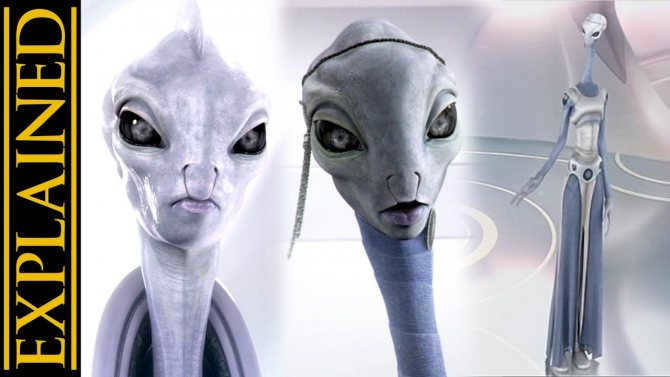
Bluzhdajushhie zvezdy
An image with various colors taken by the Pan-STARRS1 telescope displays the planetary body PSO J318.5-22 drifting freely through the vastness of space, situated in the Capricorn constellation. It is an extremely cold and dim world, with its brightness being 100 billion times fainter in optical light when compared to Venus. The majority of its energy is emitted in the infrared spectrum.
These celestial bodies are commonly referred to as vagabonds, outcasts, wanderers, or orphans. These entities have the appearance and size of planets, which is exactly what they are. However, they lack any gravitational connection to a star.
Rogue planets can be found within a galaxy, revolving around a central core. Alternatively, they may fall into the category of intergalactic planets, which are not bound to anything at all. The majority of scientists firmly believe that orphan planets are unable to form independently.
It is highly probable that they originate through a typical process alongside a star. Subsequently, some catastrophic incident (such as a star explosion or collision with another planet) propels them out of their original stellar system. Once they lose their gravitational connection, these celestial bodies embark on a journey until they encounter another star.
Anticipating the Arrival of Nibiru: To Believe or Not?
Let’s delve into the topic of Nibiru once again. Assuming its existence, this mysterious planet would undoubtedly exert a profound influence on the other celestial bodies within our solar system, just as Neptune did in the past. Astronomers, being highly astute individuals, would swiftly recognize any discrepancies between the projected motion of Nibiru and the actual observations, which would indicate the presence of an unknown factor in the equation. Furthermore, the magnitude of Nibiru, comparable to that of Jupiter or even greater, would amplify its impact on the entire solar system. This is due to the correlation between a planet’s mass and its gravitational pull, which becomes more pronounced with a larger celestial body. Discover more about the principles of gravity and weightlessness by exploring our informative articles.
The Intricacies of the Solar System
If you observe the solar system “from a higher perspective,” at present, all the planets ranging from Venus to Neptune revolve as if on the same platter, within the same plane. However, astronomer David Morrison postulates that if an entity like Nibiru were to pass by Earth approximately every 3,600 years, its gravitational pull would disrupt the planetary alignment, causing a disturbance in the order. Furthermore, if Nibiru were indeed real, it would have absconded with the moon from Earth numerous years ago. Lastly, here’s the conclusive piece of evidence: the solar system is incredibly vast. While the planets traverse their orbits at considerable velocities, they still move relatively slowly, which means that even if Nibiru were to approach, we would have detected its presence at least a couple of years before a potential collision.
Subsequently, following a violent conflict with the Holy Inquisition, whereby they vigorously defended their misconceptions, the true nature of these wandering stars was finally revealed.
The heliocentric model, which posits that the Earth is situated at the center of the universe, began to crumble as a result of careful observations of these restless celestial bodies, whose movements were perplexing. Challenging, yet not insurmountable. Who can say what marvels reside in the vast expanse? Perhaps they are celestial beings.
Nonetheless, astronomers honed their telescopes, gradually uncovering that the entities present in that realm are far from angelic.
Learn more: The BepiColombo space mission will unveil the enigmas surrounding Mercury
However, it appears that the system does not actually revolve around the Earth, but around the Sun. In reality, it is much more intricate than it initially appears. For instance, while the Moon does revolve around the Earth, giving conservatives some solace, there are also numerous other planets, like the Earth, that revolve around the Sun, and some of them even have their own moons.
As a result, the complexities of this system eventually caused the Inquisition to fade into obscurity.
Nibiru: the latest updates
As per the widely known narrative, Nibiru is predicted to collide with our home planet at some point in the future, or at least come close enough to cause various natural catastrophes and potentially bring about the downfall of human civilization. However, at present, Nibiru remains purely a work of fiction. Consider it logically: how could something of that magnitude be concealed? If Nibiru truly existed, there would undoubtedly be evidence of its presence scattered throughout the entire solar system. We discovered the outermost planets, Neptune and Uranus, over two centuries ago, and since then, telescopic technology has advanced significantly. Furthermore, it is important to note that all planets have been following their respective orbits for a considerable duration, which means that if Nibiru were real, it would have undoubtedly cleared its orbital path over billions of years.
The comparative sizes of the planets within the solar system
Alright. Suppose Nibiru is moving in a peculiar path. However, if that were true, we would have already observed the proof a while back. Prior to astronomers discovering Neptune (in 1846), they had a suspicion that there must be a massive planet somewhere in the vast expanse beyond. Why? It’s because stargazers noticed that Uranus was consistently veering off from its predicted trajectory. Mathematicians theorized that this was due to the influence of a substantial planet in close proximity. And you know what? This enigmatic planet turned out to be the gigantic gas giant we currently refer to as Neptune.
- What is unique about planets
- What is the duration of a year on Saturn?
- How far is Mars from the sun?
- How many massive planets are there
- Saturn is the planet that is located at the greatest distance from the sun
- Understanding the mechanics of the solar system
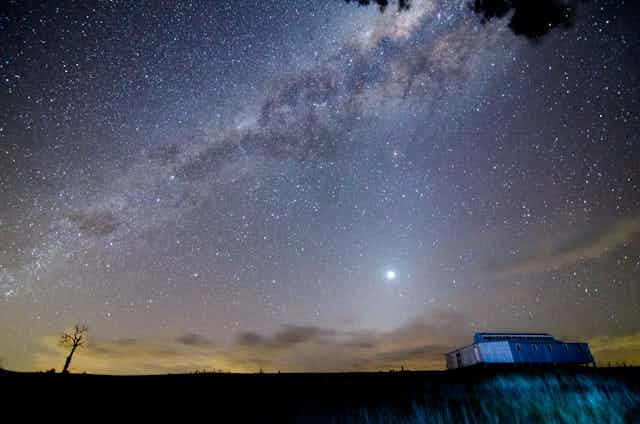
Aboriginal traditions describe the complex motions of planets, the ‘wandering stars’ of the sky
Senior Research Fellow, Monash University
Disclosure statement
Duane W. Hamacher receives funding from the Australian Research Council.
Monash University provides funding as a founding partner of The Conversation AU.
View all partners
Aboriginal and Torres Strait Islander readers are advised that this story may contain images and voices of people who have died.
The five planets we can see by naked eye were known to the ancient Greeks as “asteres planetai”, meaning “wandering stars”, due to their wandering journey across the sky relative to the fixed stars. This is where we get the word “planet”.
But knowledge of the planets and their movements goes back much further, being prominent in the traditions of the oldest continuing cultures in the world.
Recent research reveals a wealth of information about the planets and their complex motions in the Knowledge Systems of Indigenous Australians.
The wandering stars
These systems show that Aboriginal and Torres Strait Islander people carefully observe the complex motions of the planets.
Read more: The stories behind Aboriginal star names now recognised by the world's astronomical body
In Wardaman traditions, the planets are ancestor spirits who walk across a celestial road. Wardaman Elder Bill Yidumduma Harney calls it the Dreaming Track in the Sky .
Astronomers call this celestial road the zodiac – the region of sky nine degrees on either side of the ecliptic (the path of the Sun). As the planets orbit the Sun in roughly the same plane, they all are visible along this band of the sky.

Uncle Yidumduma describes the planet-ancestors moving across the sky much like we walk down a busy footpath. We sometimes hurriedly pass each other, or slow down for a chat. Occasionally, we even stop and turn backwards to chat with someone before moving forward again.
Astronomers call this phenomenon retrograde motion. It is an optical effect that occurs as the planets orbit the Sun at different distances and velocities. It means the planets can appear to slow down and move backwards for a time before returning to their normal motion.

There are five planets visible to the naked eye and right now, and you can see at least four – Venus, Mars, Jupiter and Saturn – in the sky at sunset from most locations across Australia . All of these planets are currently in retrograde motion.

The (non) twinkling stars
Aboriginal and Torres Strait Islander people recognise that these wandering stars generally do not twinkle – a phenomenon the Meriam people of the eastern Torres Strait call epreki and observe to predict weather and seasonal change.
But sometimes they do twinkle, particularly if they are very low on the horizon. Kamilaroi people of northern New South Wales say Venus occasionally twinkles when it’s low in the sky. They say it’s an old man who told a rude joke and has been laughing ever since.
In the traditions of the Euahlayi people – neighbours of the Kamilaroi – Venus and Mars relate to songlines and trade with Arrernte people of the Central Desert.
During special ceremonies, the Arrernte travel from the MacDonnell Ranges to Quilpie in southwest Queensland, bringing with them a red stone that signifies Mars. The Euahlayi people bring a green and blue stone to the ceremony, representing Venus. They are seen as the different-coloured eyes of the creator spirit Baayami .
Venus - the Morning and Evening Star
Venus is commonly known in many Aboriginal and Torres Strait Islander cultures as both the Morning and Evening Star.
In the Dreaming stories of the Western Arrernte, a celestial baby fell from the Milky Way, striking the ground and creating the giant meteorite crater called Tnorala (Gosses Bluff). The child’s parents – the Morning and Evening Stars – take turns searching for their lost child to this day.
Arrernte mothers warn their children not to look at the Morning or Evening Star, as the celestial parents might mistake them for their lost child and carry them away to the sky.
In Yolngu traditions of Arnhem Land, a special ceremony is held to signify the rising of the Creation ancestor, Banumbirr (Venus), between the mainland and a Burralku – the sacred island of the dead.
The ceremony starts at dusk and continues through the night, reaching a climax when Banumbirr rises a few hours before dawn as Venus transitions from the Evening Star to the Morning Star. Banumbirr communicates with the people through a faint rope that holds her close to the Sun.
Astronomers call this zodiacal light – the glow of dust in the plane of the Solar System.

The first rising of Venus as the Morning Star, after it transitions from the Evening Star, occurs every 584 days. Astronomers refer to this as Venus’ synodic period .
Read more: Stars that vary in brightness shine in the oral traditions of Aboriginal Australians
When astronomer Ray Norris asked a Yolngu elder how the people know when to hold the Banumbirr ceremony, the elder responded: “We count the days!”
That’s an achievement not often recognised, and just another example of the detailed understanding of these “wandering stars” in the Knowledge Systems of Indigenous Australians.
Kirsten Banks , a Wiradjuri woman and astrophysics graduate from the University of New South Wales, contributed to this research and this article. She can be contacted at [email protected]
- Aboriginal history
- Indigenous astronomy
- Aboriginal culture
Want to write?
Write an article and join a growing community of more than 185,000 academics and researchers from 4,979 institutions.
Register now
share this!
August 16, 2018
Aboriginal traditions describe the complex motions of planets, the 'wandering stars' of the sky
by Duane W. Hamacher, The Conversation
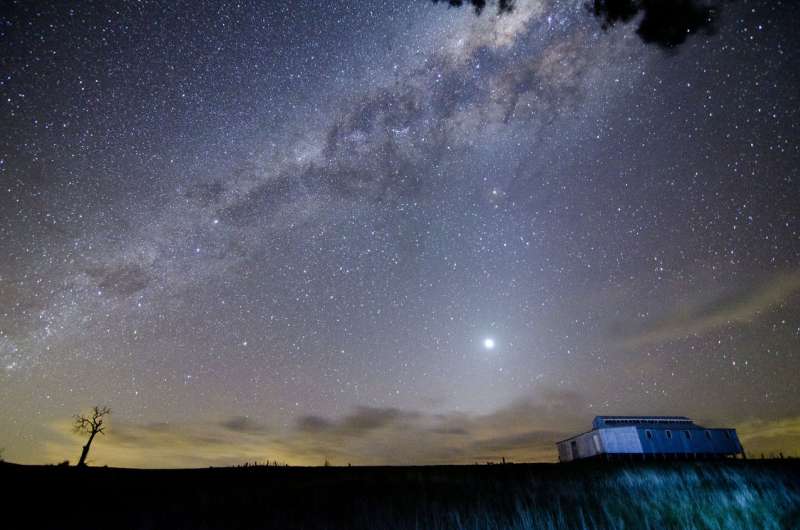
(Aboriginal and Torres Strait Islander readers are advised that this story may contain images and voices of people who have died.)
The five planets we can see by naked eye were known to the ancient Greeks as "asteres planetai", meaning "wandering stars ", due to their wandering journey across the sky relative to the fixed stars. This is where we get the word "planet".
But knowledge of the planets and their movements goes back much further, being prominent in the traditions of the oldest continuing cultures in the world.
Recent research reveals a wealth of information about the planets and their complex motions in the Knowledge Systems of Indigenous Australians.
The wandering stars
These systems show that Aboriginal and Torres Strait Islander people carefully observe the complex motions of the planets.
In Wardaman traditions, the planets are ancestor spirits who walk across a celestial road. Wardaman Elder Bill Yidumduma Harney calls it the Dreaming Track in the Sky .
Astronomers call this celestial road the zodiac – the region of sky nine degrees on either side of the ecliptic (the path of the Sun). As the planets orbit the Sun in roughly the same plane, they all are visible along this band of the sky.
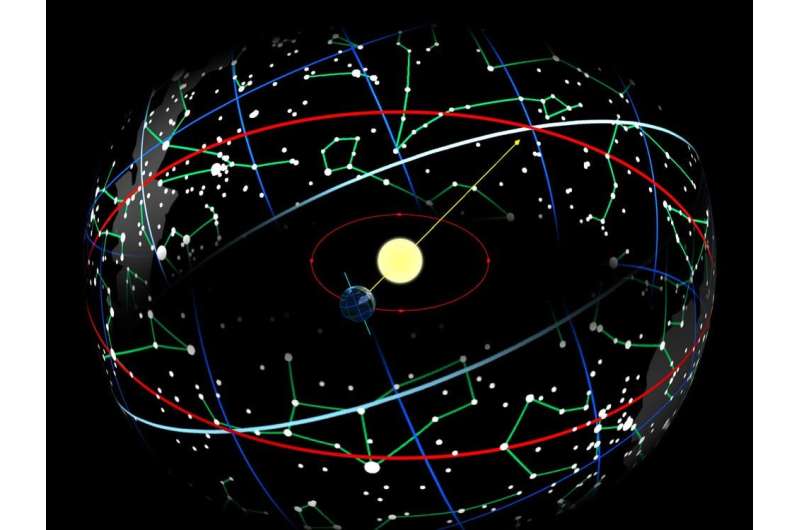
Uncle Yidumduma describes the planet-ancestors moving across the sky much like we walk down a busy footpath. We sometimes hurriedly pass each other, or slow down for a chat. Occasionally, we even stop and turn backwards to chat with someone before moving forward again.
Astronomers call this phenomenon retrograde motion. It is an optical effect that occurs as the planets orbit the Sun at different distances and velocities. It means the planets can appear to slow down and move backwards for a time before returning to their normal motion.
There are five planets visible to the naked eye and right now, and you can see at least four – Venus, Mars, Jupiter and Saturn – in the sky at sunset from most locations across Australia . All of these planets are currently in retrograde motion.
The (non) twinkling stars
Aboriginal and Torres Strait Islander people recognise that these wandering stars generally do not twinkle – a phenomenon the Meriam people of the eastern Torres Strait call epreki and observe to predict weather and seasonal change.
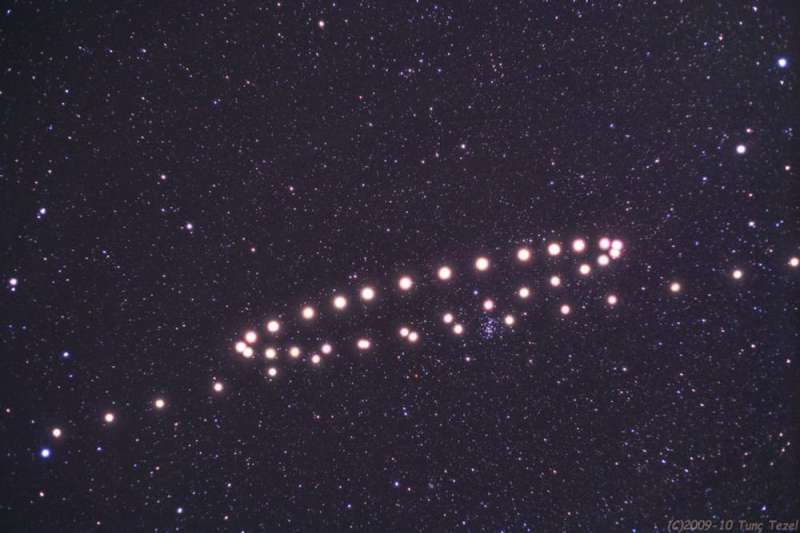
But sometimes they do twinkle, particularly if they are very low on the horizon. Kamilaroi people of northern New South Wales say Venus occasionally twinkles when it's low in the sky. They say it's an old man who told a rude joke and has been laughing ever since.
In the traditions of the Euahlayi people – neighbours of the Kamilaroi – Venus and Mars relate to songlines and trade with Arrernte people of the Central Desert.
During special ceremonies, the Arrernte travel from the MacDonnell Ranges to northern New South Wales, bringing with them a red stone that signifies Mars. The Euahlayi people bring a green and blue stone to the ceremony, representing Venus. They are seen as the different-coloured eyes of the creator spirit Baayami .
Venus—the Morning and Evening Star
Venus is commonly known in many Aboriginal and Torres Strait Islander cultures as both the Morning and Evening Star.
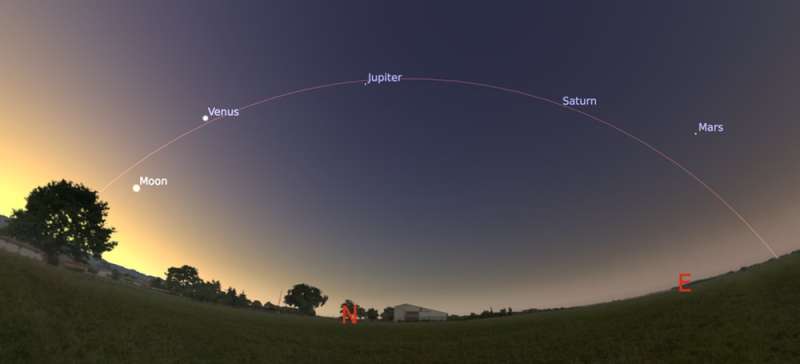
In the Dreaming stories of the Western Arrernte, a celestial baby fell from the Milky Way, striking the ground and creating the giant meteorite crater called Tnorala (Gosses Bluff). The child's parents – the Morning and Evening Stars – take turns searching for their lost child to this day.
Arrernte mothers warn their children not to look at the Morning or Evening Star, as the celestial parents might mistake them for their lost child and carry them away to the sky.
In Yolngu traditions of Arnhem Land, a special ceremony is held to signify the rising of the Creation ancestor, Banumbirr (Venus), between the mainland and a Burralku – the sacred island of the dead.
The ceremony starts at dusk and continues through the night, reaching a climax when Banumbirr rises a few hours before dawn as Venus transitions from the Evening Star to the Morning Star. Banumbirr communicates with the people through a faint rope that holds her close to the Sun.
Astronomers call this zodiacal light – the glow of dust in the plane of the Solar System.
The first rising of Venus as the Morning Star, after it transitions from the Evening Star, occurs every 584 days. Astronomers refer to this as Venus' synodic period .
When astronomer Ray Norris asked a Yolngu elder how the people know when to hold the Banumbirr ceremony, the elder responded: "We count the days!"
That's an achievement not often recognised, and just another example of the detailed understanding of these "wandering stars" in the Knowledge Systems of Indigenous Australians.
Kirsten Banks , a Wiradjuri woman and astrophysics graduate from the University of New South Wales, contributed to this research and this article. She can be contacted at [email protected]
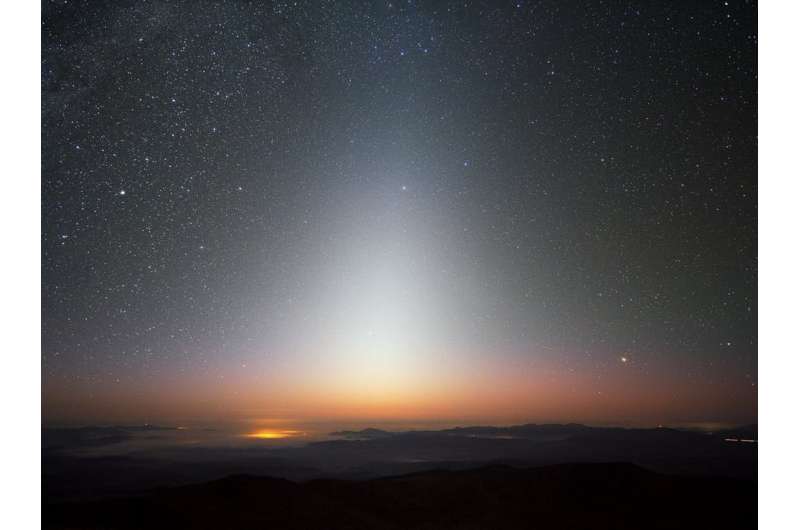
Provided by The Conversation
Explore further
Feedback to editors

New method could allow multi-robot teams to autonomously and reliably explore other planets
13 hours ago

Virgin Galactic completes final spaceflight before two-year pause
18 hours ago

Study finds fresh water and key conditions for life appeared on Earth a half-billion years earlier than thought
Jun 8, 2024

Saturday Citations: Praising dogs; the evolution of brown fat; how SSRIs relieve depression. Plus: Boeing's Starliner

Nonreciprocal quantum batteries exhibit remarkable capacities and efficiency

New method optimizes lithium extraction from seawater and groundwater

Rare 7-foot fish washed ashore on Oregon's coast garners worldwide attention
Jun 7, 2024

California wildfire pollution killed 52,000 in a decade: study

Quantum chemistry and simulation help characterize coordination complex of elusive element 61

A protein that enables smell in ants—and stops cell death
Relevant physicsforums posts, dark energy: are we all missing the obvious.
7 hours ago
Our Beautiful Universe - Photos and Videos
Solar activity and space weather update thread, will we ever communicate with extraterrestial life in a reasonable time frame, unknown radio signal from space repeats every hour -- usually, how 'messy' are fusion reaction chains in stars.
Jun 6, 2024
More from Astronomy and Astrophysics
Related Stories

Jupiter, Venus and Mars stand proud in the morning sky
Oct 14, 2015

Dance of the planets in the evening sky
Feb 19, 2015

Your guide to see five planets after sunset
Jul 21, 2016

Astronomy in Indigenous knowledge
Dec 1, 2014
Mystery of the Star of Bethlehem unlikely to be resolved
Dec 19, 2017

All five bright planets come together in the morning sky
Jan 15, 2016
Recommended for you

Researcher suggests that gravity can exist without mass, mitigating the need for hypothetical dark matter

New rare 'green bean' galaxy discovered

Gaia: Milky Way's last major collision was surprisingly recent

JWST discovers large variety of carbon-rich gases that serve as ingredients for future planets around very low-mass star

Earliest detection of metal challenges what we know about the first galaxies

Astronomers investigate giant molecular clouds in the galaxy NGC 613
Jun 5, 2024
Let us know if there is a problem with our content
Use this form if you have come across a typo, inaccuracy or would like to send an edit request for the content on this page. For general inquiries, please use our contact form . For general feedback, use the public comments section below (please adhere to guidelines ).
Please select the most appropriate category to facilitate processing of your request
Thank you for taking time to provide your feedback to the editors.
Your feedback is important to us. However, we do not guarantee individual replies due to the high volume of messages.

E-mail the story
Your email address is used only to let the recipient know who sent the email. Neither your address nor the recipient's address will be used for any other purpose. The information you enter will appear in your e-mail message and is not retained by Phys.org in any form.
Newsletter sign up
Get weekly and/or daily updates delivered to your inbox. You can unsubscribe at any time and we'll never share your details to third parties.
More information Privacy policy
Donate and enjoy an ad-free experience
We keep our content available to everyone. Consider supporting Science X's mission by getting a premium account.
E-mail newsletter

Suggested Searches
- Climate Change
- Expedition 64
- Mars perseverance
- SpaceX Crew-2
- International Space Station
- View All Topics A-Z
Humans in Space
Earth & climate, the solar system, the universe, aeronautics, learning resources, news & events.

NASA, Global Astronomers Await Rare Nova Explosion

NASA Scientists Take to the Seas to Study Air Quality

NASA to Change How It Points Hubble Space Telescope
- Search All NASA Missions
- A to Z List of Missions
- Upcoming Launches and Landings
- Spaceships and Rockets
- Communicating with Missions
- James Webb Space Telescope
- Hubble Space Telescope
- Why Go to Space
- Commercial Space
- Destinations
- Living in Space
- Explore Earth Science
- Earth, Our Planet
- Earth Science in Action
- Earth Multimedia
- Earth Science Researchers
- Pluto & Dwarf Planets
- Asteroids, Comets & Meteors
- The Kuiper Belt
- The Oort Cloud
- Skywatching
- The Search for Life in the Universe
- Black Holes
- The Big Bang
- Dark Energy & Dark Matter
- Earth Science
- Planetary Science
- Astrophysics & Space Science
- The Sun & Heliophysics
- Biological & Physical Sciences
- Lunar Science
- Citizen Science
- Astromaterials
- Aeronautics Research
- Human Space Travel Research
- Science in the Air
- NASA Aircraft
- Flight Innovation
- Supersonic Flight
- Air Traffic Solutions
- Green Aviation Tech
- Drones & You
- Technology Transfer & Spinoffs
- Space Travel Technology
- Technology Living in Space
- Manufacturing and Materials
- Science Instruments
- For Kids and Students
- For Educators
- For Colleges and Universities
- For Professionals
- Science for Everyone
- Requests for Exhibits, Artifacts, or Speakers
- STEM Engagement at NASA
- NASA's Impacts
- Centers and Facilities
- Directorates
- Organizations
- People of NASA
- Internships
- Our History
- Doing Business with NASA
- Get Involved
- Aeronáutica
- Ciencias Terrestres
- Sistema Solar
- All NASA News
- Video Series on NASA+
- Newsletters
- Social Media
- Media Resources
- Upcoming Launches & Landings
- Virtual Events
- Sounds and Ringtones
- Interactives
- STEM Multimedia
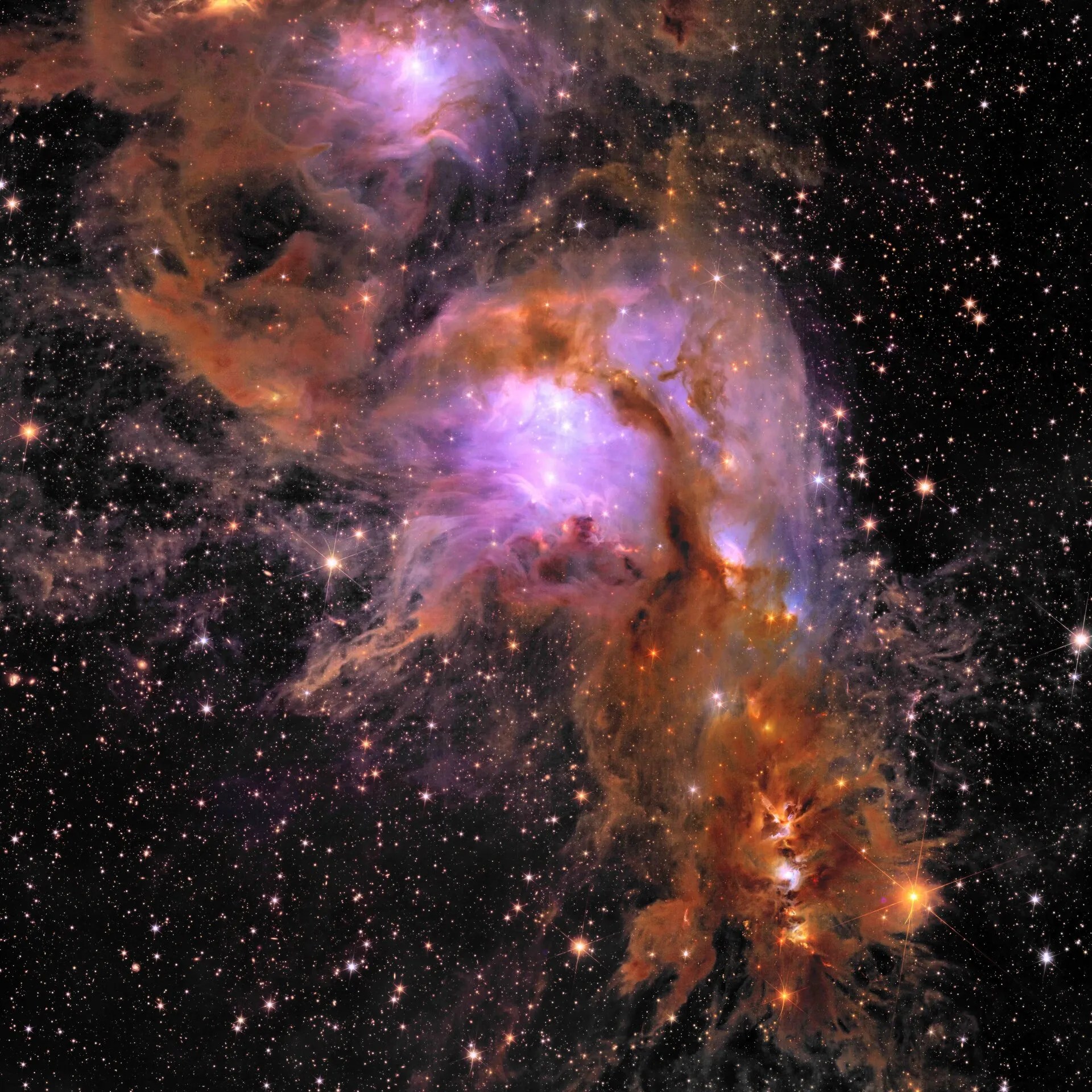
Amendment 19: D.18 Euclid General Investigator Program: Names must be omitted from References.

PACE Celebrates National Ocean Month With Colorful Views of the Planet

Hubble Examines a Barred Spiral’s Light

NASA Astronauts Practice Next Giant Leap for Artemis

Former Astronaut David R. Scott

Space Station Research Advances NASA’s Plans to Explore the Moon, Mars

NASA Mission Flies Over Arctic to Study Sea Ice Melt Causes

Webb Finds Plethora of Carbon Molecules Around Young Star

Solid State Quantum Magnetometers—Seeking out water worlds from the quantum world

C.12 Planetary Instrument Concepts for the Advancement of Solar System Observations POC Change

The Big Event, 2025

Black Hole Week

Amendment 20: F.20 MOSAICS Seed Funding formerly SMD Bridge Program Seed Funding Final Text.

ARMD Solicitations

Winners Announced in Gateways to Blue Skies Aeronautics Competition

NASA, Industry to Start Designing More Sustainable Jet Engine Core

B.10 Heliophysics Flight Opportunities Studies Correction

Tech Today: Measuring the Buzz, Hum, and Rattle

Artemis Generation Shines During NASA’s 2024 Lunabotics Challenge

NASA Marshall Engineer Receives AIAA Honors Award

Meet the Simunauts: Ohio State Students to Test Space Food Solutions for NASA

Diez maneras en que los estudiantes pueden prepararse para ser astronautas

Astronauta de la NASA Marcos Berríos

Resultados científicos revolucionarios en la estación espacial de 2023
Nasa gets unusually close glimpse of black hole snacking on star, jet propulsion laboratory, a surprising signal, more about the mission.
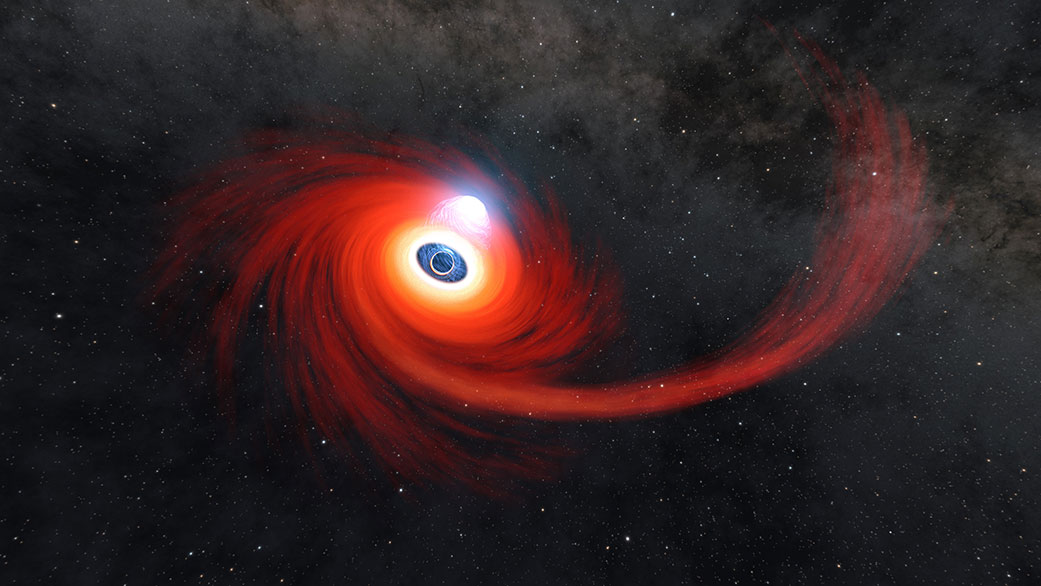
Recent observations of a black hole devouring a wandering star may help scientists understand more complex black hole feeding behaviors.
Multiple NASA telescopes recently observed a massive black hole tearing apart an unlucky star that wandered too close. Located about 250 million light-years from Earth in the center of another galaxy, it was the fifth-closest example of a black hole destroying a star ever observed.
Once the star had been thoroughly ruptured by the black hole’s gravity, astronomers saw a dramatic rise in high-energy X-ray light around the black hole. This indicated that as the stellar material was pulled toward its doom, it formed an extremely hot structure above the black hole called a corona. NASA’s NuSTAR (Nuclear Spectroscopic Telescopic Array) satellite is the most sensitive space telescope capable of observing these wavelengths of light, and the event’s proximity provided an unprecedented view of the corona’s formation and evolution, according to a new study published in the Astrophysical Journal .
The work demonstrates how the destruction of a star by a black hole – a process formally known as a tidal disruption event – could be used to better understand what happens to material that’s captured by one of these behemoths before it’s fully devoured.
Most black holes that scientists can study are surrounded by hot gas that has accumulated over many years, sometimes millennia, and formed disks billions of miles wide. In some cases, these disks shine brighter than entire galaxies. Even around these bright sources, but especially around much less active black holes, a single star being torn apart and consumed stands out. And from start to finish, the process often takes only a matter of weeks or months. The observability and short duration of tidal disruption events make them especially attractive to astronomers, who can tease apart how the black hole’s gravity manipulates the material around it, creating incredible light shows and new physical features.
“Tidal disruption events are a sort of cosmic laboratory,” said study co-author Suvi Gezari, an astronomer at the Space Telescope Science Institute in Baltimore. “They’re our window into the real-time feeding of a massive black hole lurking in the center of a galaxy.”
The focus of the new study is an event called AT2021ehb, which took place in a galaxy with a central black hole about 10 million times the mass of our Sun (about the difference between a bowling ball and the Titanic). During this tidal disruption event, the side of the star nearest the black hole was pulled harder than the far side of the star, stretching the entire thing apart and leaving nothing but a long noodle of hot gas.
Scientists think that the stream of gas gets whipped around a black hole during such events, colliding with itself. This is thought to create shock waves and outward flows of gas that generate visible light, as well as wavelengths not visible to the human eye, such as ultraviolet light and X-rays. The material then starts to settle into a disk rotating around the black hole like water circling a drain, with friction generating low-energy X-rays. In the case of AT2021ehb, this series of events took place over just 100 days.
The event was first spotted on March 1, 2021, by the Zwicky Transient Facility (ZTF), located at the Palomar Observatory in Southern California. It was subsequently studied by NASA’s Neil Gehrels Swift Observatory and Neutron star Interior Composition Explorer (NICER) telescope (which observes longer X-ray wavelengths than Swift).
Then, around 300 days after the event was first spotted, NASA’s NuSTAR began observing the system. Scientists were surprised when NuSTAR detected a corona – a cloud of hot plasma, or gas atoms with their electrons stripped away – since coronae usually appear with jets of gas that flow in opposite directions from a black hole. However, with the AT2021ehb tidal event, there were no jets, which made the corona observation unexpected. Coronae emit higher-energy X-rays than any other part of a black hole, but scientists don’t know where the plasma comes from or exactly how it gets so hot.
“We’ve never seen a tidal disruption event with X-ray emission like this without a jet present, and that’s really spectacular because it means we can potentially disentangle what causes jets and what causes coronae,” said Yuhan Yao, a graduate student at Caltech in Pasadena, California, and lead author of the new study. “Our observations of AT2021ehb are in agreement with the idea that magnetic fields have something to do with how the corona forms, and we want to know what’s causing that magnetic field to get so strong.”
Yao is also leading an effort to look for more tidal disruption events identified by ZTF and to then observe them with telescopes like Swift, NICER, and NuSTAR. Each new observation offers the potential for new insights or opportunities to confirm what has been observed in AT2021ehb and other tidal disruption events. “We want to find as many as we can,” Yao said.
A Small Explorer mission led by Caltech and managed by NASA’s Jet Propulsion Laboratory in Southern California for the agency’s Science Mission Directorate in Washington, NuSTAR was developed in partnership with the Danish Technical University and the Italian Space Agency (ASI). The spacecraft was built by Orbital Sciences Corp. in Dulles, Virginia. NuSTAR’s mission operations center is at the University of California, Berkeley, and the official data archive is at NASA’s High Energy Astrophysics Science Archive Research Center at NASA’s Goddard Space Flight Center. ASI provides the mission’s ground station and a mirror data archive. Caltech manages JPL for NASA.
For more information about the NuSTAR mission, visit:
https://www.nustar.caltech.edu/
Calla Cofield Jet Propulsion Laboratory, Pasadena, Calif. 626-808-2469 [email protected]
Jupiter: From a Wandering Star to the King of the Planets Essay
- To find inspiration for your paper and overcome writer’s block
- As a source of information (ensure proper referencing)
- As a template for you assignment
Among a variety of the existing planets in the Solar System with their unique characteristics, importance, and relevance to the Earth, Jupiter remains to be one of the most interesting unusual and remarkable objects for consideration. Its history, as well as its name, is closely connected to the Romans. Its place in the system may be easily compared with the role of the Romans in history. During prehistoric times, Jupiter was called a “wandering star,” and nowadays, people name it as the “King of Planets,” particularly because of its size, magnetic field, and the dozens of moons in regards to other planets (Siegel 164). The current paper aims at discussing and evaluating Jupiter from different perspectives, mentioning its size, location, age, appearance, history, etc., and proving that it has to be cared for and studied thoroughly by people.
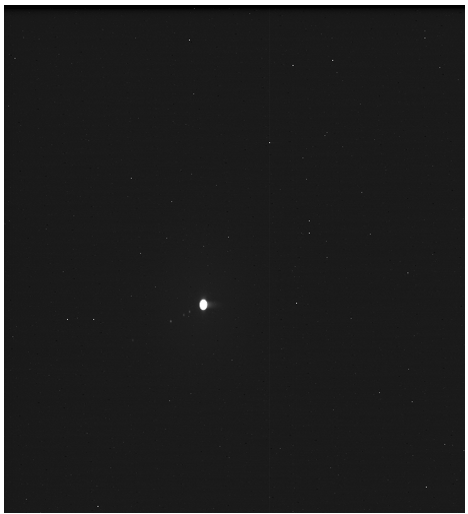
Jupiter is considered to be more than just an amazing object that can be observed in the sky. It is known due to its size (more than twice bigger than all other planets combined), its long history (its first record was dated in the 7 th BC), and its satellites (more than 60 moons are around the planet) (Tiner 43). On the one hand, this planet does not differ from the Moon or some other stars that can be visible from the Earth (Figure 1). On the other hand, its detailed analysis introduces the planet as a massive gas giant with absent surface and a faintly identified set of dust rings that amazes people and make them think about this planet as something unstable still important (Figure 2). This is why it is interesting to investigate Jupiter in order to prove that its specific characteristics make its role more crucial. Though its overview is a simple combination of numbers and metric data, its grandiosity cannot but amaze people.

Due to the presence of a number of moons as its satellites and a powerful magnetic field, the experts usually define Jupiter as a unique miniature solar system. There are four main satellites, which may be compared with the one of the Earth’s, the Moon; the others are smaller, still, their amount is influential indeed (“Fast Facts: Jupiter” par. 7). It is also stated that there is no life on Jupiter, but some of its moons with oceans may support life. However, this argument is hard to check for sure because of a few missions with positive results have been organized. In spite of the fact that Jupiter is more distant than Mars to the Earth, it is usually brighter, and it shines during the whole year around. Its shining is characterized as robust and constant (Tiner 42). This is why people can observe it from the Earth in case they know where and what to look at it.
The combination of some general facts about Jupiter can help to create a more or less clear picture of the planet and its development. In fact, the experts face a serious challenge defining its age, still, they admit that Jupiter is as old as the Sun. So, it is possible to assume that Jupiter is about 4.5 billion years. It is located in the Solar System with an average distance from the Sun about 483.600.000 miles and from the Earth about 390.000.000 miles, and its orbital period over the Sun is 11.86 Earth years (“Fast Facts: Jupiter” par. 3).
Though many people know Jupiter as the largest planet in the system, not all of them know that it is about 318 times bigger than Earth. In other words, its surface equals 122 Earth’s surfaces. There are also a number of lightning flashes that may be observed in the Jupiter’s atmosphere, and the experts admit that they are 1000 powerful than those on the Earth. It is also interesting to know what such a huge planet can consist of. There are two primary components of the planet’s atmosphere: hydrogen (86%) and helium (14%) (Tiner 51). The molecules of the gases are in constant motion, and the motion depends on the structure of the gas chosen (the lighter – the faster). However, the molecules of these two gases are not able to gain enough energy in order to become the reasons for a high gravity index.
In the paper, there has been already mentioned that Jupiter is the planet with a number of satellites of different sized. Tiner explains that it is possible to use the satellites in order to weigh the planet, still, this kind of weighing is more subjective because he talks an approximate mass of Jupiter (50). Now, it is known that Jupiter’s mass is about 1.900 x 10 27 kg (“Fast Facts: Jupiter” par. 5). Due to its great mass and the ability to cooperate with the satellites with a weaker gravity, Jupiter is characterized by a high gravity index.
In addition to such “dry” facts about such a magnificent planet as Jupiter, it is also possible to add several specific features that can attract people’s attention and introduce Jupiter from a new side. For example, the Great Red Spot on Jupiter is a result of a huge swirling gas storm lasted during several hundreds of years (“Fast Facts: Jupiter” par. 8). Its size is larger than Earth, and its importance is evident for the planet. The Spot was firstly introduced and discovered by Robert Hooke in 1664, still, his discovery was done in a wrong belt; and Giovanni Cassini observed its drifts in 1671. The periods with which the Great Red Spot drifted across the planet helped to identify the speed with which the planet actually rotated (Tiner 47).
The researcher was amazed how fast it could move, because 10 hours for such a huge and massive planet was really an amazing fact. Such huge speed also serves as an explanation of the planet’s form because its fast rotation leads to the bulge directed to its equator.
Each event on the planet may be an influential factor for its development as well as for the development of the planets around. For example, in the middle of the 20 th century, some astronomers truly believed that Jupiter could serve as a protective means for the Earth due to its atmosphere and gravity factor. Jupiter may have enough opportunities to make the crown of asteroids, comets, and other bodies thinner and less dangerous for the Earth. These suggestions help to realize that the Earth can be under a threat of numerous bodies of the Solar System, and it is wrong to neglect the impact of other planets, even such long-distant like Jupiter. The overview of the Jupiter’s history may become a helpful tool in realizing the importance and the role of the planet under consideration in regards to the whole system and the Earth in particular.
As it has been mentioned, Jupiter is as old as the Sun itself. The Babylonian astronomers recorded Jupiter and its activity in the 7 th century BC for the first time (Tiner 45). As many other discoveries of that time, it was associated with religion. The Babylonians associated the planet with their main god, Marduk, the Greeks knew him as Zeus, the god of thunder, the Germans saw the chosen planet as their god Thor, and the Romans named it after its king god, Jupiter. The results of these observations are based on the choice of the Romans. Nowadays, the whole world knows the hugest planet in the Solar System, Jupiter.
The name of Galileo is also connected to Jupiter and its history. This scientist and astronomer is known as a discoverer of the major moons of the planets in the beginning of the 17 th century. He turned his telescope to Jupiter and started examining its bright disks. Everyday observations provided Galileo with a solid basis for the discovery that the moons of Jupiter were as huge and massive as the satellites of the Earth.
Taking into consideration the above-mentioned facts and the results of the discoveries, it is possible to say about the importance of Jupiter in regards to the Solar System. First, its gravitational importance should be mentioned. Other planets may be protected due to the ability to decrease the number of cosmic bodies’ threats. Second, the evaluation of the Jupiter’s moons provided the scientists with hope in regards to life on the planet. The point is that the existence of underground oceans may create the necessary conditions for living. Unfortunately, these are only some guesses and suggestions that have to be supported by evidence and missions to the chosen planet and its satellites.
In general, Jupiter is the planet with a rich history. Its characteristics serve as the best proof that people have already learned a lot about this planet, still, there are also many issues that have to be identified, improved, and analyzed. It is not enough to know the fact that Jupiter is considered to be one of the largest planets in the existing Solar System (“Fast Facts: Jupiter” par.1). There are many other interesting facts that can be mentioned. Jupiter is the biggest gas planet that rotates within the shortest period in time compared with other planets of the same system. At the same time, it performs a protective function and helps other planets feel safe in regards to a number of asteroids and comets that move chaotically throughout the Solar System.
Though there is no life on Jupiter, people want to believe that additional investigations, constant missions, and evaluations of the planet’s possibilities make it real to admit one day that it is possible to live on Jupiter and use its riches for good. If the ancient people gave the name to this planet in honor of their main god, they probably did it for some reason. And the people of nowadays should not neglect the choice of their ancestors and try to understand why the name of such a crucial god was given to the planet. In fact, Jupiter has more secrets to be revealed in addition to the facts mentioned in the paper.
Works Cited
“ Fast Facts: Jupiter. ” Amazing Space n.d. Web.
Siegel, Chris, G. Stars of Light: The Hidden Message of Redemption: Message One , Bloomington, IN: CrossBooks, 2012. Print.
Tiner, John, H. Exploring the World of Astronomy: From Center of the Sun to Edge of the Universe. New Leaf Publishing Group, Green Forest, AR, 2013, Print.
- Galileo Galilei and His Discoveries
- Researching the Great Red Spot
- All the Water on Europa: Astronomy Picture of the Day
- Supernova, Its Features and Relation to Human Life
- Galileo's Defence and Roman Catholic Church
- Pluto as a Dwarf Planet: Search Log and Findings
- Marsha Sue Ivins' Speech for World Space Week
- Astrolabes, Their History and Features
- Chicago (A-D)
- Chicago (N-B)
IvyPanda. (2020, August 16). Jupiter: From a Wandering Star to the King of the Planets. https://ivypanda.com/essays/jupiter-from-a-wandering-star-to-the-king-of-the-planets/
"Jupiter: From a Wandering Star to the King of the Planets." IvyPanda , 16 Aug. 2020, ivypanda.com/essays/jupiter-from-a-wandering-star-to-the-king-of-the-planets/.
IvyPanda . (2020) 'Jupiter: From a Wandering Star to the King of the Planets'. 16 August.
IvyPanda . 2020. "Jupiter: From a Wandering Star to the King of the Planets." August 16, 2020. https://ivypanda.com/essays/jupiter-from-a-wandering-star-to-the-king-of-the-planets/.
1. IvyPanda . "Jupiter: From a Wandering Star to the King of the Planets." August 16, 2020. https://ivypanda.com/essays/jupiter-from-a-wandering-star-to-the-king-of-the-planets/.
Bibliography
IvyPanda . "Jupiter: From a Wandering Star to the King of the Planets." August 16, 2020. https://ivypanda.com/essays/jupiter-from-a-wandering-star-to-the-king-of-the-planets/.
Open-and-go lessons that inspire kids to love science.
Sign up now for tons of free lessons like this one, sign up now for a free trial through june 30, 2025. get tons of lessons.

What are the wandering stars?

Discuss: Were you surprised? Why or why not?
Discuss: Which planets move the most quickly in their orbits around the Sun? Which planets move the most slowly?
Reveal answer
The planets closest to the Sun move the most quickly in their orbits. The planets farthest from the Sun move the most slowly. (Mercury is the fastest, Neptune is the slowest.)
Discuss: People used to think that planets were a type of star. Now we know that planets are worlds. Why did we change our minds about them?
Answers will vary. Here's an example of a accurate answer: We changed our minds about planets being stars when the telescope was invented. Through the telescope, we could see that the planets are worlds, not stars.
Discuss: In the old view of planets, would the Earth be considered a planet? Why or why not?
The Earth would not have been considered a planet! For ancient people, the word 'planets' meant those stars in the sky that move around from week to week. They didn't know the Earth was a planet going around the Sun.
Discuss: Okay so now you've seen real, close-up photographs from Mars, Venus, and Mercury. What planets are we missing?
Answer: The other planets are Jupiter, Saturn, Uranus, and Neptune. Are you ready to see some real pictures of them, and hear some cool facts? Let's watch the next video!
Assessments
Below are ideas for extending this topic beyond the activity & exploration which you just completed..
- Written Response Questions and Answer Key
- Reading: "Galileo"
ELA Activity: My Very Educated Mother
- Activity: Your Age & Weight on Other Worlds
- Research Projects: Combine science and creative writing with Travel Poster & To Live on Another Planet
- Video: A 7-minute video about building a scale model of the solar system in the Nevada desert.
This sentence will help you remember the planets in order, starting closest to the sun: My Very Educated Mother Just Served Us Nachos. Just think of a planet that starts with the first letter of each word: Mercury, Venus, Earth, and so on. Have students create and illustrate with their own sentences to help them remember.
Extra Activity: Age & Weight on Other Worlds
Have your students use online calculators to figure out their age on other planets and their weight on other planets .
Project: Travel Poster
Let each student choose a favorite planet and create a travel poster extolling its virtues as a vacation spot, using fun facts about planets . Two other useful sources of information include PlanetsFor Kids.org and NinePlanets.org .
Project: To Live on Another Planet
Have students write about the challenges of living on another planet. Prompt them to describe what the landscape on this planet looks like. What would the weather be like there? How long is a day? How long is the year? What would they need to survive on this planet?
Image & Video Credits
Mystery Science respects the intellectual property rights of the owners of visual assets. We make every effort to use images and videos under appropriate licenses from the owner or by reaching out to the owner to get explicit permission. If you are the owner of a visual and believe we are using it without permission, please contact us —we will reply promptly and make things right.
Featured Reviews
Earth & Space Patterns
Planets & Telescopes
Activity Prep
This Mystery introduces the “wandering stars.” Students will learn what it means to see them with their own eyes, and will learn some interesting discoveries about each one.
This instructional video is not for the student, it's for the teacher. It walks you through the prep you need to do in advance.
You’ll need:
- an outdoor area that's at least 60 feet long where you can mark on the ground with chalk
- 1 box of colored sidewalk chalk ( order box )
- 60 ft. of string, thick enough to make markings on ( order ball )
- 1 permanent marker
- 1 toilet paper tube
- 1 pair of scissors
- the Distance between Planets reference sheet
Share this lesson
Student link, google classroom, email parents, extend this lesson.
How can we improve it?
If you'd like our team to reply to you, please Contact Support instead.
Thanks for your feedback! If you have a question or need help, please contact us . Please consider sharing your review:
Sorry the lesson didn’t go well. We read every single review in an effort to improve our Mysteries.
Thanks for letting us know. We’ll wait to ask you for feedback until after you've actually taught it.
Thanks for the feedback! We read every single review in an effort to improve our Mysteries.
Is the video not playing properly?
- Very rarely a video will fail to completely load in your browser. Try to reload this page to see if that fixes the problem.
- If reloading does not help, try our other video player .
- If the video still fails to play, open this video in a new tab and please let us know you’re having trouble. We want to fix this issue for you.
How can we help you?
This episode is locked.
This lesson is not included in your limited access.
Invite 5 or more friends and we'll unlock all previous episodes as a thank you!

Why is the sky blue?

Why do we call them doughnuts?

Could a turtle live outside its shell?
No-spam Policy
Any emails you provide are only used to enable you to send an email to your friends. You will see a preview of the email and can edit it before sending. These people won’t be added to any lists, and at most they will receive one follow up email from our founder, Doug. They will never be spammed. For more information, check out our privacy policy .
Your membership is expired. The archive of past Mini Lessons is not included in your limited access.
- Chrome (recommended)
- Microsoft Edge
Digital Dante
Diagramming dante, diagramming dante: astronomy in the commedia (2020).
Louis J. Moffa, Jr., Columbia University
- Introduction
- Note on “Fixed Stars” and “Wandering Stars”
- Note on Method of Presentation
- Astronomical Diagrams of Inferno
- Astronomical Diagrams of Purgatorio
- Astronomical Diagrams of Paradiso
Bibliography
The goal of this project is to bring clarity to some of the most seemingly complex passages in the Divina Commedia : those that deal with astronomical and astrological matters. In his 1903 Studies in Dante , Edward Moore wrote, “[i]t is a matter of regret that even students of ability and culture often refuse so much as to attempt to understand Dante’s astronomical references. They assume either that they are not to be understood at all, or at least not without special astronomical and mathematical training” (p. 1). Though there are many useful studies that treat astronomy and astrology in the Commedia , Moore’s comment still rings true. The difficulty that readers perceive in grasping Dante’s astronomical references is due to several factors, all of which serve to distance the contemporary reader of the Commedia from the poet.
For starters, the language of medieval astronomy is intricate, technical, and dense. It requires that a reader define many key terms before attempting to grasp the literal level of any astronomical discourse. Second, Dante saw the cosmos through a Ptolemaic lens, one which located the Earth at the fixed center of a spinning universe. Readers of the Commedia today see the cosmos through a Copernican lens, subscribing to a heliocentric model of the solar system with a rotating Earth. Third, in Dante’s time astronomy and astrology comprised the final liberal art of the quadrivium , making it a commonplace of intellectual and academic life; today instead faculties of thought are much more segregated and most readers of Dante tend not to equivalently study astronomy, physics, or the history of science. Lastly, Dante’s world was not riddled with artificial lights, and he did not tell time by a mechanic clock. As a society we mediate and understand time very differently than he did, and those of us who live near large cities do not see the stars at night. The moving sky is not as present a component of daily life for us as it was for Dante.
To help cover this distance, I begin with a quick overview of the tenets of Ptolemaic cosmology, and then move to addressing sections of the Commedia that feature astronomical or astrological references. As Richard Kay, among others, has pointed out, the distinction between the terms astronomy and astrology is less concrete for Dante than it is for us (p. 1, notes 1-3). Medieval thinkers did not regard the latter skeptically as a pseudo-science, which is more or less the norm today. For this reason, my analysis of the text engages in both astronomy and astrology (using today’s nomenclature) in order to adequately treat the text’s presentation of the stars.
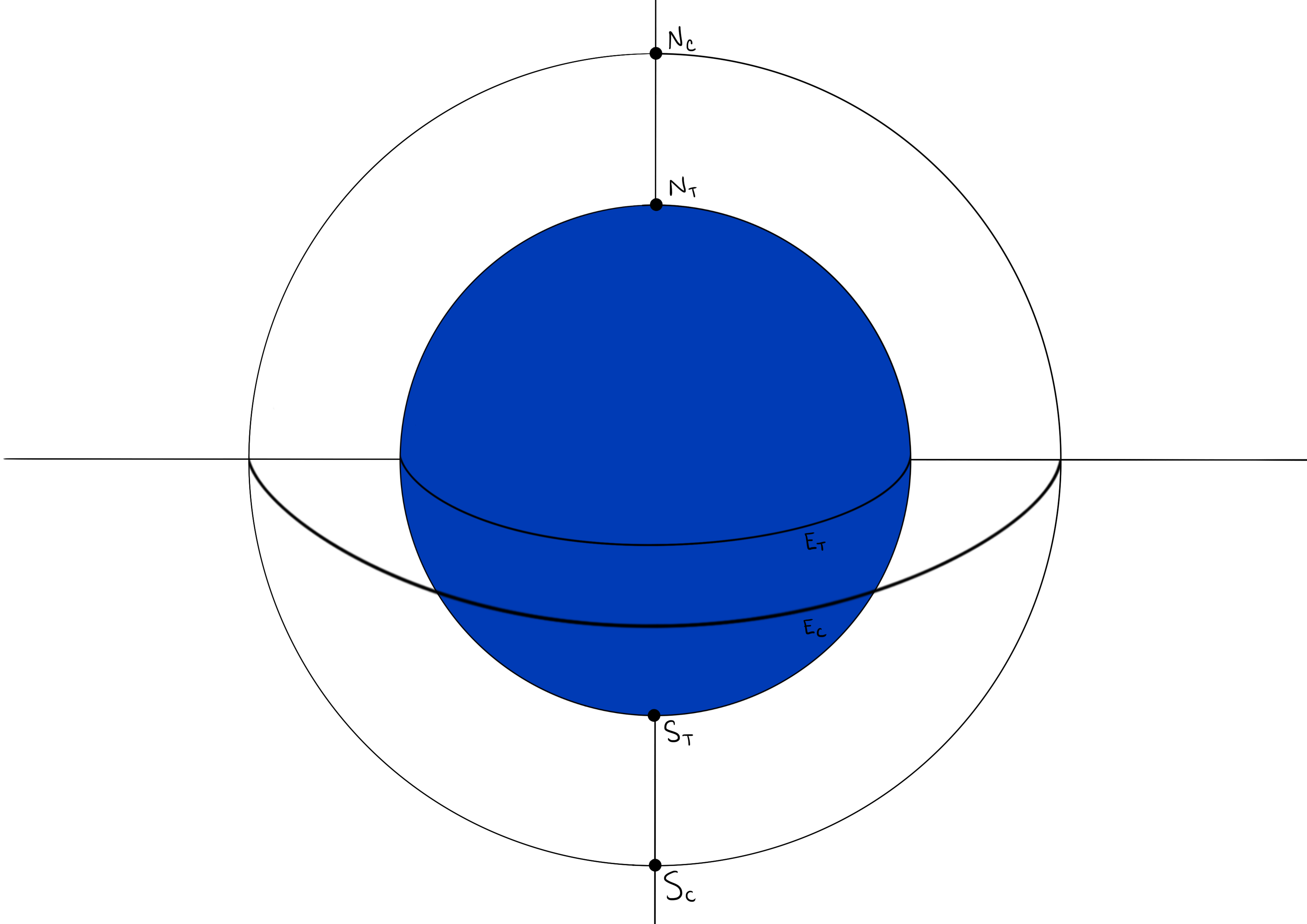
In the above diagram, Nc and Nt mark the North celestial and North terrestrial poles; Et and Ec mark the terrestrial and celestial equator; and St and Sc mark the South terrestrial and South celestial poles. The poles are points while the equator is a plane.
The Ptolemaic system which Dante inherits begins with a few initial postulates about the Earth:
(1) the center of the Earth is the center of the universe
(2) the Earth is a sphere
(3) the Earth is unmoving
These postulates were derived from observing the movements of the planets and stars over long periods of time and drawing conclusions from recurrent patterns. The Ptolemaic model persisted with some amendments until the time of Galileo, and though Ptolemaic astronomy has limits and flaws, it was (and still is) a useful theoretical model for tracking and predicting the movement of the stars and planets in the night sky.
Note that the Sun and the Moon are both considered to be planets in this framework. This system views the planets as “ wandering stars ,” a category which comprises the seven bodies which appear to exhibit a second, westward motion counter to the eastward motion of everything in the sky. Of course, today we know that everything in the sky appears to move from east to west due to the Earth’s rotation; in Dante’s time and prior, this movement was considered an essential quality of the celestial bodies and spheres. Along with the Sun and Moon, the other wandering stars are the five planets visible to the naked eye: Mercury, Venus, Mars, Jupiter, and Saturn (Neptune, Uranus, and Pluto are not visible without a telescope and as such had not yet been discovered). The term wandering stars is a distinction from what we would call constellations, which do not appear to ‘wander’ but instead only exhibit the shared easterly motion. The constellations are referred to as the “ fixed stars ,” for they do not wander. [ For more on the terminology “wandering stars” and “fixed stars,” see note below. ]
The fixed and wandering stars are taken to be located on a series of concentric and diaphanous heavenly spheres. The celestial bodies are ordered in the following manner, according to the size of their apparent rotation about the Earth: (1) Moon; (2) Mercury; (3) Venus; (4) Sun; (5) Mars; (6) Jupiter; (7) Saturn; (8) Heaven of the Fixed Stars. The planets and stars are taken to be located on the surface of the spheres which they inhabit. With the Earth at the center, these spheres are nestled like Russian dolls within the heaven of the fixed stars. Further, the north-south axis of the Earth is in perfect alignment with the north-south axis of the celestial sphere, meaning that the celestial poles stand in alignment to the terrestrial poles–and this is necessarily the case since it is the rotation of the Earth which gives the appearances of rotation to the heavens. Accordingly, the Earth’s equator and the celestial equator are concentric circles and are parallel.

As previously mentioned, the wandering stars appear to travel counter to the eastward rotation of the universe. This movement occurs along one the belt of the ecliptic . Each of the wandering stars travels this path, and takes a different amount of time to do so. The Moon is the fastest, and Saturn is the slowest. The ecliptic is concentric to the Earth’s equator and the celestial equator, but it is not parallel to them. The ecliptic is on an angle of approximately 23.4 degrees with respect to the equators. Dante describes the ecliptic as “torta” in both the Commedia and the Convivio , in reference to this distortion with respect to the equator (See Paradiso 10.16; Convivio 3.5.13). Since the ecliptic is on an angle with respect to the equator, the planets appear to move between the hemispheres. When the Sun appears to be in the northern hemisphere, the northern hemisphere experiences its spring and summer. Likewise, when it shifts into the southern hemisphere, the northern hemisphere experiences its fall and winter. The ecliptic intersects the equator at two points: the “first point of Aries” and the “first point of Libra.”
Due to a phenomenon known as “precession of the equinoxes” (first discovered by the Greek astronomer Hipparchus), the constellations appear to slip gradually across the sky. Today we know this to be caused by the Earth’s wobbling as it rotates; the result of this phenomenon is that the section of sky through which the planets appear to wander has shifted a bit since the ancient inception of astronomy and astrology. Though it is no more the case, it used to be so aligned that the path of the wandering stars covered the belt of the Zodiac, or the twelve constellations: Aries, Taurus, Gemini, Cancer, Leo, Virgo, Libra, Scorpio, Sagittarius, Capricorn, Aquarius, Pisces. Despite precession, astrological tradition still acknowledges the ‘signs’ of the constellations as fixed positions in the sky: the constellation Aries, for example, is no longer located at the the vernal equinox, but the sign of Aries is still recognized as the 30-degree section of the ecliptic whose beginning is marked by the first day of spring.
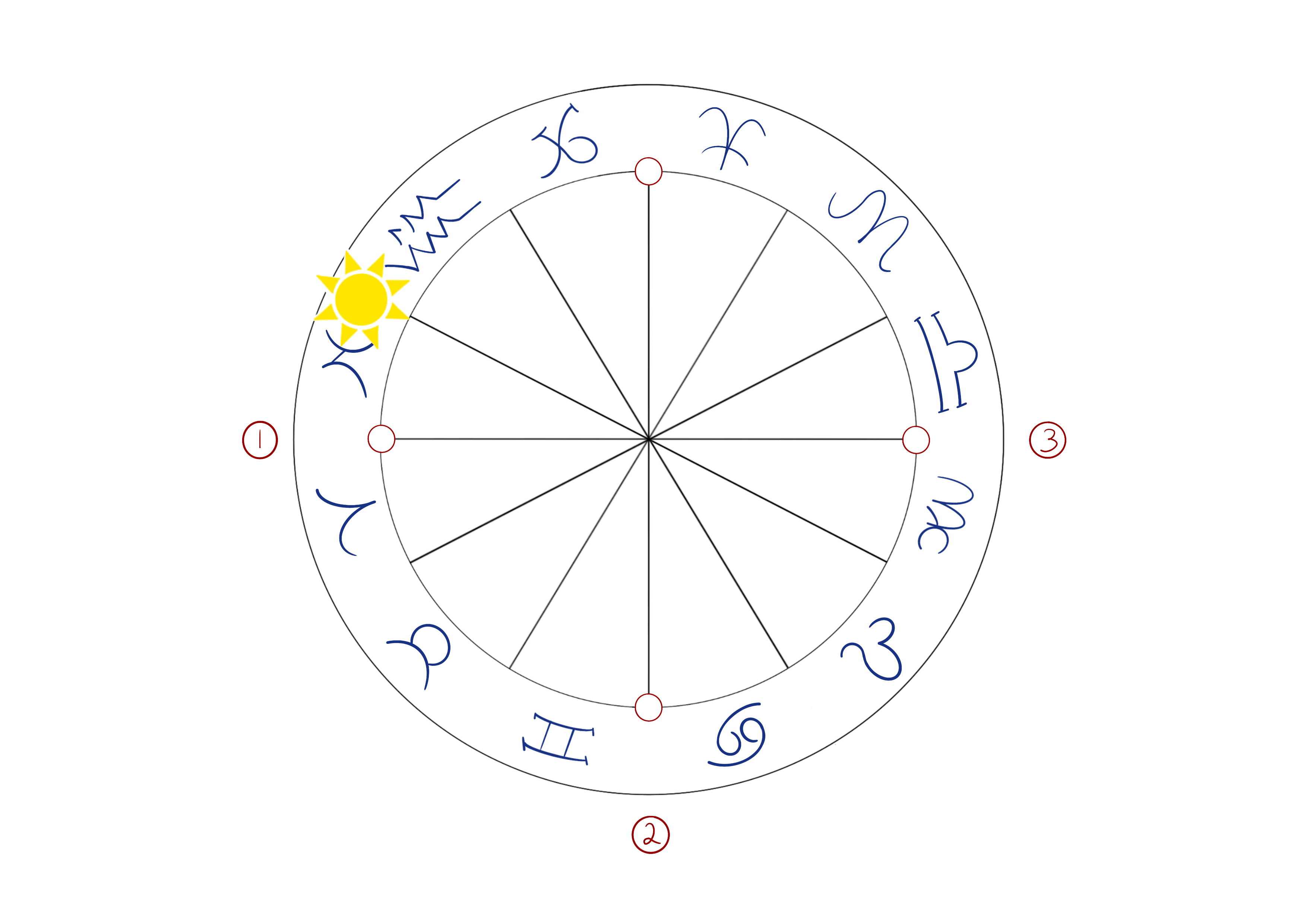
This is one way of imagining the wandering stars moving about the Earth.
Note that ecliptic is a circle, meaning it contains 360 degrees and as previously mentioned comprises the 12 signs. Each constellation accordingly comprises 30 degrees of the circle. The constellations of Aries, Cancer, Libra, and Capricorn mark particular points along this circle because, when the sun appears to enter into one of them, we note the change of a season: in the northern hemisphere Aries is the start of spring, Cancer of summer, Libra of fall, and Capricorn of winter.
As previously mentioned, the “first point of Aries” is one of two points where the ecliptic and equator intersect, these two intersecting points being the equinoxes . For the northern hemisphere, when the sun crosses the first point of Aries, night and day are equal (hence “equi-nox”). As the sun moves further into the northern hemisphere, the days grow longer until the summer solstice , the day on which the sun appears to stand still (hence “sol-stit”) before beginning its descent back to the southern hemisphere, during which time the days grow shorter. After the solstice, the sun descends to the “first point of Libra,” or the autumnal equinox , when, again, day and night are equal. On this day the Sun reaches the southern hemisphere again. It will descend further into the southern hemisphere until the winter solstice , after which it will begin to ascend again and return to the first point of Aries, starting the cycle anew. Dante explains this exact process in detail in Convivio 3.5.
From the perspective of the southern hemisphere, the first point of Aries represents the autumnal equinox, and the seasons are precisely opposite.
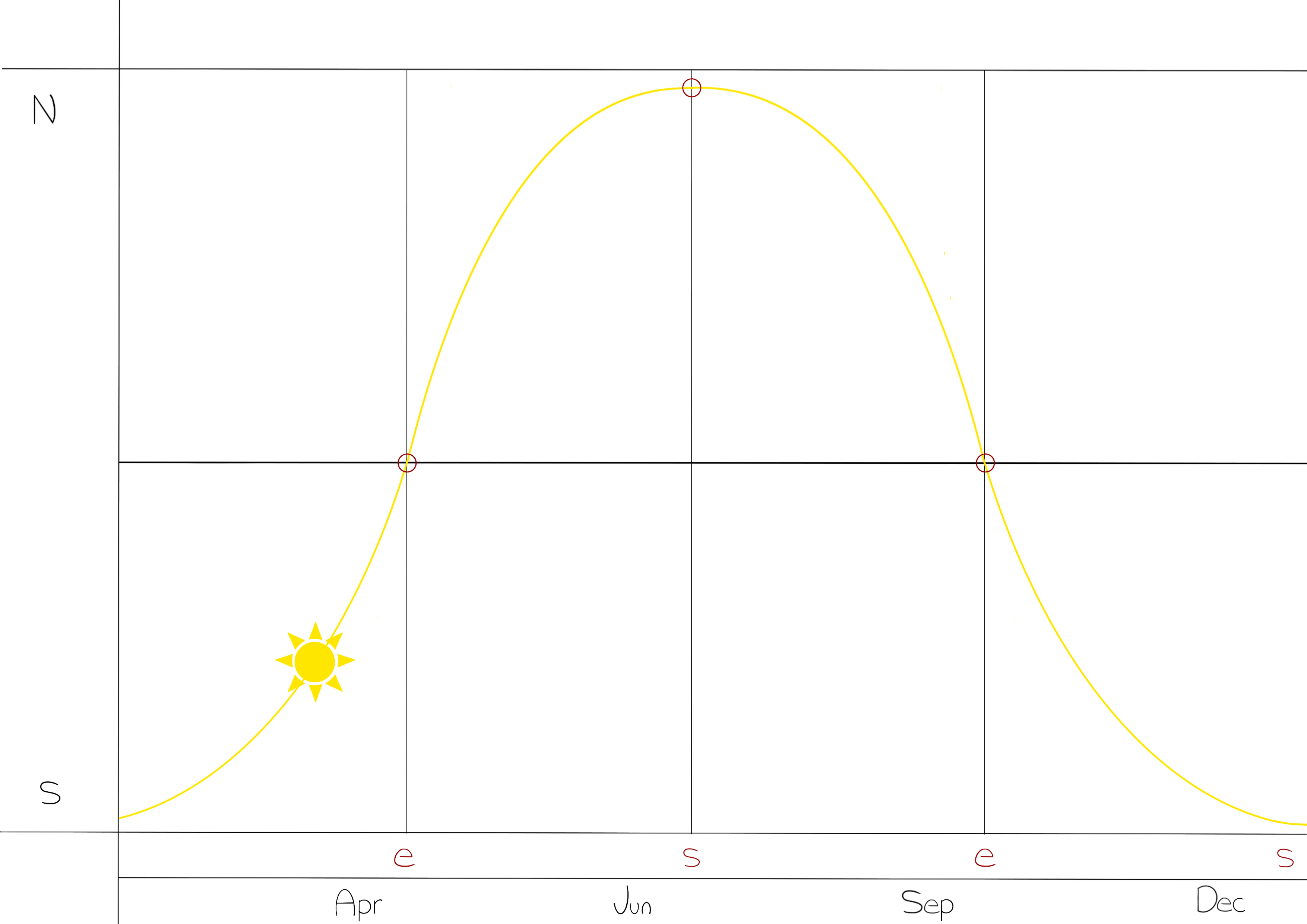
This is another way of imagining the movement of the Sun along the ecliptic.
Six of the constellations are located in the northern hemisphere: Aries, Taurus, Gemini, Cancer, Leo, and Virgo; and six in the southern hemisphere: Libra, Scorpio, Sagittarius, Capricorn, Aquarius, and Pisces.
Cancer is the northernmost constellation, at the height of the Ecliptic, approximately 23.4 degrees north of the line of the equator. Capricorn, which stands 180 degrees opposite to Cancer, is the southernmost, approximately 23.4 degrees south of the equator. If an observer were to sit on the Equator and mark the position of the Sun once a day, at the same time every day for a year, they would see the sun gradually rise 23.4 degrees from the vernal equinox until the summer solstice; descend 23.4 degrees from the summer solstice to the autumnal equinox; descend another 23.4 degrees until the winter solstice; and ascend again, returning to the vernal equinox. If the observer captured a picture of the Sun at the same time every day for a year and put them all together, it would form an analemma , or a figure-8 in the sky.
A note on the terminology “fixed stars” versus “wandering stars” from Plato’s Timaeus , Isidore’s Etymologia , and Dante’s Convivio
The distinction of “wandering” versus “fixed” stars is common terminology used by astrologers and astronomers in the medieval period. Accordingly, Dante will use the terms pianeta and stelle fisse in reference to these entities in the cosmos. In English, the best rendering of these two terms is “wandering stars” and “fixed stars,” respectively, since the English “planet,” to modern readers of Dante, will implicitly exclude the Sun and the Moon.
Fundamentally, the term “wandering star” is a reference to the unique motion of the seven objects in our solar system which move along the Ecliptic: the Moon, Mercury, Venus, the Sun, Mars, Jupiter, and Saturn. These are understood in contrast with the constellations, which remain fixed in the background on the celestial sphere as the planets “wander.” The distinction originates with the Greek philosophers, who called the stars that moved along the Ecliptic πλανήτης or “wandering ones,” which, in Latin, later became planetae .
In Plato’s Timaeus , which Dante will reference in Paradiso 4, these two distinct kinds of movement are addressed at some length as Timaeus recounts the story of the creation of the universe.
Next, he [the creator of the universe] sliced this entire compound in two along its length, joined the two halves together center to center like an X, and bent them back in a circle, attaching each half to itself end to end and to the ends of the other half at the point opposite to the one where they had been joined together. He then included them in that motion which revolves in the same place without variation, and began to make the one the outer, and the other the inner circle. And he decreed that the outer movement should be the movement of the Same , while the inner one should be that of the Different . […] and he made the revolution of the Same, i.e. the uniform, the dominant one in that he left this one alone undivided, while he divided the inner one six times, to make seven unequal circles. (36c-d)
Here, Timaeus’s terminology, “the movement of the Same ,” accords to the rotation of the heavens about the celestial axis, or the way that the Sun and the other stars appear to rise and set over the line of the horizon on a daily basis. On the other hand, “[the movement] of the Different ,” is a reference to the varied movement of all the wandering stars along the Ecliptic. Indeed, the description of the fashioning of a shape that resembles an X with the ends bent back and attached in circles is precisely the manner in which astrologers and astronomers depict the lines of the equator and the Ecliptic in the Ptolemaic system (see diagram for Inferno 1 for a visual representation of this).
Timaeus goes on:
Such was the reason, then, such the god’s design for the coming to be of time, that he brought into being the Sun, the Moon, and five other stars, for the begetting of time. These are called “ wanderers ,” ( πλανητά ) and they came to be in order to set the limits to and stand guard over the numbers of time. When god had finished making a body for each of them, he placed them into the orbits traced by the period of the Different—seven bodies in seven orbits. (38c-d)
The language in the Timaeus addresses the dual movement of the heavens as that of sameness and difference: “the movement of the Same” is the diurnal motion about the celestial axis, which is shared by everything in the sky, while “[the movement] of the Different” is the movement of the seven wandering stars along the line of the Ecliptic. As Timaeus serves to underscore, linguistically speaking, the Greek term πλανήτης is a reference to the unique movement observed in the motion of these particular seven stars in the sky (cf. Liddel, πλανάω , “to make to wander, lead wandering about” or, when passive, “to wander, to roam about, stray”).
Dante did not read Greek, however. To trace how the terminology reaches Dante, we can consult Isidore, who, in Book III of the Etymologiae , expands on the concept:
De Sphaerae Caelestis Situ.
Philosophi autem mundi septem caeolos, id est planetas , globorum consono motu introduxerunt, quorum orbibus conexa memorant omnia, quos sibi innexos et velut insertos versari retro et [e] contrario ceteris motu ferri arbitrantur. (xxxii)
[The philosophers have proposed seven heavens belonging to the universe, that is, seven planets , from the coordinated motion of their spheres. They hold that everything is connected to the orbital paths of these planets, and they think that the planets are interconnected and in a way inserted within one another, and that they turn backwards and are carried by a motion that is opposite to the other heavenly bodies. (Barney, et al. translation)]
De Stellis Planetis.
Quaedam stellae ideo planetae dicuntur, id est errantes , quia per totum mundum vario motu discurrunt. Unde pro eo, quod errant, retrograde dicuntur, vel anomala efficiuntur, id est, quando particulas addunt et detrahunt. (lxviii)
[Certain stars are called planets , that is, ‘ wandering ones ,’ because they range through the entire cosmos with a varying motion. It is because of their wandering that they are called retrograde, or are rendered irregular when they add or subtract orbital degrees. (Barney, et al. translation)]
The Latin planetas , as Isidore underscores, is a term derived from the Greek philosophic tradition.Thus, the “wandering” exhibited by the seven “planets” is the characteristic that distinguishes them from all the other stars in the sky, which sit still, or “fixed,” on the backdrop of the celestial sphere. In summation: every light in the sky shares in what Timaeus calls “the movement of the Same,” but only the planetae exhibit the movement of “the Different.” This distinction in the motion of the stars is what will ultimately lead Dante, among others, to posit the manifold spheres that comprise the physical cosmos and develop the cosmological system that grounds the entirety of Paradiso .
Dante in the Convivio will refer to the constellations as le stelle fisse (cf. 2.3.3 and 2.14.7). Accordingly, he will at times use the term pianeta , meaning a star which wanders (2.13.7 and 2.13.28), when treating the “planets,” while at other times he will refer to them simply as “stella”—as in “la stella di Venere” (2.2.1); “la stella di Marte” (2.13.22); or “Giove è stella di temperata complessione” (2.13.25). Throughout the Commedia , as we will see, he employs the same terminology: stelle fisse for the fixed stars, and pianeta or stella for the wandering stars. Dante does not, however, use the term “stella errante” or any such terminology. I use this terminology in English to make it clear that the Sun and the Moon are included in the medieval discourse on planets, despite the fact that today we do not consider them to be such.
Alighieri, Dante. Convivio . edited by Gianfranco Fioravanti. Mondadori, 2019.
Isidore of Seville, Saint. Isidori Hispalensis Episcopi Etymologiarum Sive Originum Libri XX . edited by W. M. (Wallace Martin) Lindsay. Clarendon Press, 1911.
Isidore of Seville, Saint. The Etymologies of Isidore of Seville . edited and translated by Stephen A. Barney, W. J. Lewis, J. A. Bach, and Oliver Berghof. Cambridge University Press, 2006.
Kay, Richard. Dante’s Christian Astrology. University of Pennsylvania Press, 1994.
Liddell, Henry George. A Greek-English Lexicon. Clarendon Press, 1901.Moore, Edward. Studies in Dante. Third Series. Miscellaneous Essays . Clarendon Press, 1903.
Plato. “Timaeus” in Complete Works . edited by John M. Cooper and D.S. Hutchinson. Hackett Publishing Company, 1997.
Recommended Citation : Moffa, Jr., Louis J. “Diagramming Dante: Astronomy in the Commedia .” Digital Dante . Columbia University Libraries, 2020. https://digitaldante.columbia.edu/moffa-astronomy / .

Wandering stars: A brief history of defining ‘planet’
From wandering star to earth-orbiter, the word ‘planet’ has changed its meaning many times. pluto’s exile is only the most recent..

Illustration by Nichla Smith
If words have power, then the word ‘planet’ must be one of the most powerful in the space community. Whether the subject is the planets in our solar system, dwarf planets like Pluto or Ceres, or exoplanets orbiting other stars, the public is automatically interested. According to planetary scientist and New Horizons ’ principal investigator, Dr Alan Stern, this is because “people don’t live on black holes, or active galactic nuclei, or asteroids: they live on a planet. It’s important to them because that’s where they live.”
I've always found the possibility of other worlds to be both inspirational and humbling. To think that there are planets upon planets waiting out there to be discovered, reminds me of the beautiful mystery of the universe that can both fuel and overwhelm the beautiful mystery of the human brain.
– Laura, 23, writer and hostess
Humans have observed planets for at least four thousand years. We know that ancient Babylonian astronomers recorded the cycles of Venus, Mercury, Mars, Jupiter, and Saturn, ascribing meanings to their positions in the sky. Occasionally, the sun and moon were also included in this list of planets visible to the naked eye. Each planet — including the sun and moon — was associated with a god: Mercury was associated with the god of wisdom, Venus with the goddess of love and war, and the Sun with the god of justice, and so on.
This fascination with planets was not unique to the Babylonians. For nearly all of recorded human history, people have ascribed special importance to planets. As Dr Jean-Luc Margot, an astronomer and professor at UCLA, put it, “For thousands of years, people have noticed that these planets are different. That may be why it’s built in to our culture that these objects are special. The sort of objects that, initially, we could see with our naked eye in the night sky, that behaved differently from the stars.”

The Venus Tablet of Ammisaduqa contains a record of the rise and set times of Venus on the horizon in the seventeenth century BC. Wikimedia Commons (CC BY-SA 3.0)
I like planets because they're a changing part of the night sky. I like trying to identify them. I love conjunctions… It's like, ‘here are two objects which do not have much to do with each other at all actually, but you can see them together when usually you can't!’
– Anna, 31, software engineer
The first known use of the word ‘planet’ in English, according to the Oxford English Dictionary , was in the year 1300 in an account of the lives of Christian saints. In other languages, though, the word dates back much further. The word ‘planet’ comes from the ancient Greek ἀστήρ πλανήτης (astēr planētēs), meaning ‘wandering star’. The ancient Greeks, like the Babylonians, associated the planets with gods, often corresponding with the Babylonian pairings. Other ancient societies, like those in China and India, also connected planets with personal attributes and predictions of future events, in what would later be referred to as astrology.
In the fourth century BC, astronomy became more quantitative, focusing on the scientific and mathematical side of observing the universe beyond Earth. This specialisation split astronomy from astrology and religion. Astrology dealt with the symbolic associations between the planets and everyday life as it still does, largely unchanged, to this day. Astronomers, however, studied the planets using observations and mathematics, determining how far each was from Earth and predicting their paths across the sky.
Planets represent the possibility of a new home for the human race in some distant future — a possibility that seems all the more important as evidence mounts that we might be destroying our planet's environment, or at the least, we know it will not last forever.
– Mark, 50, Associate Professor of History
In the early 16th century, the word ‘planet’ suddenly became much more specialised. Instead of denoting anything that moved with respect to the stars, ‘planet’ meant only objects that orbited the Earth. The same planets the Babylonians knew of, their moons, and Earth itself were included. While the Sun was still widely thought to orbit the Earth, it was no longer considered a planet, as the evidence that it was actually a star continued to grow. By the late 17th century, when the public started to accept astronomers’ realisation that planets orbited the sun, the name had stuck. The moon, since it did not orbit the sun, was struck from the list of planets.
The 19th century brought a crackdown on planets. With just eleven objects categorised as planets (Mercury, Venus, Earth, Mars, Jupiter, Saturn and Uranus, as well as Vesta, Juno, Ceres, and Pallas), the working definition became dependent on size. Those objects too small to make the cut were downgraded to ‘asteroids’. One might think that this would be a fine line (especially given modern debates over Pluto), but it was not. The largest object to be reclassified, Ceres, was less than one three-hundredth the mass of the smallest planet: Mercury. Also, all of the objects that were reclassified shared similar orbits in what is now called the asteroid belt, between Mars and Jupiter. Shortly after this mass reclassification, in 1846 , Neptune was observed for the first time.

In the 19th century, objects that were too small lost their planet status and reclassified as asteroids. Artist impression of asteroid belt. NASA/JPL-Caltech/Wikimedia Commons (public domain)
The last object to be officially added to the list of planets was Pluto . A planet beyond Neptune had been theorised for some time before Clyde Tombaugh actually saw Pluto in 1930, as slight wobbles in the orbits of the outer planets suggested a body larger than Earth lay beyond them. In 1915, estimates put Pluto’s mass at about seven times that of Earth. Now we know that Pluto’s mass is only about one five-hundredth that of Earth. It’s easy to see, then, why Pluto was initiated as a planet without question, and also why that confidence in its planethood waned with time.
A planet is big and round and it can be lots of different colours.
– Olive, 5
In 2006, though, the word ‘planet’ underwent its first major transformation since the reclassification of the asteroid. The International Astronomical Union (IAU), a group of astronomers charged with standardising the names and designations of astronomical objects, decided it was time for a change, stating : “The word ‘planet’ originally described ‘wanderers’ that were known only as moving lights in the sky. Recent discoveries lead us to create a new definition, which we can make using currently available scientific information.” They issued a formal definition of the word ‘planet’ with a new set of criteria. According to the IAU, a planet must: orbit the Sun, have enough mass to remain approximately round due to its own gravity (the hydrostatic equilibrium criterion), and have cleared its orbit of other objects (the dynamical dominance criterion).

The New World Order: papier m â ch é school diagrams just got a little harder. Farry/Wikimedia Commons (public domain)
In the same resolution, the IAU defined a dwarf planet as an object that directly orbits the sun (and thus isn’t a moon), has enough mass, but has not cleared its orbit. Essentially, a dwarf planet is a planet that still smashes into lots of things as it orbits the sun. Because it’s not big enough to obliterate or absorb them, it hits them like a tetherball every time it goes around.
It seems like all of the things that we use to classify a planet a planet causes the classification of 'planet' to align with the properties of the rock we call home... We humans use what we know as a ruler, so when it comes to planets, I'm quite fond of them, because that's where we live — on a planet.
– Tim, 38, student and mechanical designer
These new IAU definitions have been controversial. Dr Margot described the new definition of ‘planet’ as being “problematic in a few ways. One is that it applies only to our solar system: that’s a problem. And two, it is not quantitative: that’s a problem. And there is, in fact, a third problem, which is that it relies on some idea of roundness, which is not observable, not easily quantifiable, and it’s inherently problematic as a classification tool.” Dr Margot, along with many other scientists, prefers the criterion of dynamical dominance: if an object orbits a star and has cleared its orbit, it is a planet. “The nice thing about dynamical dominance is that we can show fairly easily that any object that is dynamically dominant is going to be round, just because it has enough mass,” he insisted. That makes it simply another measurement of size and mass that sets a higher bar than the hydrostatic equilibrium criterion.
Dr Stern takes exception to the IAU’s definition of ‘planet.’ He prefers the geophysical planet definition, in which any object with enough mass to become round (the hydrostatic equilibrium criterion), but not enough to cause nuclear fusion (which would make it a star), is a planet. The result, he said, is that “you end up with a very large number of planets, in our solar system and in others, as a result. But we’ve just got to get used to the data that there are a lot of planets and that most of them are this really tiny type like Pluto.”

Pluto’s demotion from the planet club had some Pluto lovers up in arms. Why are planets so important to us? Javacolleen/Flickr (CC BY-NC-ND 2.0)
Pluto’s exclusion from the 'planet club' has caused some degree of public outrage. There have been petitions, “ Save Pluto ” movements, and even outright refusal to believe that Pluto is not a planet. Dr Margot said that “50 years from now, I fully expect that people will not care that Pluto is no longer a planet, just like we no longer care that Ceres and Vesta and Pallas are no longer planets.”
I like planets because they're all so different, so each one expands our knowledge of how varied the universe is.
– Jason, 65, retired
Along with many other scientists, Dr Sarah Hörst, assistant professor of Planetary Science at John Hopkins University, “[doesn’t] particularly care one way or another if people consider ‘dwarf’ an adjective or if people are adamant that dwarf planets aren't planets.” Dr Stern, on the other hand, disagrees. When he coined the term 'dwarf planet' in 1991, it was meant as a description analogous to those we use for stars: “Did you know the sun is a dwarf star? That doesn’t make it not a star, does it? It just means that it’s a small star compared to giant stars, and Pluto is a small planet compared to giant planets.”
Regardless of the IAU’s categorisation of Pluto, its definition certainly needs some work: no one will argue that extrasolar planets or exoplanets, which orbit other stars, are not planets. However, excluded by the IAU’s definition, they remain officially uncategorised by the scientific community. The classification scheme for exoplanets remains fairly casual, relying on comparative classifications like 'hot Jupiter' or 'super-Earth.' Even though we can’t see most of these planets yet, classification would simplify and clarify the language astronomers use to describe them. “It wouldn’t serve us very well if we had a classification that required us to wait thousands of years until we can get to the planet, see what it looks like, and then decide whether it’s a planet or not,” Dr Margot explained.

Our traditional meaning of the word planet hasn’t always meant what we think it has. But changing knowledge ingrained in primary school is never easy. Eden, Janine and Jim/Flickr (CC BY 2.0)
They're interesting because we haven't ever had manned missions to any planets. We only have gotten pictures from space probes, and we could get more information about them if we had people looking at them. And we don't, so we don't get as much information. Basically, if we didn't have planets, we couldn't live. ‘Cause we live on a planet. ‘Cause usually when you think of space you don't usually think of Earth. But Earth is a planet.
– Archie, 7, aspiring astronomer
Dr Hörst put it most simply: “The definition might need to evolve; history certainly tells us that our understanding of the solar system and the universe is incomplete at best.” The language that we use is constantly evolving: the word 'galaxy' comes from the Greek for 'milk,' and the only remaining reminder of that is the name of our galaxy, the Milky Way. Perhaps in another thousand years, the original meaning of ‘planet’ will be nearly forgotten, too. We will almost certainly discover new astronomical bodies, and with those new discoveries will come new names.
Regardless of whether they are planets, dwarf planets, exoplanets, or simply 'worlds,' as many scientists have taken to using as an umbrella term, humans will always be fascinated by them. On that, the astronomers all agree. As Dr Hörst said, “People love planets! People love the unknown, the unexplored, the weird, the beautiful, the different. Planets are all of those things. But so are asteroids and Kuiper Belt Objects and moons.” Classifying these objects is important to how we discuss them, and the word ‘planet’ has a rich and dynamic history. But when we look at those objects — planets or not — from down here on Earth, what matters most is the awe, fascination, and scientific inquiry that they inspire.
Edited by Bryonie Scott and Tessa Evans, and supported by Sam Brentnall.
By Leah Crane
Recent articles.

Current Issue

February/March 2019
Previous Issues

December 2018/January 2019

October/November 2018

August/September 2018

June/July 2018

April/May 2018

February/March 2018

August 2017

June/July 2017

February 2017

January 2017

December 2016

November 2016

October 2016

September 2016

August 2016

February 2016

January 2016

December 2015

November 2015

October 2015

September 2015

August 2015

SITE SETTINGS

WHAT IS A WANDERING STAR?
Wandering stars, also called ‘intergalactic stars’, ‘intracluster stars’ or ‘rogue stars’, are stars that are not gravitationally tied to a par ticular galaxy – they exist between galaxies. These stars, first discovered in 1997, probably formed inside galaxies, but were later expelled, perhaps during galaxy mergers or by a close encounter with a supermassive black hole. Astronomers estimate that rogue stars comprise between 15–50 per cent of all stars in galaxy clusters. The Virgo galaxy cluster, for example, contains perhaps 1 trillion rogue stars! Closer to home, at least 675 rogue stars have been found between the Milk y Way and the Andromeda Galaxy. AG

This article is from...

Other Articles in this Issue
Basket - 0 items.


Living Stream Ministry
Publisher of watchman nee & witness lee.
- « Back
- WANDERING STARS
Finding Christ by the Living Star, by Witness Lee
More excerpts from this title....
- LIVING REVELATION
- THE WISE MEN ’S MISTAKE
- ANOTHER WAY
- NICODEMUS AND THE PHARISEES
- AFTER THE SPIRIT
- THE STAR IN THE CHURCHES
- HOW TO BECOME STARS
( Finding Christ by the Living Star , Chapter 1, by Witness Lee)
- Read from the full text of this book
- Share by email
- Link to this page (copy/paste): http://www.ministrysamples.org/excerpts/WANDERING-STARS.HTML
Other Reading Online
- Online Publications
- Create a Scheduled Reading Plan
- Electronic Publications (Kindle, EPUB, iSilo)
- Online Recovery Version
About Living Stream Ministry
Living Stream Ministry publishes the works of Watchman Nee and Witness Lee, providing the authoritative and definitive collections of treasures from these two servants of the Lord Jesus Christ. The writings of Watchman Nee and Witness Lee focus on the enjoyment of the divine life, which all the believers possess, and on the building up of the church, the goal of God's work with man in this age.
- Witness Lee Excerpts
- Watchman Nee Excerpts
- All Online Publications
- Other LSM Websites
© 2014 Living Stream Ministry. All rights reserved. Reproduction in whole or in part without permission is prohibited.
Contact Us | Sitemap | Copyright Policy
Wander vs. Wonder: How To Use Each Word
- Wonder Vs. Wander
⚡ Quick summary
The verb wander (pronounced [ won -der ]) typically means “to roam” or “to meander.” The word wonder (pronounced [ wuhn -der ]) is typically used as a verb to mean “to think curiously,” “to be amazed,” or “to doubt.” As a noun, it’s used to mean “something strange and surprising,” “a miraculous deed or event,” or “the emotion excited by what is strange and surprising.”
The words wander and wonder look very similar, but they have very different meanings and uses.
In this article, we will define wander and wonder , explain how we use them differently, and provide example sentences that show how we typically use them in sentences.
wonder vs. wander
The word wonder (pronounced [ wuhn -der ]) is used as a verb and a noun. As a verb, it typically means “to think curiously,” “to be amazed,” or “to doubt.”
For example:
- I wonder what will happen at the party this weekend.
- They wondered at the amazing acrobatics of the circus performers.
- I wonder if Oscar can really speak Spanish like he claims.
Wonder is also used as a noun to mean “something strange and surprising,” “a miraculous deed or event,” or “the emotion excited by what is strange and surprising.”
- The collection was filled with wonders from around the world.
- The magician was able to perform such wonders as turning dirt into gold.
- We were filled with wonder as we watched the firework show.
Go Behind The Words!
- By clicking "Sign Up", you are accepting Dictionary.com Terms & Conditions and Privacy policies.
- Comments This field is for validation purposes and should be left unchanged.
The word wander (pronounced [ won -der ]) is typically used as a verb to mean “to move about without a set path, to roam,” “to follow a circuitous route, to meander,” and “to take a direction without conscious intent, as with thoughts,” as well as several other similar meanings.
- She wandered through the woods for a while before she found a lake.
- The story started out good, but then it wandered off into a confusing mess.
- He was so bored that his mind began to wander into thoughts of lunch.
It is possible to use the word wander as a noun, but this usage is rare. Instead, the noun sense of wandering is much more likely to be used. By contrast, both the noun and verb sense of wonder are commonly used.
Examples of wander and wonder in a sentence
Let’s amble into some amazing sentences that show how we typically use wander and wonder .
- They got lost on the way to the pool and wandered into the sauna.
- As a kid, I always wondered about how different machines worked.
- The president wandered off on a tangent about pizza before getting back to his speech.
- The wizard’s tower was full of magical wonders, including a flying carpet.
- We were full of wonder as we wandered through the science museum.
Don't wander off course when learning how to distinguish "coarse" from "course."
Commonly Confused

Trending Words
[ ur -goh ]
- Phone This field is for validation purposes and should be left unchanged.
Explore Jobs
- Jobs Near Me
- Remote Jobs
- Full Time Jobs
- Part Time Jobs
- Entry Level Jobs
- Work From Home Jobs
Find Specific Jobs
- $15 Per Hour Jobs
- $20 Per Hour Jobs
- Hiring Immediately Jobs
- High School Jobs
- H1b Visa Jobs
Explore Careers
- Business And Financial
- Architecture And Engineering
- Computer And Mathematical
Explore Professions
- What They Do
- Certifications
- Demographics
Best Companies
- Health Care
- Fortune 500
Explore Companies
- CEO And Executies
- Resume Builder
- Career Advice
- Explore Majors
- Questions And Answers
- Interview Questions
How To Use The STAR Method To Answer Interview Questions (With Example Answers)
- Interview Preparation Checklist
- Star Method For Answering Questions
- Star Interview Questions
- Words To Use In An Interview
- Mock Interview Preparation
- How To Make A Good Impression
- Bring Writing Samples
- How To Relax Before An Interview
- Interview Coaching
- Common Video Interview Mistakes
- Common Phone Interview Mistakes
- How To Ace Your Interview For A Remote Job
- Good Weaknesses For A Job Interview
- Good Strengths For A Job Interview
- Talk About Being Laid Off
- How To Prepare For A Phone Interview
- How To Decline An Interview
- How Early Should You Arrive For An Interview
Find a Job You Really Want In
It’s essential to know how to use the STAR method to answer situational and behavioral interview questions . To use it, explain the situation you were facing, your task in the situation, what you did to complete that task, and the result of your actions.
To help you understand the STAR interview questions method and use this in your next interview, we’ll go over how to use the STAR method to answer interview questions, provide some example answers, as well as some tips to keep in mind when answering situational and behavioral interview questions.
Key Takeaways
The STAR method stands for situation, task, action, and result.
Use the STAR method to answer situational interview questions.
A situational or behavioral interview question asks for an example of how you’ve approached a situation in the past.

What is the STAR method?
20 example questions and answers using the star method, how to prepare for star interview questions, common mistakes when using the star method, tips for using the star interview response method, what are behavioral interview questions, how to use the star method in an interview faq.
- Sign Up For More Advice and Jobs
The STAR method, which stands for situation, task, action, and result, is a framework for answering behavioral interview questions so that you hit the points the interviewer is looking for while keeping your response succinct and easy to follow. This is especially helpful to have when you’re asked questions that require a story or a hypothetical response.
The four points of answers that use the STAR method are:
Situation. The first thing you should do when you’re answering a behavioral interview question is set the scene of your story. Describe a relevant work situation. Make sure to describe a specific instance and not just a general responsibility. This should take the least amount of time in your answer.
STAR Method Situation Example Answer Our sales teams’ conversion rate on cold calls was way down for the quarter.
Task. This is the part where you explain what your job was in this situation. Did you have to meet a deadline, double your results, or solve a conflict?
STAR Method Task Example Answer Our sales manager told us to work on a strategy for increasing our conversion rate by 20% for the next quarter.
Action. Now you’re getting to the part that actually answers the question. Explain what steps you took to complete your task and solve the problem. This should be the most in-depth part of your answer.
STAR Method Action Example Answer I got together with other sales reps and we came up with a quantitative and qualitative list of reasons why customers weren’t interested in our products. We found that our entry-level price point was too big a bar for small companies and folks frequently cited a lack of proficiency with our software as concerning. We put together a report for the sales manager and I showed her that these were the two biggest sticking points for hesitant customers. She was able to get the software team to put together a free basic trial package and also had marketing put together training materials to help users get more comfortable using our software.
Result. Wrap up your story by sharing the result of your efforts. This can be what you accomplished, but it can also be what you learned, especially if you’re talking about a failure.
STAR Method Result Example Answer These changes made a massive impact on sales that quarter. We more than doubled our goal of increasing our conversion rate by 20%.
If you’re the interviewer in this situation, here is some more information about how to assess candidates using the STAR method .
To help you get a handle on how to use this method effectively, here are some common star interview questions and answers examples that might be asked in an interview:
Tell me about a challenge or conflict you’ve faced at work . How did you handle it?
Challenge at Work STAR Method Example Answer Situation: “A coworker who I regularly worked with on projects was out sick for a week and a half.” Task: “I had to figure out how to finish our projects on time without her.” Action: “I first created a timeline with all the tasks I had to complete. Then I blocked off time in my schedule to dedicate to working on the project.” Result: “Through hard work and prioritizing tasks, I was able to successfully finish the project on time.”
Have you ever had to make an unpopular decision? How did you handle it?
Unpopular Decision STAR Method Example Answer Situation: “ My manager put me in charge of a team project and we were down to the wire on meeting a deadline.” Task: “ I had to choose whether we’d stay late even though we were exhausted or come in on the weekend to finish it.” Action: “I decided that our end product would be better if we finished it over the weekend. I explained why I decided this and told my team that I would bring breakfast for them to help sweeten the pot.” Result: “While no one was happy about having to come in on a Saturday, they did understand my reasons and appreciated the food I brought, and we finished the project with no errors.”
Describe a time when you were under a lot of pressure at work. How did you react?
Under Pressure STAR Method Example Answer Situation: “During the holidays, I ended up being the only one on my team who was able to come into the office one day.” Task: “I had to screen my usual number of customer service calls in addition to covering everyone else’s phones.” Action: “I rearranged my desk to create a ‘command central’ so that I had all the information I’d need ready to go and enough note-taking supplies ready to take messages for my coworkers.” Result: “I was able to remain calm and cheery the entire day and didn’t drop a call or forget a message. My supervisor even received a positive review about my customer service that day.”
Tell me about a mistake you’ve made. How did you handle it?
Past Mistake STAR Method Example Answer Situation: “I forgot to give a message from one of our biggest clients to my boss , which resulted in the client waiting for a call that my boss never made.” Task: “I had to make sure my boss knew the situation and could take care of it.” Action: “I told my boss what had happened and apologized. I offered to speak to the client if he thought that would help. Then, I set up a new notetaking system to help me keep better track of the messages I received.” Result: “My boss was able to repair the damage with the client, and I haven’t missed a phone message since.”
Explain a situation where you used data or logic to make a recommendation.
Data-Driven Decisions STAR Method Example Answer Situation: “Part of my responsibilities at my last job was to examine the performance data from our social media marketing campaigns.” Task: “I had to tell the graphic design team what direction they should go for their next batch of graphics, and I noticed that posts with more colorful graphics received twice the number of clicks that our other posts did.” Action: “I pulled the relevant statistics for each post and put them in an easy-to-read chart that showed the results. I presented this with my recommendation to create more brightly colored graphics.” Result: “The designers took my suggestion, and the next social media campaign performed twice as well as the one before.”
Tell me about a time you unintentionally offended or upset somebody. What happened, and how did you handle it?
Accidentally Offending a Client STAR Method Example Answer Situation: “At my first job as an administrative assistant , I didn’t realize that my boss didn’t like others knowing when he went to the dentist or any other personal appointments. One day, when another department head asked where he was, I told him he went to the dentist and would be back soon.” Task: “When my boss found out what had happened, he was upset. I had to make it right and earn back his trust.” Action: “I went to him in person and apologized. I explained that I hadn’t meant to offend him and had simply assumed too much. I promised that it wouldn’t happen again and even asked what he would like me to tell people in the future.” Result: “My boss was understanding and gave me a preferred answer for the future, and I haven’t offended him since.”
Describe a time when you had to deliver bad news. How did you do it?
Delivering Bad News STAR Method Example Answer Situation: “My team had lost an important client to one of our newest competitors through no fault of our own.” Task: “I had to tell our supervisor what had happened.” Action: “I met with her one-on-one and started with the good news that we had been increasing our new contacts each day and then told her that we lost another client. Then I finished with more good news, saying that the team was even more motivated to make more sales.” Result: “My supervisor was encouraged by the end of the meeting and thanked us for our hard work.”
Tell me about a time you worked with other departments to complete a project.
Working With Other Departments STAR Method Example Answer Situation: “I was on a team project that involved both the IT department I worked in and the graphic design department.” Task: “As team lead on our side, I had to help facilitate the cooperation between the two departments.” Action: “I set up a shared database where we could all track project progress, share files, and communicate updates with the whole team.” Result: “Both departments loved the system, and the project went smoothly.”
Tell me about a time when you set and achieved a specific goal.
Reaching Goals STAR Method Example Answer Situation: “I set a goal at the beginning of the year to become proficient in Photoshop.” Task: “To do this, I had to find a way to both learn and practice the techniques.” Action: “I found a reputable online class and then created a schedule for myself that allowed me to complete the class and 12 Photoshop projects by the end of the year.” Result: “At the end of the year I had completed my classes and practice projects, which I showed to my supervisor. She was impressed and asked me to complete a couple of extra projects for our overloaded graphic designers.”
Tell me about a time when you had to persuade someone to do something.
Persuasive Communication STAR Method Example Answer Situation: “The computers we accountants used at our firm were old and slow.” Task: “As the most senior employee there, I had to convince our office manager to purchase new ones.” Action: “I asked my coworkers what specific problems they were having with their computers and how much time they estimated it wasted. I then compiled these in a presentation, which I gave to our office manager.” Result: “Our manager was impressed by our teamwork and effort and was swayed by our arguments to purchase new computers.”
Describe a time when you had a conflict with a colleague. How did you handle it?
Conflict With a Colleague STAR Method Example Answer Situation: “About three years into my working for the company, our department hired a new employee who was supposed to help me with my greatly increased workload.” Task: “My new coworker refused to put together reports the way I showed her how to, resulting in my supervisor getting frustrated with me because the reports weren’t right.” Action: “I scheduled a meeting with the employee and explained what was going on and asked her to do the reports the way I had shown her to prevent it from happening again.” Result: “My coworker thanked me for explaining it to her and apologized for not listening the first time. She didn’t do it incorrectly again.”
Have you ever had to motivate others at work? How did you do it?
Motivating Others STAR Method Example Answer Situation: “When I worked as a medical illustrator , I was on a team that was known for being slow to complete projects.” Task: “I knew that I needed to be the one to keep everyone motivated and on track.” Action: “I went into our first meeting with enthusiasm and then suggested we set deadlines for each step of the project. I also suggested that we reward ourselves each time we met a deadline.” Result: “Even though we didn’t meet every deadline along the way, we did finish the project on time, which was rare for this team.”
Tell me about a time you had to complete a task within a tight deadline. How did you handle it?
Meeting a Deadline STAR Method Example Answer Situation: “I was given a major coding project that I had to complete in half the time I would normally allow for such a project.” Task: “I had to carefully plan out my time to make sure I got it done.” Action: “I broke the project down into individual tasks, then estimated the time it would take for each one. I blocked out these times in my schedule, along with some extra buffer in case something went wrong.” Result: “I successfully met the deadline and didn’t have to work any overtime.”
How have you responded to a team member who wasn’t pulling his or her weight?
Management Skills STAR Method Example Answer Situation: “I was on an interdepartmental team working on a major company project, and one of the team members consistently wouldn’t get his part of the project in on time, slowing everyone else down.” Task: “He was the only other one on the team who was in my department, so I knew I was the one who needed to do something.” Action: “I pulled him aside and privately told him that we really needed his work in order to complete the project and that if he couldn’t do it he needed to tell us so that we could find somebody else.” Result: “He apologized and was much better about getting his work done on time after that.”
Tell me about a time you took initiative at your job.
Taking Initiative STAR Method Example Answer Situation: “When I worked as a teacher , the shared workroom supply closet was always a mess, making it difficult to find the materials we needed.” Task: “The closet needed to be cleaned up, and I decided to do it.” Action: “On a day when I knew I wouldn’t have much grading, I stayed after school and reorganized the whole thing.” Result: “Now all of us teachers can find the materials we need much faster, and the school is saving money since they don’t have to reorder items that we have but can’t find.”
Describe a time when you struggled to build a relationship with someone you work with. What did you do, and were you eventually successful?
Building Relationships STAR Method Example Answer Situation: “I had a fellow receptionist who wouldn’t carry on a conversation with me no matter how hard I tried.” Task: “I wanted to connect with her since we needed to work so closely every day.” Action: “I noticed that she had a lot of running paraphernalia around her desk, so I asked her for some tips about how to get into running.” Result: “She lit up and began talking once she saw that I was truly interested. We continued to chat throughout the day and now have a good working relationship.”
Describe your first job to me. How did you learn the ropes?
First Job STAR Method Example Answer Situation: “My first job was at an advertising agency.” Task: “It was fast-paced, so there was a lot to learn very quickly.” Action: “I asked questions and took notes so that I’d only have to ask once, and every time I completed a project I asked for feedback to implement the next time.” Result: “After just a few weeks, I was completing projects independently and with few errors.”
Describe a situation in which you knew you were right about something but had to follow instructions from your boss.
Following Instructions STAR Method Example Answer Situation: “When I worked for the corporate office of a retail company, my boss announced that we were implementing a new method for stocking our stores.” Task: “I knew from working in the stores in the past that the new method would be difficult for staffers to carry out and would result in too much inventory in storage.” Action: “I talked to my boss about my concerns, but he said that this was the way it was going to be and told me to send out the new policy.” Result: “Even though I didn’t agree, I sent it out just the way he wanted me to.”
Tell me about a time you received some criticism at work. What did you do with it?
Handling Criticism STAR Method Example Answer Situation: “During my first communications job I had a coworker tell me that my emails often came across as harsh.” Task: “I had to take this criticism and fix it, especially because I worked in communications and needed my emails to come across the way they were intended to.” Action: “I thanked her for letting me know and made it a personal rule that I would add in a pleasant greeting and first line in every email and read it before I sent it.” Result: “I followed up with my coworker and asked how my emails sounded now, and she said they were much more friendly.”
Can you tell me about a time when it was especially important to impress a client? What did you do?
Impressing a Client STAR Method Example Answer Situation: “One of our biggest clients was actively being pursued by one of our competitors.” Task: “I had one meeting to impress her and win her contract for the rest of the year.” Action: “I knew from past experiences that she appreciated when people made processes easier for her. I showed her all the ways we’d handle her orders for her, down to scheduling when she should order her regular products so that she’d take full advantage of seasonal discounts.” Result: “She was so impressed and thankful for the effort I put in that she renewed her contract.”
The best way to prepare for STAR star interview method questions, is to review common behavioral interview questions and topics. The tricky part of preparing for STAR interview questions is that you can never be sure what topics will come up. And it’s impossible to prepare stories for every possible behavioral interview question.
But here’s the good news: behavioral interview questions can be boiled down into the following categories:
Accomplishments
Adaptability
Problem-solving
Attention to detail
Communication
Customer service
Interpersonal skills
Time management
Setting goals
Okay, so that’s still a pretty long list of stories you have to think about. However, you’ll notice that there’s a lot of crossover between the categories listed above. For example, a story about how you de-escalated an angry customer could be used for questions about stress , conflict , problem-solving , interpersonal skills , and customer service .
That’s six potential question categories covered with one good story. The key is to prepare a wide enough range of examples from your previous experiences that you have plenty of great stories to pull from, regardless of the particular question.
Just be sure that you actually answer the interviewer’s question — that’s more important than telling a perfectly crafted (and perfectly irrelevant) story.
Not answering the question or sounding like a robot when answering are some common mistakes to avoid when using the STAR method. Below are some other common mistakes to avoid when using this method:
Not answering the question. You might have the perfect story queued up about a time when you faced conflict at work, but unless that question comes up, don’t try to shoehorn your story into a different question.
If you don’t have anything prepared for the topic the interviewer wants to discuss and you can’t think of anything on the fly, it’s okay to turn the question into a hypothetical. For example, if you can’t think of a time when you had to communicate complex information to a non-expert , explain how you would go about it.
Sounding like a robot. Stories are supposed to be fun and conversational, not boring and memorized. If you want to write down notes, go ahead and jot down bullet points. They’ll help make sure that you hit all the key points while keeping the exact language natural and fresh.
Don’t write out an entire script and rehearse it in a monotone voice. Your communication skills are being tested just as much as how you handled past situations.
Telling a story that makes you look bad. A lot of behavioral questions are about negative situations (e.g., disagreeing with a coworker, making a mistake, etc.) That doesn’t mean your answer should paint you in a negative light.
Always make sure that the story ends on a positive note (what lessons you learned, how you’ve improved since, etc.) even if the journey was a little rocky. Also, never make yourself look totally unqualified.
You should research the company and the role prior to the interview and keep your stories short when answering questions. Below is a more detailed list of some tips to keep in mind when answering behavioral interview questions using the STAR method:
Research the company and role . The more you know what the company values and what the role requires, the easier it will be to formulate impressive answers. Look into the company’s publicly stated values and how they interact with the public through social media to get an idea of the corporate culture.
Keep your stories short. The beauty of the STAR method is that it gives you an easy framework for telling quick and efficient stories.
Remember — the “Situation” and “Task” parts of your answer should only be one sentence each. You can even combine them into one sentence like, “When sales started to drop (situation), my boss asked me to look into the problem (task).
Use numbers. Hiring managers and recruiters love candidates who can back up their claims with hard data. Whenever possible, quantify your accomplishments. The thing about qualitative information is that the interviewer has no way to know if they would agree with your assessment of the situation you’re describing.
Make your impact known. With that in mind, our final tip is to make sure your role and influence in the story are crystal clear. The great thing about behavioral interview questions (from the interviewer’s perspective) is that you can’t dodge around them with vague language and nice-sounding buzzwords (not successfully, anyway).
Behavioral interview questions are questions about how you’ve handled work situations in the past. An interviewer asks behavioral interview questions because learning about how you’ve approached things in the past gives them insight into how you’re likely to handle situations in the future.
There are no right or wrong answers to behavioral interview questions, but there is a correct way of approaching them: the STAR method.
Even if you don’t have a lot of formal experience in the field, a lot of these questions leave the specific topic up to you. That means you can talk about experiences from school, volunteering, extracurriculars, etc. — as long as your answer addresses the heart of the interviewer’s question.
It’s easy to pick out a behavioral interview question. Many of them start with phrases like:
Tell me about a time…
Describe a situation where…
Have you ever…What was the result?
What do you do when…
Can you share an example of a time when…
Note that the STAR method is also useful for responding to situational interview questions . These questions are essentially the same as behavioral questions, but they take on a hypothetical tone.
Here’s a situational interview question:
How would you explain a challenging topic to a confused customer?
Compared to a behavioral interview question:
Tell me about a time when you explained a challenging topic to a confused customer.
As you can see, your approach is essentially the same. The only difference is that a situational question allows you to hypothesize about how you’d handle the experience — we don’t recommend doing this, though. An answer that pulls in real-world examples will always be stronger, so use the STAR method regardless of the question’s phrasing.
What are examples of STAR questions?
Examples of STAR questions are, “Tell me about a time you offered excellent customer service,” and “Tell me about a time you made a mistake at work.” Both of these are behavioral interview questions, and you should use the STAR method to answer them.
How long should a STAR response be?
A STAR response should be about two minutes long. This is usually enough time to hit each part of the STAR method and tell your full story without going into too much detail.
What are examples of behavioral interview questions?
Examples of behavioral interview questions include:
Can you share an example of a time when you disagreed with a superior ?
Tell me about a time when you had to work under pressure.
Tell me about a time you made a mistake at work.
Tell me about a time when you had to make a decision without all the information you needed. How did you handle it?
Is it a good idea to use the STAR method to answer interview questions?
Yes, it’s a good idea to use the STAR method to answer behavioral and situational interview questions. The STAR method stands for situation, task, action, and result. It’s a framework for answering behavioral interview questions so you can hit the points the interviewer is looking for. It’s also a great way to keep your answer easy to follow.
MIT Career Advising and Professional Development – Using the STAR Method for Your Next Behavioral Interview
How useful was this post?
Click on a star to rate it!
Average rating / 5. Vote count:
No votes so far! Be the first to rate this post.

Abby is a writer who is passionate about the power of story. Whether it’s communicating complicated topics in a clear way or helping readers connect with another person or place from the comfort of their couch. Abby attended Oral Roberts University in Tulsa, Oklahoma, where she earned a degree in writing with concentrations in journalism and business.
Recent Job Searches
- Registered Nurse Jobs Resume Location
- Truck Driver Jobs Resume Location
- Call Center Representative Jobs Resume Location
- Customer Service Representative Jobs Resume
- Delivery Driver Jobs Resume Location
- Warehouse Worker Jobs Resume Location
- Account Executive Jobs Resume Location
- Sales Associate Jobs Resume Location
- Licensed Practical Nurse Jobs Resume Location
- Company Driver Jobs Resume
Related posts

How To Respond To An Interview Request (With Examples)

How To Prepare For A Mock Interview (With Examples)

How To Ace Your Next Remote Interview

Tips For An Internship Interview
- Career Advice >
- Interview >
- Star Method Interview Questions
Ryan Garcia arrested for alleged damage to hotel in Beverly Hills
Boxing star Ryan Garcia was arrested Saturday for felony vandalism after a Beverly Hills hotel accused him of causing an estimated $15,000 in damage, a Beverly Hills Police Department watch commander told ESPN.
Garcia, 25, was arrested at 5:45 p.m. after a driver who dropped him off at the Waldorf Astoria Beverly Hills phoned police, according to police.
The hotel decided to press charges once police arrived, though the specific nature of the damage and Garcia's behavior wasn't immediately clear. After he was booked at the Beverly Hills Police Department jail, police said Garcia complained of a medical issue and was subsequently transferred to Cedars-Sinai Medical Center for evaluation and treatment.
Garcia's attorney, Darin Chavez, told ESPN that Garcia might also be charged with public intoxication.
In a statement issued later Saturday, Chavez said the arrest comes at "an extraordinarily challenging time for Ryan, as he has been grappling with devastating news regarding his mother's health."
"Ryan has been open about his struggles with mental health over the years, and at this time he is dealing with an immense emotional burden," Chavez said in his statement. "The support and understanding from fans and the public are crucial as he navigates these personal challenges. We are working diligently to provide Ryan with the resources he needs. Our team is committed to ensuring that he receives the appropriate help and care to address both his immediate and long-term well-being. We ask for continued support and compassion as Ryan focuses on his family and his health at this time."
Garcia (25-1, 20 KOs) faces suspension from the New York Athletic Commission after he tested positive for the banned substance ostarine in the lead-up to his majority decision victory over Devin Haney in April in a major upset.
Garcia floored Haney three times but was ineligible to win the WBC junior welterweight title after he was 3.2 pounds overweight.
A decision is forthcoming from the commission, and his victory could be overturned.
- Share full article
Advertisement
Supported by
For Female Climbers, Dangers Go Beyond Avalanches and Storms
Women are increasingly reporting sexual harassment and abuse in the sport, including accusations against the renowned climber Nirmal Purja.

By Anna Callaghan and Jenny Vrentas
Anna Callaghan and Jenny Vrentas report on issues in climbing and welcome tips at nytimes.com/tips .
In a memoir published in December, the professional mountaineer and former Miss Finland Lotta Hintsa briefly described an upsetting incident with a “very famous male climber” whom she didn’t name.
During a March 2023 business discussion in the man’s hotel suite in Kathmandu, Nepal, he “kissed Lotta completely without warning,” Ms. Hintsa and her co-author wrote in the Finnish-language book, “The Mountains of My Life 2.” “The situation was absurd, unreal and unpleasant.”
But in interviews with The New York Times, Ms. Hintsa said her experience was more disturbing than she had described in the book. And her story highlights a concern that women in the climbing world are starting to talk about more openly.
Ms. Hintsa said the man was Nirmal Purja, whose successful 2019 quest to climb all 14 of the world’s 8,000-meter peaks in record time was chronicled in a popular Netflix documentary. She said he led her to the bedroom, pulled off her shirt, trekking shorts and underwear and tried to remove her bra. She said she repeatedly told him no and offered excuses to get him to stop without agitating him. The episode ended with him masturbating next to her, she said.
“I just need to get out of this and pretend that it never happened,” Ms. Hintsa, 35, recalled thinking at the time.
Through his lawyer, Mr. Purja declined requests for an interview. The lawyer, Philip M. Kelly, said in a written statement that Mr. Purja “unequivocally denies the allegations of wrongdoing. These allegations are false and defamatory.”
As high-altitude mountaineering has gained popularity, women have become increasingly visible and formidable in a sport still largely dominated by men. Statistics from Mount Everest speak to the trend: Last year, 65 women reached the summit — about 10 percent of the climbers who summited — up from 45 in 2013 and just 10 in 2003, according to the Himalayan Database .
But in recent years, members of the broader climbing community have acknowledged that the sport comes with unseen risks, especially for women. More and more women in the sport, which includes everything from indoor rock climbing to ascending snowy peaks, are coming forward to talk about moments they’ve described as unsettling or worse.
In 2019, a group of professional female rock climbers started an Instagram account “about the ridiculous and inappropriate messages, photos, and solicitations we receive in our DMs,” one of the women said in a social media post. The account, whose creators said it was later shut down by Instagram, shared screenshots of harassing messages sent to women in the sport.
In February, a 39-year-old climber named Charles Barrett was convicted of three counts of sexual abuse for repeatedly assaulting a woman who was visiting Yosemite National Park for a weekend hiking trip in 2016. The U.S. attorney for the Eastern District of California said in a statement that Mr. Barrett had “used his renown and physical presence as a rock climber to lure and intimidate victims who were part of the rock-climbing community.”
And in interviews with The Times, Ms. Hintsa and another woman, a former client of Mr. Purja’s high-altitude guiding company, described experiences in recent years in which he kissed them without consent, made aggressive advances or touched them sexually against their wishes. They said they felt powerless and wary of angering Mr. Purja.
“I didn’t know what to do,” recalled Dr. April Leonardo, a family physician from Quincy, Calif. She said Mr. Purja repeatedly grabbed, kissed and propositioned her during an expedition to K2, the world’s second-tallest mountain. “I’m on this crazy climb. He’s my guide. I don’t want to do anything to put myself in jeopardy.”
The statement from Mr. Purja’s lawyer also unequivocally denied Dr. Leonardo’s allegations.
Soon after the encounters the women described having with Mr. Purja, they shared their stories with friends and relatives and sent them text messages about their experiences. The Times reviewed the text messages and confirmed the conversations with the other people.
The outdoor recreation world has started to address sexual abuse and harassment, though haltingly. In response to the #MeToo movement, members of the United States climbing community created an initiative in 2018 called #SafeOutside to study the scope of the problem in the sport. The organizers surveyed more than 5,000 climbers from over 60 countries and found that 47 percent of women and 16 percent of men said they had been subjected to unwanted sexual behavior while climbing. And a few months ago, The Mountaineers, an outdoor recreation group in the Pacific Northwest, created a sexual harassment and assault prevention advisory committee to address the risk among its 15,000 members.
But it’s nothing new for women to feel mistreated in the sport.
“It’s the most vulnerable position I can imagine being in,” said Alison Levine, the captain of the first American women’s Everest expedition in 2002, who said she experienced verbal abuse and threatening behavior from a guide during that trip. The climbers turned back short of the summit as weather conditions deteriorated.
Ms. Levine continued, “The thing that was most challenging, the scariest, and produced the most anxiety and fear on that mountain came from a human, not the environment.” She didn’t return to the big mountains for another five years, then went back to Everest in 2010 and reached the summit.
“There is so much inherent risk in the environment itself,” she said. “When you add in risk from interpersonal relationships, that makes it even more frightening.”
‘Where a “No” Means Nothing’
This month, hundreds of climbers scaled Everest and other Himalayan peaks. Above 8,000 meters (about 26,000 feet), they enter what is known as the Death Zone, where there is not enough oxygen to sustain human life for long and they expose themselves to hazards like frostbite, icefall, crevasses and high-altitude pulmonary or cerebral edema. Eighteen climbers died on Everest during the spring 2023 season, and this year five have died and three have been reported missing.
Clients pay tens of thousands of dollars to attempt these ascents — Everest expeditions start at around $40,000 and can cost six figures for a more luxurious experience — and entrust their guides with their lives.
Mr. Purja, 40, is one of mountaineering’s most recognizable and influential figures, with more than two million followers on Instagram. Known as Nims, he’s a naturalized citizen of Britain, where he lives with his wife and young daughter. But in his native Nepal he is revered as the kind of climbing superstar the country hasn’t seen since Tenzing Norgay completed the first ascent of Mount Everest in 1953 alongside Sir Edmund Hillary.
Through his guiding company, Elite Exped, Mr. Purja has helped usher in a new era of commercial climbing on the world’s tallest peaks and has encouraged women on social media to take part.
He has guided high-profile female clients like Asma Al Thani , a member of the Qatari royal family, and the Russian model Victoria Bonya . “Thanks for inspiring me to push my limits. I’m grateful for everything you taught me,” a Swiss climber named Christine Vogondy posted on social media last fall, with a photo of her and Mr. Purja atop Gasherbrum I in Pakistan.
Ms. Hintsa, who became a professional climber in 2018, crossed paths with Mr. Purja at base camps in Nepal and Pakistan while on the climbing circuit. They corresponded intermittently about expeditions they were taking, and Mr. Purja invited her to guide for his company.
Mr. Purja was often flirtatious in those text messages and in exchanges with Dr. Leonardo, according to a review of the messages by The Times. The women sometimes bantered back, and Ms. Hintsa, a former Sports Illustrated swimsuit model, once sent a photo of herself from the magazine. Often, though, the women changed the subject or didn’t respond.
Ms. Hintsa and Mr. Purja agreed to meet in Kathmandu in March 2023 to discuss working together on an expedition Ms. Hintsa was organizing. Mr. Purja suggested having coffee in his hotel suite to avoid the attention he would get in the lobby, Ms. Hintsa recalled.
Given the tenor of some of their earlier text messages, Ms. Hintsa said, she sought to draw clear boundaries. She said she texted Mr. Purja on WhatsApp that this was “not a booty call,” and that he replied agreeing that it was not. Ms. Hintsa no longer has this text exchange because Mr. Purja’s app was set to make messages in their chat disappear after seven days.
In Mr. Purja’s suite at the Marriott on March 30, Ms. Hintsa recalled, she was “frozen” and “confused” as he led her to the bed. She said she felt like she was having an out-of-body experience as he removed her clothes even as she continued to say no. She told him she had her period, she said, but he didn’t stop. At one point he touched her vagina, she said.
“I can’t get through to him. He’s in this extremely aroused state where a ‘No’ means nothing,” Ms. Hintsa recalled. She said she was afraid to agitate him because of his strength and the training he’d received in Britain’s military, including its special forces.
She said that Mr. Purja appeared to grow frustrated as she continued to refuse him and that he seemed to lose interest after she physically resisted his removing her bra. She described feeling relieved when he began to masturbate, hopeful that the episode would soon be over.
Mr. Purja then showered, she said, which gave her time to compose herself and get dressed. They left the room and he showed her the store he operates at the Marriott, then asked a driver to take her to her hotel, she said. Mr. Purja behaved as if nothing had happened, she said.
That day, Ms. Hintsa texted a friend describing her experience. The Times reviewed the message. Later, she recounted it in person to the friend, Heidi Paananen, who confirmed their conversation.
A driver for Mr. Purja, Krishna Bahadur Tamang, said in a written statement provided by Mr. Purja’s lawyer that he took Mr. Purja to the Marriott that morning. He said Mr. Purja returned to the car “within 20 minutes.” Ms. Hintsa recalled being at the hotel with Mr. Purja for close to an hour, and she provided time-stamped photos she took that day on her way to meet Mr. Purja and at his store. They corroborated her timeline.
Ms. Hintsa did not end up doing business with Mr. Purja’s company.
Widespread Problem, Little Action
Outdoor sports have unique risk factors for sexual harassment and misconduct, said Gina McClard, an Oregon lawyer specializing in gender-based violence prevention. In 2019, she co-founded a consultancy called Respect Outside that works with outdoor recreation groups such as mountaineering clubs and guide services on policies, procedures and trainings to prevent sexual harassment and discrimination.
These activities can entail weekslong expeditions to remote settings, where participants live and sleep in close quarters. The culture surrounding outdoor sports, which celebrates pushing boundaries and glorifies people who pull off rare feats, may also create situations where inappropriate behavior goes unchecked, she said.
“Much of the outdoor industry is still an ‘old boys’ network,” Ms. McClard said in an email. “If you do not conform to how things are done, you may find yourself marginalized and iced out of the club.”
Mr. Barrett, the climber who was convicted of sexual abuse this year, is set to be sentenced on Tuesday. He was prosecuted in part because of the 2018 #SafeOutside survey, according to court filings earlier reported by Outside Magazine . The woman he assaulted answered the survey saying she had been raped by a “well-known, professional California climber” on a trip to Yosemite. Another respondent said she had been sexually assaulted by the houseguest of a professional climber she was visiting. Survey organizers followed up with the women and connected them after they both identified Mr. Barrett as the person who had assaulted them. The Yosemite hiker reported Mr. Barrett to the authorities in 2020.
Mr. Barrett’s was a familiar name in California rock climbing. He wrote guidebooks on bouldering in popular areas like Mammoth and Bishop, and he ascended difficult routes with the famous American rock climber Alex Honnold. A 2016 profile in Climbing Magazine, later taken down from the website, described Mr. Barrett as “a master of the California climbing game.”
He was living and working in Yosemite at the time of the assault of the female hiker. Mr. Barrett “violently raped” her after inviting her into the woods to watch a meteor shower, prosecutors said, and also assaulted her during a hike and in the employee housing area. Three other women, including the other survey respondent, testified at his trial that he had sexually assaulted them. Those incidents happened outside federal jurisdiction, and state prosecutors did not bring charges.
Based on her work with groups throughout the outdoor industry, Ms. McClard said that company policies rarely extend beyond physical safety to include psychological or emotional safety of clients and employees. Most smaller outdoor companies don’t have in-house human resources departments, she said, and bigger players in the industry have not invested the time or money that she believes this issue requires.
“There’s no industrywide movement,” she said. “I feel like we are alone in what we’re doing on sexual harassment in the outdoor industry.”
Making Advances at 17,000 Feet
Dr. Leonardo, 41, the California physician, met Mr. Purja at a teahouse in Nepal in 2021 before she summited Mount Everest with a different company. She later learned that he was organizing a guided ascent of K2 the following summer. Drawn in part by the danger of the climb, she signed up, paying $55,000 for the two-month trip, which began in June 2022.
After arriving at K2 base camp, at about 17,000 feet, the team held a puja, a ceremony to pay respect to the mountain and ask for safe passage. She recalled that during the celebration afterward, she was looking for a trash bag and ran into Mr. Purja, who took her to a storage tent to get one. As she turned to leave, she said, Mr. Purja grabbed her arm, pulled her close and kissed her. She recalled Mr. Purja then saying, “I will have you.” Stunned and unsure of what to do, she said, she walked out.
“I just feel like I need to avoid him and keep anything from happening, but I’m afraid to do or say anything about it,” Dr. Leonardo recalled thinking. Another climber on the mountain at the time said Dr. Leonardo told him during her trip that she and Mr. Purja had had this interaction and that she did not want to be alone with him. The person asked not to be named for fear of professional or personal repercussions.
On another occasion, Dr. Leonardo said, Mr. Purja showed up uninvited at her tent. She was in her sleeping bag, wearing a shirt and underwear, she recalled, and he crouched next to her and said he wanted to check on her knee, which she had injured. Mr. Purja reached inside her sleeping bag, which made her feel panicked, she said, so she quickly pulled her leg out. He kissed her, she said, and grabbed her hand and placed it on his crotch, forcing her to feel his erect penis through his pants. She said she felt trapped in her sleeping bag, unable to leave because she wasn’t dressed.
According to Dr. Leonardo, Mr. Purja told her he wanted to have sex with her but had to wait until no one was around, and then left.
Another time, she said, Mr. Purja grabbed her arm while she was walking alone through camp and asked, “When can I mount you?” He suggested they go to her tent, she said, but she made excuses.
Dr. Leonardo sent her father, Leon Leonardo, a text during her trip saying that Mr. Purja kept trying to have sex with her. “Not ok,” she wrote in the message, which was reviewed by The Times.
Two employees of Elite Exped on Dr. Leonardo’s K2 expedition, Chandra Bahadur Tamang, the head chef, and Ramesh Gurung, a senior guide, said in statements provided by Mr. Purja’s lawyer that they provided security for the storage tent because it contained valuable items and that Mr. Purja never went inside it during the expedition. Dr. Leonardo said people were often around the tent but no one was there when she and Mr. Purja briefly went inside.
Another senior guide, Pasang Tendi Sherpa, said in a statement that Mr. Purja “was not in any private setting” with Dr. Leonardo during the trip. Pasang Tendi Sherpa’s statement did not explain how he knew that and he did not respond to interview requests. Mr. Gurung did not agree to an interview. The Times could not reach Chandra Bahadur Tamang.
For several months after the trip, Dr. Leonardo had cordial text exchanges with Mr. Purja, partly because she was waiting for reimbursement for some lost gear, she said. She didn’t see him again.
Warning Other Women
The women who spoke to The Times about Mr. Purja said that they didn’t know what recourse they had. Elite Exped is a small company run by Mr. Purja, and because the incidents happened outside their home countries, the women weren’t sure what to do. They did not alert law enforcement or other authorities.
Ms. Hintsa said she was telling her story in hopes of making the male-dominated sport of mountaineering safer for women. Only with time has she come to understand the effects of her experience.
“I hadn’t realized the scars that it had left,” she said. “It has made me realize that it’s not only the rock fall or the avalanches that are dangerous for a female climber.”
Mr. Purja’s star has continued to rise. As a face of high-altitude climbing, he has worked with major companies like Red Bull and Nike, which this past winter released a clothing collection inspired by Mr. Purja, called 8K Peaks, and featured him in a towering Manhattan billboard . In December he received an honorary doctorate from Loughborough University in England. Outdoor brands including Grivel, Osprey and Scarpa have worked with him on co-branded products.
Dr. Leonardo’s achievement of summiting K2, she said, was tainted by what she experienced. She hopes that sharing her account will help other women avoid a similar scenario.
“I can’t let it keep happening,” Dr. Leonardo said, adding: “I don’t want another woman to have to go through this.”
Johanna Lemola and Bhadra Sharma contributed reporting. Kitty Bennett contributed research.
Jenny Vrentas is a Times reporter covering money, power and influence in sports. More about Jenny Vrentas

COMMENTS
A wandering star passed within one light-year of the Sun roughly 70,000 years ago. At the time, modern humans were just beginning to migrate out of Africa, and Neanderthals were still sharing the ...
One fine example can be found high in the southern sky during the mid-to-late evening hours: the brilliant yellow-orange jewel known as Arcturus, which is the brightest star in the kite-shaped ...
WHAT IS A WANDERING STAR? ... The Virgo galaxy cluster, for example, contains perhaps 1 trillion rogue stars! Closer to home, at least 675 rogue stars have been found between the Milk y Way and the Andromeda Galaxy. AG . Unlock this article and thousands more for just 99p Get unlimited access to 650+ titles
Take, for example, the farthest reaches of our solar system where even the diminutive Pluto manages to preserve its own atmosphere. ... A planet derives from the ancient Greek term "wandering star"."a wandering star". The reason for this terminology is that the "actual" stars remain fixed in their positions, while the planets ...
Due to their star-like appearance when viewed with the naked eye, ... For example, looking at Venus, Ptolemy claimed that it orbits the Earth, and as it orbits the Earth, it also orbits the original orbit riding a second, minor local sphere. ... These "wandering stars", planets, moved across the background of fixed stars which were spread along ...
brightest wandering star, Venus1, is the most brilliant star in the sky -- only the sun and moon are brighter. On the other hand, the wandering stars Mercury and Saturn are both ... Thus Aristotle could explain, for example, how Saturn, which was in Leo in 2007, gradually drifts through the constellations, to return to Leo in 2036, a 29-year
The wandering stars. These systems show that Aboriginal and Torres Strait Islander people carefully observe the complex motions of the planets. In Wardaman traditions, the planets are ancestor ...
Activity Prep. This lesson introduces the "wandering stars.". Students will learn what it means to see them with their own eyes, and will learn some interesting discoveries about each one. In the activity, Running to Neptune, students draw out the planets in our Solar System with chalk on the playground. Then, they play a racing game ...
The five planets we can see by naked eye were known to the ancient Greeks as "asteres planetai", meaning "wandering stars ", due to their wandering journey across the sky relative to the fixed ...
Multiple NASA telescopes recently observed a massive black hole tearing apart an unlucky star that wandered too close. Located about 250 million light-years from Earth in the center of another galaxy, it was the fifth-closest example of a black hole destroying a star ever observed. Once the star had been thoroughly ruptured by the black hole ...
Wandering stars, also called 'intergalactic stars', 'intracluster stars' Menu. Home My Library Spring Sale My Account Pocketmags Plus+ Title A-Z Category A-Z Best Selling Magazines Latest Offers Gift Vouchers Activate a Subscription Blog Help & Support GB. 0 Basket. My Library Login Plus+. BEST SELLERS OFFERS ...
During prehistoric times, Jupiter was called a "wandering star," and nowadays, people name it as the "King of Planets," particularly because of its size, magnetic field, and the dozens of moons in regards to other planets (Siegel 164). The current paper aims at discussing and evaluating Jupiter from different perspectives, mentioning ...
Activity Prep. This Mystery introduces the "wandering stars.". Students will learn what it means to see them with their own eyes, and will learn some interesting discoveries about each one. This instructional video is not for the student, it's for the teacher. It walks you through the prep you need to do in advance. You'll need:
Art. Wandering Stars, the series of paintings by Russian artist Igor Kalinauskas (2005); Literature. Wandering Star (Étoile errante), a 1992 novel by French author J. M. G. Le Clézio; Wandering Stars, a novel by Sholem Aleichem serialized in Warsaw newspapers (1909-1911); Wandering Stars, a 1974 anthology of Jewish science fiction and fantasy; Wandering Stars, a 2024 novel by Tommy Orange
The term wandering stars is a distinction from what we would call constellations, which do not appear to 'wander' but instead only exhibit the shared easterly motion. The constellations are referred to as the " fixed stars," for they do not wander. [For more on the terminology "wandering stars" and "fixed stars," see note below.]
Songs That Sample Wandering Star. Flex (City) Robb Bank$ (2013)Read the lyrics. Wu-Tang. U-God, Method Man (2009)Read the lyrics. Psych Evaluation. Canibus (2003)Read the lyrics. View all
The first known use of the word 'planet' in English, according to the Oxford English Dictionary, was in the year 1300 in an account of the lives of Christian saints.In other languages, though, the word dates back much further. The word 'planet' comes from the ancient Greek ἀστήρ πλανήτης (astēr planētēs), meaning 'wandering star'.
Sample Packs; Submit; 6D; Buy this Track. Wandering Star. by Portishead. Dummy Go! Beat 1994. Producers: Adrian Utley, Portishead. Main genre ... Wandering Star by Quantic & His Combo Barbaro (2009) Soul / Funk / Disco. Wandering Star by Kid Beyond (2006) Electronic / Dance. Wandering Star by Andrew Huang (2014)
Wandering stars, also called 'intergalactic stars', 'intracluster stars' Menu. Home My Library Be your best you My Account Pocketmags Plus+ Title A-Z Category A-Z Best Selling Magazines Latest Offers Gift Vouchers Activate a Subscription Blog Help & Support AU. 0 Basket. My Library Login Plus+. BEST SELLERS OFFERS ...
BDAG says about the term: "only in the combination ἀστέρες πλανῆται" and "mostly of the planets, which appeared to 'wander' across the skies among the fixed stars". It might be worth adding that the English word "planets" is borrowed from the Greek πλανῆται. Stars are very bright, so it is a perfect analogy.
This video shows an artist's impression of the free-floating planet CFBDSIR J214947.2-040308.9.. A rogue planet, also termed a free-floating planet (FFP) or an isolated planetary-mass object (iPMO), is an interstellar object of planetary mass which is not gravitationally bound to any star or brown dwarf.. Rogue planets may originate from planetary systems in which they are formed and later ...
High quality example sentences with "wandering star" in context from reliable sources - Ludwig is the linguistic search engine that helps you to write better in English ... A young Gary Cooper is already playing the "strong, silent type" as Sam, a fur trapper born under a wandering star, who falls passionately in love with Lupe Vélez's Lola. 6
WANDERING STARS. There is also a negative aspect to the stars—the wandering stars. Jude 12 and 13 tell us, "These are spots in your feasts of charity, when they feast with you, feeding themselves without fear: clouds they are without water, carried about of winds; trees whose fruit withereth, without fruit, twice dead, plucked up by the roots...wandering stars, to whom is reserved the ...
The words wander and wonder look very similar, but they have very different meanings and uses.. In this article, we will define wander and wonder, explain how we use them differently, and provide example sentences that show how we typically use them in sentences.. wonder vs. wander. The word wonder (pronounced [ wuhn-der ]) is used as a verb and a noun.. As a verb, it typically means "to ...
Challenge at Work STAR Method Example Answer. Situation: "A coworker who I regularly worked with on projects was out sick for a week and a half.". Task: "I had to figure out how to finish our projects on time without her.". Action: "I first created a timeline with all the tasks I had to complete.
Boxing star Ryan Garcia was arrested Saturday after being accused of causing an estimated $15,000 in damage at the Waldorf Astoria Beverly Hills, police said. ... Garcia's B-sample positive for ...
In 2019, a group of professional female rock climbers started an Instagram account "about the ridiculous and inappropriate messages, photos, and solicitations we receive in our DMs," one of ...
CNN —. Slim Shady is back, back again. But, apparently, not for long. Eminem appears to be killing off his alter ego in his latest project, an album titled, "The Death of Slim Shady (Coup de ...